
ð
Developer Press
© Apple Computer, Inc. 1996
ð
Developer Note
Power Macintosh 5260 Computer

ð
Apple Computer, Inc.
© 1996 Apple Computer, Inc.
All rights reserved.
No part of this publication may be
reproduced, stored in a retrieval
system, or transmitted, in any form or
by any means, mechanical, electronic,
photocopying, recording, or otherwise,
without prior written permission of
Apple Computer, Inc. Printed in the
United States of America.
The Apple logo is a trademark of
Apple Computer, Inc.
Use of the “keyboard” Apple logo
(Option-Shift-K) for commercial
purposes without the prior written
consent of Apple may constitute
trademark infringement and unfair
competition in violation of federal and
state laws.
No licenses, express or implied, are
granted with respect to any of the
technology described in this book.
Apple retains all intellectual property
rights associated with the technology
described in this book. This book is
intended to assist application
developers to develop applications only
for Apple Macintosh computers.
Every effort has been made to ensure
that the information in this manual is
accurate. Apple is not responsible for
printing or clerical errors.
Apple Computer, Inc.
1 Infinite Loop
Cupertino, CA 95014
408-996-1010
Apple, the Apple logo, AppleLink,
Apple SuperDrive, LaserWriter,
LocalTalk, Macintosh, Macintosh
Centris, Macintosh Quadra, PlainTalk,
PowerBook, and QuickTime are
trademarks of Apple Computer, Inc.,
registered in the United States and
other countries.
Mac and Power Macintosh are
trademarks of Apple Computer, Inc.
Adobe Illustrator and PostScript are
trademarks of Adobe Systems
Incorporated, which may be registered
in certain jurisdictions.
Helvetica and Palatino are registered
trademarks of Linotype-Hell AG and or
its subsidiaries.
ITC Zapf Dingbats is a registered
trademark of International Typeface
Corporation.
NuBus is a trademark of Texas
Instruments.
PowerPC is a trademark of
International Business Machines
Corporation, used under license
therefrom.
Simultaneously published in the United
States and Canada.
LIMITED WARRANTY ON MEDIA AND
REPLACEMENT
If you discover physical defects in the
manual or in the media on which a software
product is distributed, APDA will replace
the media or manual at no charge to you
provided you return the item to be replaced
with proof of purchase to APDA.
ALL IMPLIED WARRANTIES ON THIS
MANUAL, INCLUDING IMPLIED
WARRANTIES OF MERCHANTABILITY
AND FITNESS FOR A PARTICULAR
PURPOSE, ARE LIMITED IN DURATION
TO NINETY (90) DAYS FROM THE DATE
OF THE ORIGINAL RETAIL PURCHASE
OF THIS PRODUCT.
Even though Apple has reviewed this
manual, APPLE MAKES NO WARRANTY
OR REPRESENTATION, EITHER EXPRESS
OR IMPLIED, WITH RESPECT TO THIS
MANUAL, ITS QUALITY, ACCURACY,
MERCHANTABILITY, OR FITNESS FOR A
PARTICULAR PURPOSE. AS A RESULT,
THIS MANUAL IS SOLD “AS IS,” AND
YOU, THE PURCHASER, ARE ASSUMING
THE ENTIRE RISK AS TO ITS QUALITY
AND ACCURACY.
IN NO EVENT WILL APPLE BE LIABLE
FOR DIRECT, INDIRECT, SPECIAL,
INCIDENTAL, OR CONSEQUENTIAL
DAMAGES RESULTING FROM ANY
DEFECT OR INACCURACY IN THIS
MANUAL, even if advised of the possibility
of such damages.
THE WARRANTY AND REMEDIES SET
FORTH ABOVE ARE EXCLUSIVE AND IN
LIEU OF ALL OTHERS, ORAL OR
WRITTEN, EXPRESS OR IMPLIED. No
Apple dealer, agent, or employee is
authorized to make any modification,
extension, or addition to this warranty.
Some states do not allow the exclusion or
limitation of implied warranties or liability
for incidental or consequential damages, so
the above limitation or exclusion may not
apply to you. This warranty gives you
specific legal rights, and you may also have
other rights which vary from state to state.

iii
Contents
About This Note
ix
Supplemental Reference Documents
Information About Earlier Models
Introduction to the Power Macintosh 5260 Computer
1
Comparison With Power Macintosh 5200 and 6200 Computers

iv
Architecture
13
Addresses for PDS Expansion Cards
I/O Features
23
Pin Assignments and Signal Descriptions

v
Expansion Features
39
Mechanical Specifications for the SIMM
Incompatibility With Older Cards
Designing an I/O Expansion Card
Pin Assignments and Signal Descriptions
Software Features
61
Software for the IDE Hard Disk
63

vii
Figures, Tables, and Listings
Introduction to the Power Macintosh 5260 Computer
1
Front view of the computer
5
Back view of the computer
6
Comparing the Power Macintosh 5260 with Power Macintosh 5200
and 6200 computers
3
Architecture
13
System block diagram
15
Simplified address map
22
I/O Features
23
Serial port sockets
24
Maximum dimensions of the hard disk
28
Video timing diagram
37
Serial port signals
24
ADB connector pin assignments
25
Pin assignments on the floppy disk connector
26
Pin assignments on the IDE hard disk connector
29
Signals on the IDE hard disk connector
30
Pin assignments for the SCSI connectors
31
Sound sources and routing
33
Reset and NMI key combinations
35
Video mirror connector pin assignments
35
Maximum pixel depths for video monitors
36
Video timing parameters for 13-inch (640 by 480) monitor
38
Expansion Features
39
SIMM mechanical specifications
46
Generating the card select signal
54
Location of the DVA connector
55
Orientation of the DVA connector
55
Video data timing
58
DRAM configurations
40
SIMM slot signal assignments
41
Address multiplexing for DRAM devices
44
Address modes for various DRAM devices
45
Pin assignments for the expansion connector
48

viii
Descriptions of the signals on the I/O expansion connector
49
Power available for the expansion card
53
DVA connector pin assignments and signal descriptions
56
Software for the IDE Hard Disk
63
Relationship of the ATA Manager to the Macintosh system
architecture
64
IDE hard disk drive icon
71
Control bits in the
ataFlags
field
79
ATA Manager functions
81
IDE register selectors
90
I/O Expansion Card Mechanical Drawings
97

ix
P R E F A C E
About This Note
This developer note describes the Power Macintosh 5260 computer. It is
intended to help experienced Macintosh hardware and software developers
design compatible products. If you are unfamiliar with Macintosh computers
or would simply like more technical information, you may wish to read the
related technical manuals listed in the section “Supplemental Reference
Documents.”
Contents of This Note
0
The information is arranged in six chapters, an appendix, and an index.
■
Chapter 1, “Introduction to the Power Macintosh 5260 Computer,” gives a
summary of the features of the computer, describes the physical
appearance, and lists available configurations and options.
■
Chapter 2, “Architecture,” describes the internal organization of the compu-
ter. It includes a block diagram and descriptions of the main components of
the logic board.
■
Chapter 3, “I/O Features,” describes the built-in I/O devices and the
external I/O ports. It also describes the built-in monitor configuration and
the external video monitors that can be used with the computer.
■
Chapter 4, “Expansion Features,” describes the expansion slots of the
computer. This chapter provides guidelines for designing cards for the
I/O expansion slot and brief descriptions of the expansion modules for
other slots, such as the PDS slot.
■
Chapter 5, “Software Features,” summarizes the new features of the ROM
software and the system software that accompany the Power Macintosh
5260 computer.
■
Chapter 6, “Software for the IDE Hard Disk,” describes the program
interface for the system software and the driver that support the internal
IDE hard disk drive.
■
The appendix contains mechanical drawings for the I/O expansion card
described in Chapter 4.

x
P R E F A C E
Supplemental Reference Documents
0
To supplement the information in this developer note, you should have copies
of the appropriate Motorola/IBM reference books for the PowerPC™ 603e
microprocessor:
■
Software developers should have a copy of the Motorola/IBM
PowerPC
Programmer’s Reference Manual.
■
Hardware developers should have copies of the Motorola/IBM
PowerPC
603 RISC Microprocessor User’s Manual
and the
MC68030 User’s Manual.
For additional information about the digital data format used in the video
input module and the digital video interface refer to:
■
Macintosh DAV Interface for NuBus Expansion Cards,
part of
Macintosh
Developer Note Number 8,
ADC (AppleDeveloper Catalog) number
R0566LL/A
.
■
SAA7194/6 Philips Desktop Video Handbook
.
You may also need copies of the appropriate Apple reference books:
■
Relevant books of the
Inside Macintos
h series, particularly
Inside Macintosh:
QuickTime Components.
■
Guide to the Macintosh Family Hardware,
second edition.
■
Designing Cards and Drivers for the Macintosh Family,
third edition. These
books are available in technical bookstores and through ADC.
Information About Earlier Models
0
Many features of the Power Macintosh 5260 computer are similar to those of
certain earlier Macintosh models, so you may wish to have the developer
notes that describe those earlier machines:
■
Macintosh Developer Note Number 3,
ADC number R0461LL/A
■
Macintosh Developer Note Number 4,
ADC number R0528LL/A
■
Macintosh Developer Note Number 6,
ADC number R0550LL/A
■
Macintosh Developer Note Number 10,
ADC number R0568LL/A
■
Power Macintosh 5200/75 and Power Macintosh 6200/75 Computers
Macintosh Developer Note Number 3
includes information about the
Macintosh LC III and the Macintosh Centris 610 and 650 computers.
Macintosh Developer Note Number 4
includes information about the
Macintosh LC 520 computer.
Macintosh Developer Note Number 6
includes
information about the Macintosh LC 475 and Macintosh Quadra 605

xi
P R E F A C E
computers. Macintosh Developer Note Number 10 includes information about
the Macintosh Quadra 630 and the Macintosh LC 630 computers.
The numbered developer notes are available from ADC. Developer notes for
individual models are also on the developer CDs.
For More Information
0
ADC is Apple Computer’s worldwide source for hundreds of development
tools, technical resources, training products, and information for anyone
interested in developing applications on Apple platforms. Customers receive
the ADC Tools Catalog featuring all current versions of Apple development
tools and the most popular third-party development tools. ADC offers
convenient payment and shipping options, including site licensing.
To order products or to request a complimentary copy of the Apple Developer
Catalog, contact
ADC
Apple Computer, Inc.
P.O. Box 319
Buffalo, NY 14207-0319
Conventions and Abbreviations
0
This developer note uses the following typographical conventions and
abbreviations.
Typographical Conventions
0
Terms defined in the glossary appear in boldface the first time they are
mentioned.
Computer-language text—any text that is literally the same as it appears in
computer input or output—appears in
Courier
font.
Hexadecimal numbers are preceded by a dollar sign ($). For example, the
hexadecimal equivalent of decimal 16 is written as $10.
Telephone
1-800-282-2732 (United States)
1-800-637-0029 (Canada)
716-871-6555 (International)
Fax
716-871-6511
AppleLink
ORDER.ADC
Internet
order.adc@applelink.apple.com

xii
P R E F A C E
Note
A note like this contains information that is interesting but not essential
for an understanding of the text.
◆
IMPORTANT
A note like this contains important information that you should read
before proceeding.
▲
▲
W A R N I N G
A note like this directs your attention to something that could cause
damage or result in a loss of data.
▲
Standard Abbreviations
0
When unusual abbreviations appear in this book, the corresponding terms are
also spelled out. Standard units of measure and other widely used
abbreviations are not spelled out. Here are the standard units of measure
used in this developer note:
Here are other abbreviations used in this developer note:
A
amperes
µ
A
microamperes
dB
decibels
MB
megabytes
GB
gigabytes
Mbit
megabit
Hz
hertz
MHz
megahertz
in.
inches
mm
millimeters
k
1000
ms
milliseconds
K
1024
µ
s
microseconds
KB
kilobytes ns
nanoseconds
kg
kilograms
Ω
ohms
kHz
kilohertz sec.
seconds
k
Ω
kilohms
V
volts
lb
pounds
W
watts
mA
milliamperes
$n hexadecimal
value
n
AAUI
AC
alternating current
A/D
analog/digital
ADB
Apple Desktop Bus
AGC
automatic gain control
AV
audio video
CD
compact disk

xiii
P R E F A C E
CD-ROM
compact-disk read-only memory
CMOS
complementary metal-oxide semiconductor
CLUT
color lookup table
DESC
digital video decoder and scaler
DIMM
dual inline memory module
DRAM
dynamic random-access memory
EMI
electromagnetic interference
FPU
floating-point unit
IC
integrated circuit
IDE
integrated device electronics
IIC
inter-integrated circuit (an internal control bus)
I/O
input/output
IR
infrared
L1
level 1 (cache)
L2
level 2 (cache)
LS TTL
low-power Schottky TTL (a standard type of device)
MMU
memory management unit
MOS
metal-oxide semiconductor
NTSC
National Television Standards Committee (the standard system
used for broadcast TV in North America and Japan)
NMI
nonmaskable interrupt
PAL
Phase Alternating Line system (the standard for broadcast TV
in most of Europe, Africa, South America, and southern Asia)
PDS
processor-direct slot
PWM
pulse-width modulation
RAM
random-access memory
RGB
a video signal format with separate red, green, and blue
components
RISC
reduced instruction set computing
RMS
root-mean-square
ROM
read-only memory
SANE
Standard Apple Numerics Environment
SCSI
Small Computer System Interface
SCC
serial communications controller
SECAM
the standard system used for broadcast TV in France and the
former Soviet countries
SIMM
single inline memory module
S-video
a type of video connector that keeps luminance and
chrominance separate; also called a Y/C connector

xiv
P R E F A C E
SWIM
Super Woz Integrated Machine, a custom IC that controls the
floppy disk interface
TTL
transistor-transistor logic (a standard logic device)
VCR
video cassette recorder
VLSI
very large scale integration
VRAM
video RAM; used for display buffers
Y/C
a type of video connector that keeps luminance and
chrominance separate; also called an S-video connector
YUV
a video signal format with separate luminance and
chrominance components

C H A P T E R 1
Introduction to the
Power Macintosh
5260 Computer
1
Figure 1-0
Listing 1-0
Table 1-0

C H A P T E R 1
Introduction to the Power Macintosh 5260 Computer
2
Summary of Features
The Power Macintosh 5260 computer is a new Macintosh model that incorporates a
PowerPC™ 603e RISC (reduced instruction set computing) microprocessor running at
100 MHz with an L1 (Level 1) cache. The Power Macintosh 5260 has the same AV
features (audio and video input and output) as the Macintosh LC 630, the Macintosh
Quadra 630, and the Power Macintosh 5200 and 6200 computers. The Power Macintosh
5260 is housed in an all-in-one enclosure featuring a tilt-and-swivel 14-inch monitor with
stereo speakers.
Summary of Features
1
Here is a summary of the hardware features of the Power Macintosh 5260 computer.
Each feature is described more fully later in this note.
■
PowerPC 603e microprocessor running at 100 MHz, with L1 cache.
■
Support for an optional 256 KB L2 (Level 2) cache installed in an L2 DIMM (dual
in-line memory module) slot. Apple Computer does not support third-party
development of L2 caches.
■
Two DRAM SIMM (single in-line memory module) slots provide DRAM capacity
from 8 MB to 64 MB, with a 32-bit data bus.
■
1 MB of on-board DRAM for use as a frame buffer.
■
4 MB of 60 ns on-board burst ROM with a 64-bit data bus.
■
Internal video support for a built-in 14-inch single-mode monitor.
■
Video mode support for Apple 14-inch RGB 640 by 480 monitor, with video-in at
16 bpp (bits per pixel).
■
60-pin connector supports optional video card providing video input for real-time
video display, capture, and overlay.
■
Video mirror feature allows an external monitor to be connected to the
Power Macintosh 5260 using an optional video buffer board connected to the video
mirror connector. Apple Computer does not support third-party development of
video buffer boards.
■
16 bit/channel stereo sound output and mono sound input, external jack for sound-in,
front and rear jacks for stereophonic sound-out, and built-in stereo speakers.
■
Optional internal TV tuner expansion board.
■
Infrared remote control (included with TV tuner).
■
SCSI interface for an internal CD (compact disk) drive.
■
External SCSI connector for additional SCSI devices
■
Internal 3.5-inch IDE hard disk with 500 MB capacity.
■
Internal 1.4 MB Apple Wolfpack floppy disk drive with auto-eject capability (no
auto-inject capability).

C H A P T E R 1
Introduction to the Power Macintosh 5260 Computer
Comparison With Power Macintosh 5200 and 6200 Computers
3
■
Standard Macintosh I/O ports: two serial ports for external modem and printer,
sound input and output jacks, and an ADB port for keyboard and mouse.
■
112-pin communications slot connector accepts an optional modem or Ethernet
interface. Apple Computer does not support third-party development of boards for
the communications slot.
■
114-pin I/O expansion slot connector accepts PDS (processor-direct slot) cards
designed for the Macintosh LC series.
■
Soft power control from keyboard and remote control.
■
Push button control for sound volume and for brightness.
■
All-in-one enclosure featuring a tilt-and-swivel monitor and built-in stereo speakers.
Comparison With Power Macintosh 5200 and 6200 Computers
1
The Power Macintosh 5260 computer is functionally similar to the Power Macintosh 5200
and 6200 computers. Table 1-1 compares the features of these computers.
Table 1-1
Comparing the Power Macintosh 5260 with Power Macintosh 5200 and 6200
computers
Features
Power Macintosh 5260
Power Macintosh 5200 and 6200
Processor type
PowerPC 603e
PowerPC 603
Processor speed
100 MHz
75 MHz
Cache
L1 cache in processor,
optional 256 KB L2 cache
implemented by a DIMM
256 KB L2 cache
Amount of RAM
8 MB installed in SIMM slot
8 MB installed in SIMM slot
RAM expansion
Up to 64 MB with use of higher
capacity SIMMs and the second
SIMM slot
Up to 64 MB with use of higher
capacity SIMMs and the second
SIMM slott
Video RAM
1 MB (DRAM)
1 MB (DRAM)
Video input
Optional card for video input,
capture, and overlay
Optional card for video input,
capture, and overlay
Video output
Optional mirror connector
supports an external monitor
operating in mirror mode
Optional mirror connector supports
an external monitor operating in
mirror mode; Power Macintosh 6200
supports up to 15-inch external
monitors at 16 bits per pixel
Sound capabilities
16 bits/channel; mono in, stereo out
8 or 16 bits/channel; mono in,
stereo out
Remote control
Built-in IR receiver
Built-in IR receiver

C H A P T E R 1
Introduction to the Power Macintosh 5260 Computer
4
External Features
External Features
1
The Power Macintosh 5260 computer has an integrated design featuring a built-in
14-inch single-mode color display with tilt-and-swivel capabilities, stereo speakers, front
panel stereo headphone jack, and front panel push button controls for audio and video.
Floppy disk drive
One internal
One internal
ADB ports
1
1
Internal hard disk
One (IDE)
One (IDE)
Internal CD-ROM
Optional
Optional
External SCSI ports
One
One
Communications slots
One, for optional modem or
Ethernet interface
One, for optional modem or
Ethernet interface
Expansion slots
One I/O slot (accepts PDS card for
Macintosh LC series)
One I/O slot (accepts PDS card for
Macintosh LC series)
Table 1-1
Comparing the Power Macintosh 5260 with Power Macintosh 5200 and 6200
computers (continued)
Features
Power Macintosh 5260
Power Macintosh 5200 and 6200
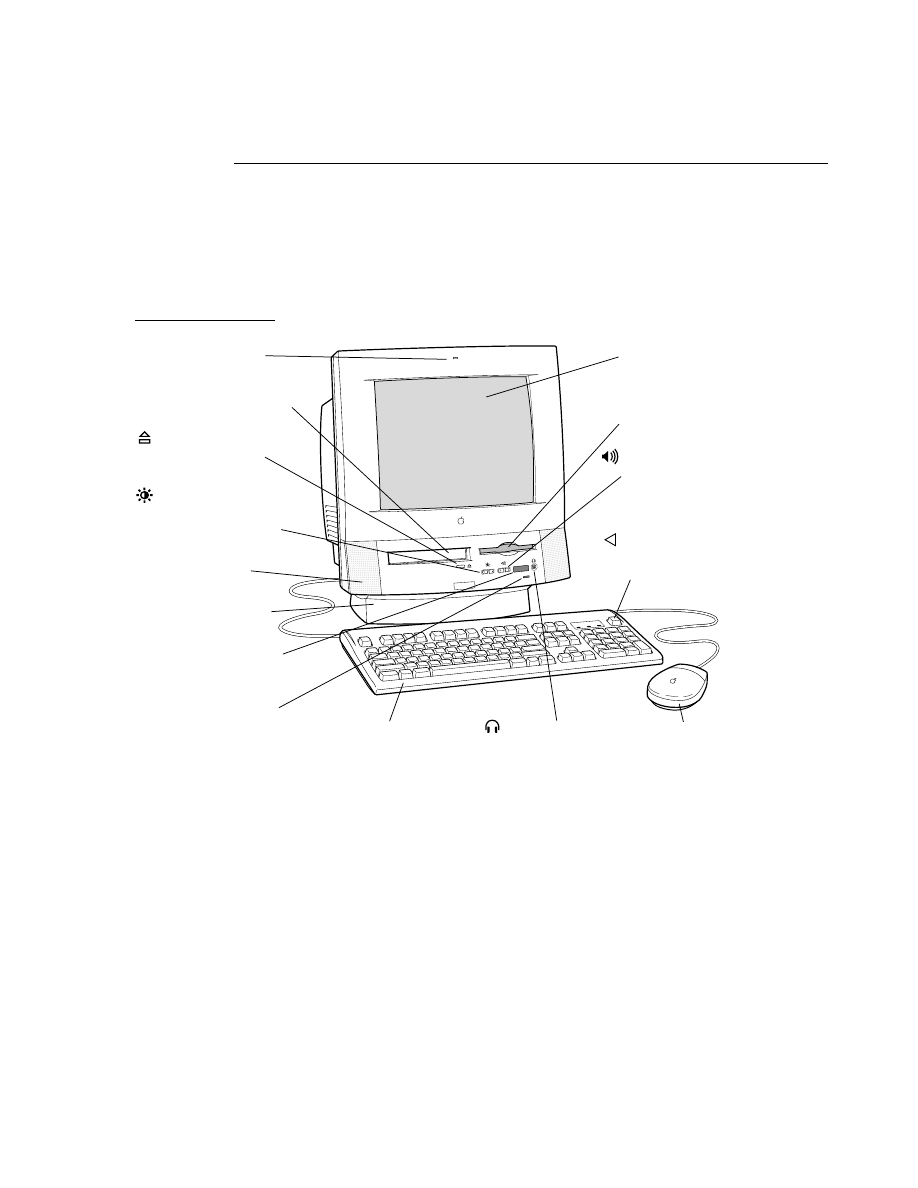
C H A P T E R 1
Introduction to the Power Macintosh 5260 Computer
External Features
5
Front View
1
Figure 1-1 is a front view of the Power Macintosh 5260 computer. The front view shows
the display screen, the built-in microphone and stereo speakers, the openings for the
floppy disk and optional CD-ROM drive, the CD-ROM open and close button, the
headphone jack, the power-on light, the IR sensor for the remote control, and the push
buttons that control the screen intensity (left button) and sound level (right button).
Figure 1-1
Front view of the computer
Mouse
Built-in microphone
Color display
Your built-in monitor can
display thousands of colors.
Headphone jack
Floppy disk drive
Sound control buttons
Use these buttons to
change the volume of
the computer’s sound.
Screen control buttons
Use these buttons to lighten
or darken your screen.
Keyboard
CD-ROM drive (optional)
Power-on light
A green light indicates
that the computer is on.
CD-ROM drive
Open/Close button
Power key
Use this key to turn your
computer on and off.
Stereo speakers
Tilt-and-swivel base
Remote control sensor
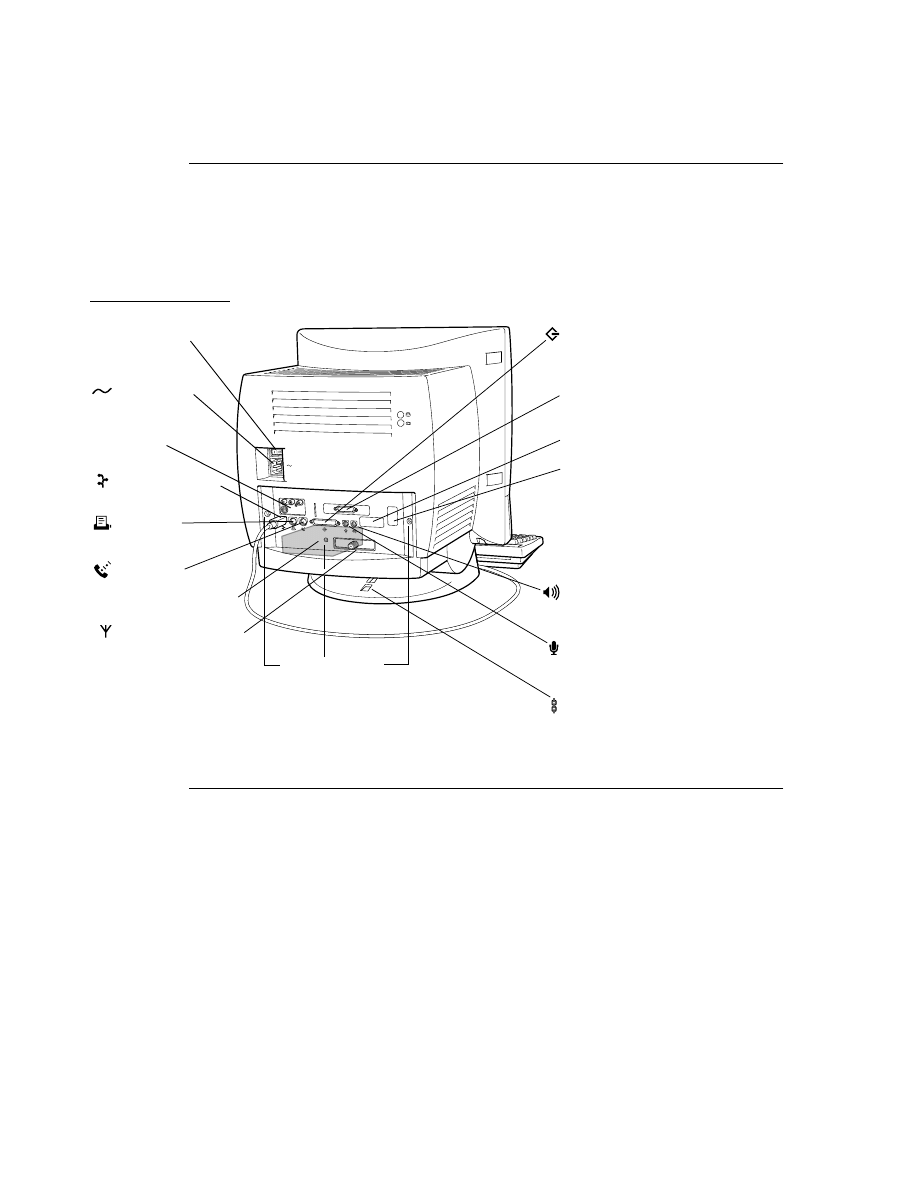
C H A P T E R 1
Introduction to the Power Macintosh 5260 Computer
6
External Features
Back View
1
Figure 1-2 shows the back panel of the computer. Features on the back panel include the
power socket, the reset button, the I/O ports, and openings for I/O access to the
expansion modules: the I/O expansion card, the communications card, and the video
input card.
Figure 1-2
Back view of the computer
Access to the Logic Board
1
The logic board can be removed from the case to allow installation of expansion RAM or
to plug in an I/O expansion card. To get access to the logic board, you must first remove
the back panel of the computer. It is secured by three screws, as shown in Figure 1-2.
After removing the screws, you can pull gently on the two latches on the underside of
the computer’s case and the back panel will slip out. You can then grasp the logic board
handle and pull the board straight out of the back of the case.
SCSI port
External video connector
(optional)
Sound output port
Sound input port
Communication card
access cover
LC-PDS card access cover
Security lock port
TV tuner card (optional)
Power switch
Power socket
Internal hard disk drive
Printer port
Modem port
Apple Desktop Bus
(ADB) port
Video input card
(optional)
Remove screws to
remove panel

C H A P T E R 1
Introduction to the Power Macintosh 5260 Computer
Optional Features
7
Power On and Off
1
You can turn the power on and off by pressing one of two buttons:
■
the Power key on the keyboard
■
the Power key on the remote control
If files are still open when you attempt to turn off the computer using either one of the
Power keys or the Shut Down menu item, the system displays an alert box warning you
that files are open and should be closed to avoid loss of data.
Optional Features
1
Several features of the Power Macintosh 5260 computer are implemented as plug-in
modules. These modules are available at the time of purchase or as a later upgrade, and
they are designed so that they can be installed by the user.
TV Tuner
1
The TV tuner module turns the computer into a television receiver, complete with
remote control. The features of the TV tuner module are similar to those of the TV tuner
in the Macintosh Quadra 630 and LC 630 computers. The TV picture is in its own
window on the desktop, and the TV signal is carried in digital YUV format for
improved picture clarity.
The TV tuner module has the following features:
■
the ability to tune 181 broadcast and cable channels (United States version)
■
a coaxial connector for TV antenna or cable input (F-type connector in United States
and Japanese versions; IEC-type connector in European versions)
■
a TV picture in a resizable and movable window
■
digital YUV format for improved clarity
■
support for closed captioning and teletext
■
software password protection
■
automatic and manual channel programming
■
single remote control for TV and for playback of audio CDs
The TV tuner module is available in versions for NTSC, PAL, and SECAM television
systems.
The default size of the window for the TV picture is 320-by-240 pixels. The user can
resize the TV window to a maximum of 640-by-480 pixels or to a minimum of 160-by-120
pixels. The resolution of the TV picture does not change as window size changes since
the image is changed to fit the area designated by changing the size not the number of
the pixels.

C H A P T E R 1
Introduction to the Power Macintosh 5260 Computer
8
Optional Features
The TV tuner module works in conjunction with the video input module, which converts
the video data into digital YUV format and stores it in the display buffer.
The TV tuner comes with a remote control device similar to the one used with the
Macintosh TV computer. The user can switch channels either by using the remote control
or by typing the channel numbers on the keyboard. The user can toggle between the
current and previous channel by pressing the Tab key on the keyboard. Each time the
channel changes, the computer displays the channel name (assigned by the user) on the
picture in the video window.
The user can customize the operation of the TV tuner by adding or removing TV
channels that are unused or unwanted. The computer can program the channels
automatically, scanning through all available channels and disabling those that do not
have a valid signal. When you scan for the next channel using the remote control or the
Tab key on the keyboard, the tuner skips the disabled channels.
The software that supports the TV tuner module is an application called Apple Video
Player. The application includes password protection for the disabled channels. Parents
might use this feature to prevent children from watching undesirable channels.
The software allows you to capture or freeze a single frame of video or record a segment
of video as a QuickTime Movie. The TV window cannot be resized while the computer is
recording a movie.
Video Input
1
The video input card accepts video from an external source and displays it in a window
on the computer’s display. The following are features of the video input card:
■
accepts video input in NTSC, PAL, or SECAM format
■
connectors for stereo sound, composite video, and S-video (Y/C)
■
video display in a 320-by-240-pixel window
■
pixel doubling for 640-by-480-pixel maximum display
■
video overlay capability
■
YUV format for digital video input
■
a digital video connector for adding a video processor on an expansion card
The video input card provides AV features similar to those of the Macintosh
Quadra 660
AV
, with one important improvement. Whereas the Macintosh Quadra 660
AV
digitizes color video using a 16-bit RGB format, the video input card uses a digital YUV
format. Because a standard television signal has more information in its chrominance
channel than in its luminance channels, digitizing the video signal as YUV format
results in a clearer picture.
The video input card can accept video input from either an external device such as a
VCR or camcorder or from the internal TV tuner module. The external device can be
connected to the video input card either through the composite video connector or the
S-video connector.

C H A P T E R 1
Introduction to the Power Macintosh 5260 Computer
Optional Features
9
The default window size is 320-by-240 pixels; you can resize the window up to
640-by-480 pixels—the full screen on a 14-inch monitor. The large image uses pixel
doubling of the 320-by-240 pixel image.
The video input card plugs into a dedicated slot on the main logic board. The slot
connector is a 60-pin microchannel connector. The module fits only its proper slot and
only in the proper orientation so that you can safely install the video input card.
The video input card has a separate connector called the DVA (digital video application)
connector. The DVA connector makes the digitized video data available to a card in the
I/O expansion slot. Such a card can contain a hardware video compressor or other video
processor. For more information, see the section “DVA Connector” beginning on page 54.
Video Display Mirror Out
1
The Power Macintosh 5260 computer supports a feature called video display mirror
output that allows a second monitor to be connected to the computer through a video
buffer card. The video buffer card plugs into a 22-pin connector on the computer’s main
logic board.
In the video display mirror-out mode, the image on the second monitor’s screen is the
same as that on the screen of the built-in monitor. This mode of operation is appropriate
for presentations, allowing the audience and the presenter to see the same images.
IMPORTANT
Apple Computer does not provide support for third-party developers of
video buffer cards.
▲
Communications Slot
1
The main logic board in the Power Macintosh 5260 computer has a communications slot
that is compatible with the communications slot first introduced in the Macintosh LC 575
computer and later used in the Macintosh LC 630 and Macintosh Quadra 630 computers.
The slot allows the computer to support a communications module without occupying
the expansion slot. A communications module can be installed by either the user or the
dealer.
The communications slot in the Power Macintosh 5260 computer supports all
communications cards developed for the Macintosh LC 575, Macintosh LC 630, and
Macintosh Quadra 630, including
■
the 10BaseT (twisted pair) Ethernet card
■
the 10Base2 (thin coax) Ethernet card
■
the AAUI (Apple standard) Ethernet card
■
the 14.4 fax/data modem card

C H A P T E R 1
Introduction to the Power Macintosh 5260 Computer
10
Compatibility Issues
IMPORTANT
Apple Computer does not provide support for third-party developers of
communications cards.
▲
Compatibility Issues
1
The Power Macintosh 5260 computer is different from earlier desktop models in several
ways. This section describes key issues you should be aware of to ensure that your
hardware and software work properly with this new model. Some of the topics
described here are covered in more detail in later parts of this developer note.
Microprocessor Differences
1
Certain differences between the PowerPC 603e and the PowerPC 601 microprocessors
can affect the way code is executed. Because of these differences, programs that execute
correctly on the PowerPC 601 microprocessor may cause compatibility and performance
problems on the PowerPC 603e microprocessor. Critical differences are described in the
next four sections.
POWER-Clean Code
1
First generation Power Macintosh computers used the PowerPC 601 microprocessor,
which bridged the new PowerPC architecture with the POWER architecture from which
it descended. The PowerPC 601 implemented most of the old POWER instruction set as
well as the newer PowerPC instruction set.
Later versions of the microprocessor, namely the PowerPC 603, 603e, and 604, implement
only the PowerPC instruction set, hence the term “power clean.” Because of the
differences in instruction set implementation, there may be incompatibility and poor
performance, particularly in the area of compilers.
Newer compilers, designed for the PowerPC instruction set, do not generate the old
POWER instructions. However, compilers designed for the POWER instruction set are
also being used to compile programs for the PowerPC instruction set. Most of those
compilers have the option to suppress the generation of offending instructions. For
example, the IBM xLc C compiler and the xLCC++ compiler have the option
-garch=ppc.
Developers using these compilers should verify that the options are in
effect for all parts of their code. To be on the safe side, you should contact your compiler
vendor to make sure that the compiler you are using does not generate POWER
instructions.
Completion Serialized Instructions
1
Several types of instructions can interfere with instruction pipelining and degrade
system performance. Most noticeable are completion serialized instructions such as load
and store string and load and store multiple. These instructions are referred to as

C H A P T E R 1
Introduction to the Power Macintosh 5260 Computer
Compatibility Issues
11
completion serialized instructions because they cannot be executed until all prior
instructions have been completed.
Representatives of Apple Computer, Inc. are working with compiler developers to
establish guidelines for the appropriate use of these instructions.
Split Cache
1
Unlike the PowerPC 601, which has a unified cache, the PowerPC 603e has separate
caches for instructions and data. This can lead to cache coherency problems in
applications that mix code and data.
In the Mac OS, the Code Fragment Manager loads almost all native code to ensure that
the code is suitable for execution. If your code is loaded by the Code Fragment Manager,
you do not have to worry about cache coherency.
If, however, your application generates code in memory for execution, problems can
arise. Examples include compilers that generate code for immediate execution and
interpreters that translate code in memory for execution. For such cases, you can use the
MakeDataExecutable
function to notify the Mac OS that data is subject to execution.
This call is defined in OSUtils.h.
Data Alignment
1
In PowerPC systems, data is normally aligned on 32-bit boundaries, whereas data for the
680x0 is typically aligned on 16-bit boundaries. Even though the PowerPC microprocessor
was designed to support the 680x0 type of data alignment, misaligned data can cause
some deterioration in performance. Furthermore, performance with misaligned data
varies across the different implementations of the PowerPC microprocessor.
While it is essential to use 16-bit alignment for data that is being shared with 680x0 code,
you should use PowerPC alignment for all other kinds of data. In particular, you should
not use global 680x0 alignment when compiling your PowerPC applications; instead use
alignment pragmas
to turn on 680x0 alignment only when necessary.
Expansion Slot
1
The I/O expansion slot in the Power Macintosh 5260 computer is compatible with the
PDS (processor-direct slot) in the Macintosh LC family of computers, but it is not a true
PDS. Like the expansion slot in the Macintosh LC 630 and Macintosh Quadra 630
computers, the I/O expansion slot in the Power Macintosh 5260 computer supports
many PDS cards designed to operate with the MC68030 bus, including both bus masters,
such as Apple Computer’s Ethernet expansion card, and bus slaves, such as display
cards.
While the I/O expansion slot accepts PDS cards designed for the Macintosh LC family of
computers, some of those cards do not work. Cards that are incompatible with the
I/O expansion slot include the following:
■
Cards such as accelerators, 68882 FPU cards, and cache cards that are designed to
work as coprocessors with an MC68020 or an MC68030, or to replace these

C H A P T E R 1
Introduction to the Power Macintosh 5260 Computer
12
Compatibility Issues
microprocessors. This type of card will not work because the microprocessor is
different and because the slot signals are not connected directly to the microprocessor.
■
Cards with drivers that include incompatible code. Some drivers that do not follow
Apple Computer’s programming guidelines will not work on machines that use the
PowerPC 603e microprocessor. For example, some of those drivers write directly to
the cache control register in an MC68030. Such code will not work on a PowerPC 603e
microprocessor.
■
Cards with drivers that include code to check the
gestaltMachineType
value and
refuse to run on a newer CPU. However, this is an advantage, since such cards refuse
to run on machines on which they have not been tested.
IDE Hard Disk
1
The internal hard disk in the Power Macintosh 5260 computer is an IDE drive, not a SCSI
drive. This could cause compatibility problems for hard disk utility programs.

C H A P T E R 2
Architecture
2
Figure 2-0
Listing 2-0
Table 2-0

C H A P T E R 2
Architecture
14
Block Diagram and Main ICs
This chapter describes the architecture of the Power Macintosh 5260 computer, including
the major components of the main logic board, such as the microprocessor, custom ICs,
and the display RAM. The chapter also provides a simplified address map.
Block Diagram and Main ICs
2
The architecture of the Power Macintosh 5260 computer is based on three generations of
microprocessors: the MC68020/030, the MC68040, and the new PowerPC 603e. Figure
2-1 shows the system block diagram.
The internal bus structure consists of three internal buses: the 64-bit wide 603e data bus,
the 32-bit wide 68040 bus, and the 32-bit wide I/O bus. The 603e bus is connected
directly to the main processor and runs at the same clock rate. An optional external
256 KB L2 cache and 4 MB of ROM attach directly to the 603e data bus and help to
optimize system performance.
The Capella custom IC provides the bus translation logic that bridges the 603e processor
and the 68040-based custom ICs. It translates the 64-bit data from the 603e data bus into
32-bit data required by the 68040 bus and provides the necessary signals to maintain
68040 protocol. Three custom ICs, F108, Valkyrie, and PrimeTime III, connect directly to
the 68040 bus. The F108 custom IC provides memory control and bus arbitration logic,
the Valkyrie custom IC is the graphics display controller, and the PrimeTime III custom
IC controls most of the I/O functions.
The I/O bus is a 32-bit wide buffered bus that runs at 16 MHz and supports 68030 byte
steering and dynamic bus sizing. Although it is derived from the 68040 bus, it behaves
more like the 68030 interface to support the 68020 and 68030 expansion cards that were
designed for use in the Macintosh LC family of computers. The PrimeTime III custom IC
buffers the data portion of the I/O bus and provides a compatible interface for I/O
devices and software designed for use with the MC68030 miroprocessor.
Microprocessor
2
The Power Macintosh 5260 computer uses a PowerPC 603e microprocessor running at
100 MHz. The principle features of the PowerPC 603e microprocessor include
■
full RISC processing architecture
■
parallel processing units: two integer and one floating-point
■
a branch manager that can usually implement branches by reloading the incoming
instruction queue without using any processing time
■
an internal memory management unit (MMU)
■
dual 16 KB on-chip caches (16 KB each for data and instructions)
For complete technical details, see the Motorola/IBM PowerPC 603e RISC Microprocessor
User’s Manual.
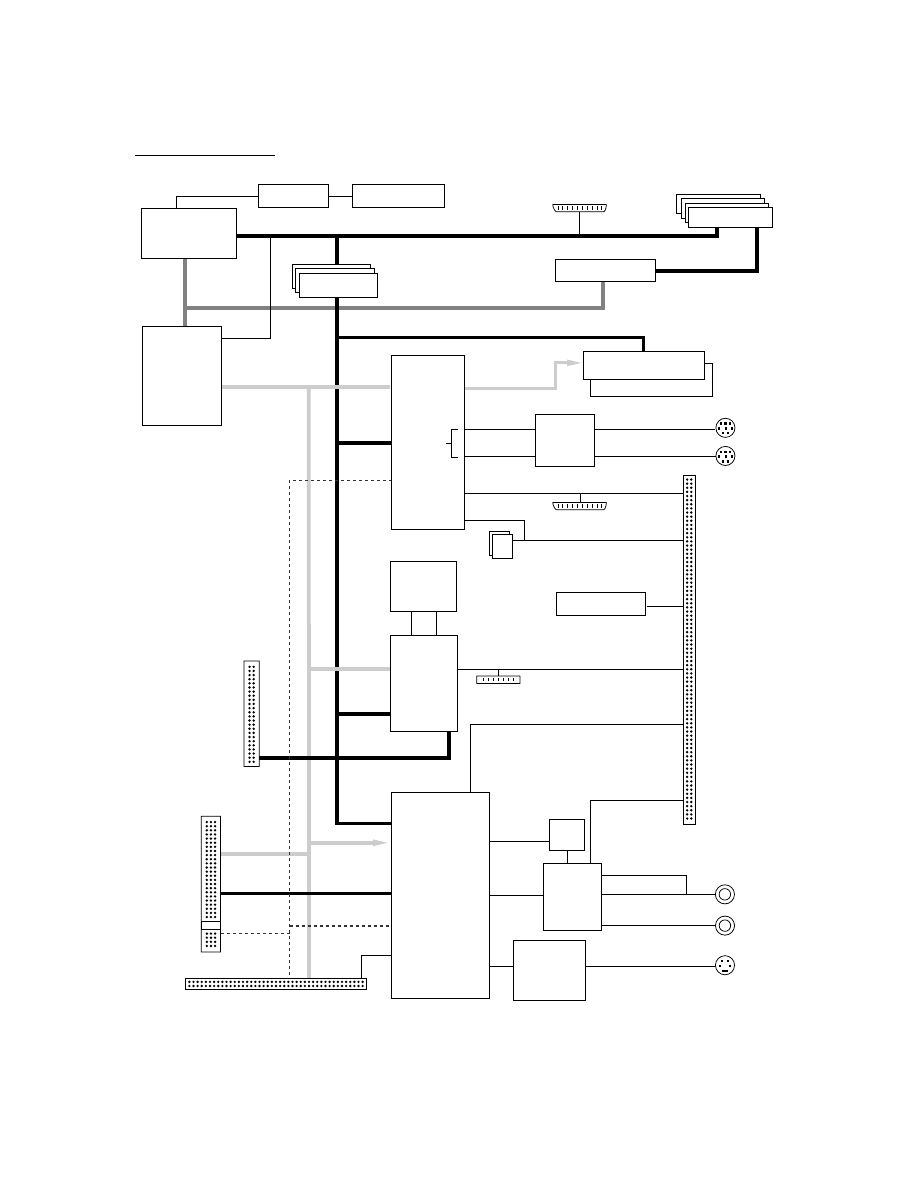
C H A P T E R 2
Architecture
Block Diagram and Main ICs
15
Figure 2-1
System block diagram
PDS slot
68040 address bus
(31:0)
68040 address bus
ADB port
68040 Data bus (31:0)
Microphone
Sound
out jack
Serial
ports
Data
(31:0)
Address
(31:0)
DMD31–0
DMA8–0
Bridge IC
(Capella)
DRAM
0-32 MB SIMMs
DFAC II
Address
(31:0)
IO data
(31:0)
Communications slot
Drivers
and
receivers
D/A
Port A (modem)
Port B (printer)
SCSI CD
245 Buffer
IDE hard disk
Frame
buffer
1M DRAM
Valkyrie
DRAM
frame
buffer
controller
Video port
Video bus
Video-in
slot
F108
Memory
controller
bus
arbitrator
SCC
SCSI
IDE
IO address
(1:0)
PrimeTime III
SWIM II floppy
disk controller
VIA1/VIA2
interrupts, device
selects, timer
Sound
controller
I/O bus adapter
Right channel
PC connector
Left channel
Sound input
Serial in
Serial out
TV tuner board
SCSI connector
Cuda
ADB
real-time
clock/PRAM
Video mirror
connector
Data latches
4 MB burst ROM
Transparent latch
PC address bus (63:0)
PC address bus (31:0)
Optional L2 cache
Latched address
(21:5)
Clock driver
Clock generator
PowerPC 603e
100MHz
microprocessor
PCI connector
Valkyrie

C H A P T E R 2
Architecture
16
Block Diagram and Main ICs
Second-Level Cache and ROM
2
The memory subsystem of the Power Macintosh 5260 computer consists of a 4 MB ROM
and a 256 KB second-level (L2) cache, in addition to the internal cache memory of the
PowerPC 603e microprocessor. The L2 cache is contained on the 160-pin cache DIMM
card that plugs into the main logic board. The Capella custom IC provides burst mode
control to the cache and ROM.
IMPORTANT
Apple Computer does not provide support for third-party developers of
L2 cache cards.
▲
System RAM
2
The Power Macintosh 5260 computer uses two 72-pin SIMM sockets for memory
expansion. The computer is shipped with 8 MB installed in one of the SIMM sockets and
can be expanded to 64 MB. No soldered on-board memory is provided. The SIMM
sockets support both single- and double-sided DRAM modules. Using 4 Mbit devices,
each SIMM can be configured as 4 MB or 8 MB providing RAM expansion up to 16 MB.
Using 16 Mbit devices, you can configure each SIMM as 16 MB or 32 MB providing RAM
expansion up to 64 MB. The F108 custom IC provides memory control for the system
RAM. Refer to “DRAM Expansion” on page 40 for further information.
Custom ICs
2
The architecture of the Power Macintosh 5260 computer is designed around six large
custom integrated circuits:
■
the Capella bus translation IC
■
the F108 memory controller and I/O support IC
■
the PrimeTime III I/O subsystem and buffer
■
the DFAC II sound input processor
■
the Cuda ADB controller
■
the Valkyrie video CLUT and DAC
The computer also uses several standard ICs that are used in other Macintosh
computers. This section describes only the custom ICs.
Capella IC
2
The Capella IC functions as the bridge between the PowerPC 603e microprocessor and
the 68040 based circuits. It translates 64-bit data from the 603e data bus into 32-bit data
for the 68040 bus and synchronizes arbitration between the two buses. The Capella IC
supports all combinations of 603e bus translation sizes and data alignment and provides
appropriate control signals for the 68040 bus. In addition, the Capella IC includes
registers that control the system ROM and the optional L2 cache.

C H A P T E R 2
Architecture
Block Diagram and Main ICs
17
F108 IC
2
The F108 IC performs the system memory control functions. It also includes circuitry
equivalent to SCC and SCSI controller ICs. The functional blocks in the F108 include the
following:
■
control logic for the system ROM and DRAM
■
SCSI controller
■
SCC serial I/O controller
■
IDE hard disk interface controller
The F108 IC is attached to the system 68040 bus and provides the control and timing
signals for the system ROM and RAM. The memory control logic supports byte, word,
longword, and line accesses to the system memory. If an access is not aligned to the
appropriate address boundary, that access requires multiple data transfers on the bus.
Note
The memory control logic in the F108 IC is the same as that in the F108
IC used in the Power Macintosh, Quadra 630, and LC 630.
◆
The SCSI controller in the F108 IC is just like an NCR 53C96. The PrimeTime III IC
provides the interface to the SCSI controller and also provides longword accumulation of
SCSI data for better performance. In the Power Macintosh 5260 computer, the clock
signal to the SCSI controller is 20 MHz.
The SCC circuitry in the F108 IC is an 8-bit device just like the 8530 SCC. The PCLK
signal to the SCC is an 8 MHz clock.
PrimeTime III IC
2
The PrimeTime III IC supports the I/O bus and functions as the bridge between the
68040 bus and the I/O bus. It combines functions performed by several ICs in previous
Macintosh designs. The PrimeTime III IC includes
■
data bus buffers for the internal I/O bus
■
address decoding for I/O devices
■
dynamic bus sizing and data routing for the I/O bus
■
interface adapters VIA1 and VIA2
■
interrupt controls
■
a SWIM II floppy disk controller
■
sound control logic and buffers
The PrimeTime III IC provides data bus features such as byte steering, which allows 8-bit
and 16-bit devices to be connected to a fixed byte lane, and dynamic bus sizing, which
allows software to read and write longwords to 8-bit and 16-bit devices. These features
allow the computer to work with existing I/O software designed for the MC68030 and
MC68040.

C H A P T E R 2
Architecture
18
Block Diagram and Main ICs
The PrimeTime III IC also contains the sound control logic and the sound input and
output buffers. There are three separate buffers—one for sound input and two for stereo
sound output. This means the computer can record sound input and process sound
output at the same time.
DFAC II IC
2
The DFAC II custom IC is a digital filter audio chip that contains the sound input
processing devices. The DFAC II includes
■
input AGC (automatic gain control) comparators
■
anti-alias filtering
■
an A/D (analog-to-digital) converter for input
■
a PWM (pulse-width modulation) converter for output
The DFAC II IC does not include the sound control logic and the input and output
buffers; these are part of the PrimeTime III IC.
For sound input, the DFAC II processes the signal from the sound input jack through a
sound input amplifier with automatic gain control, an input filter, an A/D converter, and
the necessary switching circuits. The DFAC II sends the resulting stream of digital sound
data to the PrimeTime III, which stores the data in its input buffer.
For sound output, circuits in the DFAC II take data from the sound output buffers and
generate stereo PWM signals. The DFAC II merges the sound playthrough signal with
the PWM signals and sends the combined signals to an external stereo PWM converter
IC. After low-pass filtering in the PWM converter, the signals go to the sound output
jacks and to a separate amplifier for the built-in speaker. See the section “Sound”
beginning on page 32 for further information.
Cuda IC
2
The Cuda IC is a custom version of the Motorola MC68HC05 microcontroller. It provides
several system functions, including
■
the ADB interface
■
parameter RAM
■
the real-time clock
■
program control of the power supply (soft power)
■
the programming interface to devices on the IIC (inter-integrated circuit) bus
The devices on the IIC bus include the DFAC II sound IC, the digital video decoder and
scaler (DESC) on the video input module, and the Cyclops IC, which is the controller for
the remote control receiver. The computer reads and writes status and control
information to these devices by commands to the Cuda IC.

C H A P T E R 2
Architecture
Block Diagram and Main ICs
19
Valkyrie IC
2
The Valkyrie IC is a custom IC containing the logic for the video display. It includes the
following functions:
■
display memory controller
■
video CLUT (color lookup table)
■
video DAC (digital-to-analog converter)
A separate data bus handles data transfers between the Valkyrie IC and the display
memory. The display memory data bus is 32 bits wide, and all data is transfered 32 bits
at a time. The Valkyrie IC breaks each 32-bit data transfer into several pixels of the
appropriate size for the current display mode—4, 8, or 16 bits per pixel. The Valkyrie IC
does not support 24 bits per pixel.
To keep up with the large amount of data that must be transferred into and out of the
display memory, the Valkyrie IC has several internal buffers. Besides input and output
buffers for display data, the Valkyrie IC also has a buffer for both addresses and data
being sent from the main processor to the display. That buffer can hold up to four
transactions, allowing the main processor to complete a write instruction to the display
memory and continue processing without waiting for some other transaction that might
be taking place on the display memory bus.
The CLUT in the Valkyrie custom IC provides color palettes for 4-bit and 8-bit display
modes. In 16-bit display mode, the CLUT is used to provide gamma correction for the
stored color values. With a black-and-white or monochrome display mode, all three color
components (R, G, and B) are the same.
The Valkyrie IC uses several clocks. Its transactions with the CPU are synchronized
to the CPU_BCLK signal. Data transfers from the frame-buffer DRAM are clocked by
the MEM_CLK signal, which runs at 60 MHz. Data transfers to the CLUT and the
video output are clocked by the dot clock, which has a different rate for different
display monitors.
For more information about the interaction between the Valkyrie IC, the display
memory, and the main processor, see the section “Display RAM” later in this chapter.
Bus Arbitration
2
The system bus can support two bus masters, including the main processor and one I/O
bus master. The I/O master has higher priority. Either bus master can park on the bus as
long as no higher priority master requests the bus.
The bus request from the I/O bus master is initiated by the PrimeTime III IC and comes
from one of two sources: the PDS expansion card or the communications card. Devices
on these cards are not connected directly to the system bus; they arbitrate the bus by way
of the I/O bus and the PrimeTime III IC. See the section “Bus Master on a Card”
beginning on page 52.

C H A P T E R 2
Architecture
20
Address Map
The Capella IC synchronizes the bus arbitration between the 603e bus and the 68040 bus.
The PowerPC 603e microprocessor is the default bus master. The Capella IC gains access
to the 68040 bus when the I/O master is granted to the bus. The PowerPC 603e micro-
processor continues to execute instructions from the ROM and the L2 cache during bus
arbitration, thus improving system performance.
Display RAM
2
The display memory in the Power Macintosh 5260 computer is separate from the main
memory. To reduce the cost of the computer, the display memory is implemented with
DRAM devices instead of more expensive VRAM devices. The display memory consists
of 1 MB of 60 ns DRAM devices configured to make a 32-bit data bus. The display
memory cannot be expanded.
The display memory contains three separate frame buffers. The first frame buffer holds
the graphics data—the display that is generated by the computer. The other two frame
buffers hold video data from the video input module. The video data frame buffers are
used alternately: while one is supplying data to be sent to the video monitor, the other is
receiving the next frame of video input.
The display data generated by the computer can have pixel depths of 4, 8, or 16 bits for
monitors up to 64-by-480 pixels. Data from the video input module is always stored and
transferred at 16 bits per pixel. The video frame buffers support live video in a
320-by-240-pixel frame at 30 frames per second.
The Power Macintosh 5260 computer can display video in a window inside the
computer graphics display. The Valkyrie IC has registers that contain the starting
location of the video window within the display, the starting address of the video data in
the video buffer, and the size of the video window.
Address Map
2
The Power Macintosh 5260 computer supports only 32-bit addressing. Figure 2-2 on
page 22 shows a simplified address map. Address mapping changes after the M7 bit in
the Capella bus translation unit has been set.
Note
You should not use actual hardware addresses in applications; you
should always communicate with hardware devices by means of system
software.
◆
Note
Because the Power Macintosh 5260 computer operates only in 32-bit
addressing mode, it does not support the Apple IIe Card for the
Macintosh LC.
◆

C H A P T E R 2
Architecture
Address Map
21
RAM Addresses
2
The first gigabyte of address space is reserved for RAM. The actual amount of RAM
installed can be from 8 MB to 64 MB. At startup time, a routine in the ROM determines
the amount of RAM available and stores the size in a low-memory global variable.
Addresses for PDS Expansion Cards
2
The PDS expansion card uses address space from $FE00 0000 to $FF00 0000,
corresponding to NuBus
™
slot $E, and from $E000 0000 to $EFFF FFFF, corresponding to
NuBus Super Slot $E. For more information, see the section “Card Address Space” on
page 53.
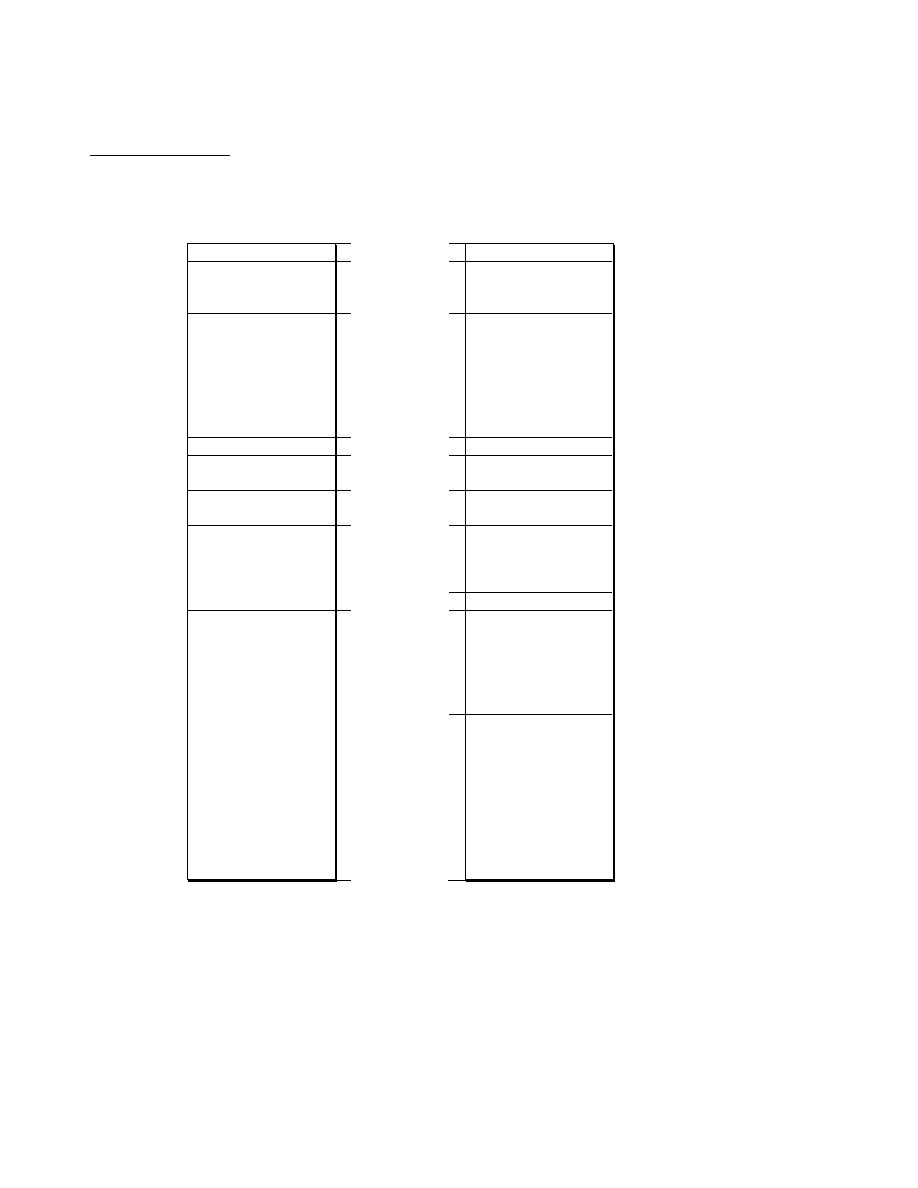
C H A P T E R 2
Architecture
22
Address Map
Figure 2-2
Simplified address map
Map at power up
(before access to
$4080 0000–$4FFF FFFF
and M7 bit set)
603e ROM image
Expansion I/O space
I/O device
040 ROM space
Duplicate images of
040 ROM
NuBus slot space
PDS
NuBus super slot space
PDS
on-board video
Normal map
(after access to
$4080 0000–$4FFF FFFF
and M7 bit set)
603e ROM image
Expansion I/O space
I/O device
Disabled 040 ROM space
RAM space 64 MB
603e ROM image
NuBus slot space
PDS
NuBus super slot space
PDS
on-board video
$10000 0000
$FF00 0000
$FE00 0000
$6000 0000
$5200 0000
$5000 0000
$4FFF FFFF
$4100 0000
$4000 0000
$0400 0000
$0000 0000

C H A P T E R 3
I/O Features
3
Figure 3-0
Listing 3-0
Table 3-0

C H A P T E R 3
I/O Features
24
Serial I/O Ports
This chapter describes both the built-in I/O devices and the interfaces for external I/O
devices. It also describes the external video monitor that can be used with the Power
Macintosh 5260 computer.
Serial I/O Ports
3
The Power Macintosh 5260 computer has two serial ports, one for a printer and one for a
modem. Both serial ports have 9-pin mini-DIN sockets that accept either 8-pin or 9-pin
plugs. Figure 3-1 shows the mechanical arrangement of the pins on the serial port
sockets. Table 3-1 shows the signal assignments.
Figure 3-1
Serial port sockets
Table 3-1
Serial port signals
Pin
number
Signal name
Signal description
1
HSKo
Handshake output
2
HSKi
Handshake input
3
/TXD
Transmit data –
4
GND
Signal ground
5
/RXD
Receive data –
6
TXD
Transmit data +
7
GPi
General-purpose input
8
RXD
Receive data +
9
+5VDC
+5 volts
Printer
Modem
8
7
1
5
4
2
3
9
6
8
7
1
5
4
2
3
9
6

C H A P T E R 3
I/O Features
ADB Port
25
Pin 9 on each serial connector provides +5 V power from the ADB power supply.
IMPORTANT
An external device should draw no more than 100 mA from pin 9. The
total current available for all devices connected to the +5 V supply for
the ADB and the serial ports is 300 mA. Excessive current drain will
cause a fuse to interrupt the +5 V supply. The fuse automatically resets
when the load returns to normal.
▲
Both serial ports include the GPi (general-purpose input) signal on pin 7. The GPi signal
for each port connects to the corresponding data carrier detect input on the SCC portion
of the F108 custom IC, described in Chapter 2. On serial port A (the modem port), the
GPi line can be connected to the receive/transmit clock (RTxCA) signal on the SCC. That
connection supports devices that provide separate transmit and receive data clocks, such
as synchronous modems. For more information about the serial ports, see Guide to the
Macintosh Family Hardware, second edition.
ADB Port
3
The Apple Desktop Bus (ADB) port on the Power Macintosh 5260 computer is
functionally the same as on other Macintosh computers.
The ADB is a single-master, multiple-slave, serial communications bus that uses an
asynchronous protocol and connects keyboards, graphics tablets, mouse devices, and
other devices to the computer. The custom ADB microcontroller drives the bus and reads
status from the selected external device. A 4-pin mini-DIN connector connects the ADB
to the external devices. Table 3-2 lists the ADB connector pin assignments. For more
information about the ADB, see Guide to the Macintosh Family Hardware, second edition.
Table 3-2
ADB connector pin assignments
Pin
number
Name
Signal description
1
ADB
Bidirectional data bus used for input and output. It is an
open-collector signal pulled up to +5 volts through a 470-ohm
resistor on the main logic board.
2
PFW
Power-on signal that generates reset and interrupt key
combinations.
3
+5 V
+5 volts from the computer.
4
GND
Ground from the computer.

C H A P T E R 3
I/O Features
26
Floppy Disk Drive
IMPORTANT
The total current available for all devices connected to the +5V pins on
the ADB and the modem port is 300 mA. Each device should use no
more than 100 mA.
▲
Floppy Disk Drive
3
The Power Macintosh 5260 computer has one internal high-density floppy disk drive
(Apple SuperDrive). The drive is connected to a 20-pin connector on a cable that is
connected to the main logic board by the internal chassis connector. Table 3-3 shows the
pin assignments on the floppy disk connector. A slash (/) before a signal name indicates
an active-low signal.
Table 3-3
Pin assignments on the floppy disk connector
Pin
number
Signal name
Signal description
1
GND
Ground
2
PH0
Phase 0: state control line
3
GND
Ground
4
PH1
Phase 1: state control line
5
GND
Ground
6
PH2
Phase 2: state control line
7
GND
Ground
8
PH3
Phase 3: register write strobe
9
n.c.
Not connected
10
/WRREQ
Write data request
11
+5V
+5 volts
12
SEL
Head select
13
+12V
+12 volts
14
/ENBL
Drive enable
15
+12V
+12 volts
16
RD
Read data
17
+12V
+12 volts
18
WR
Write data
19
+12V
+12 volts
20
n.c.
Not connected

C H A P T E R 3
I/O Features
IDE Hard Disk
27
IDE Hard Disk
3
The Power Macintosh 5260 computer has an internal hard disk that uses the standard
IDE interface. This interface, used for IDE drives on IBM AT–compatible computers, is
also referred to as the ATA interface. The implementation of the ATA interface on the
Power Macintosh 5260 computer is a subset of the ATA interface specification, ANSI
proposal X3T9.2/90-143, Revision 3.1.
Hard Disk Specifications
3
Figure 3-2 on page 28 shows the maximum dimensions of the hard disk and the location
of the mounting holes. As the figure shows, the minimum clearance between conductive
components and the bottom of the mounting envelope is 0.5 mm.
Hard Disk Connectors
3
The internal hard disk has a standard 40-pin IDE connector and a separate 4-pin power
connector. The 40-pin connector cable is part of the cable harness attached to the main
logic board by the internal chassis connector. The power cable is attached directly to the
power supply.
The exact locations of the IDE connector and the power connector are not specified, but
the relative positions must be as shown in Figure 3-2 on page 28 so that the cables and
connectors will fit.
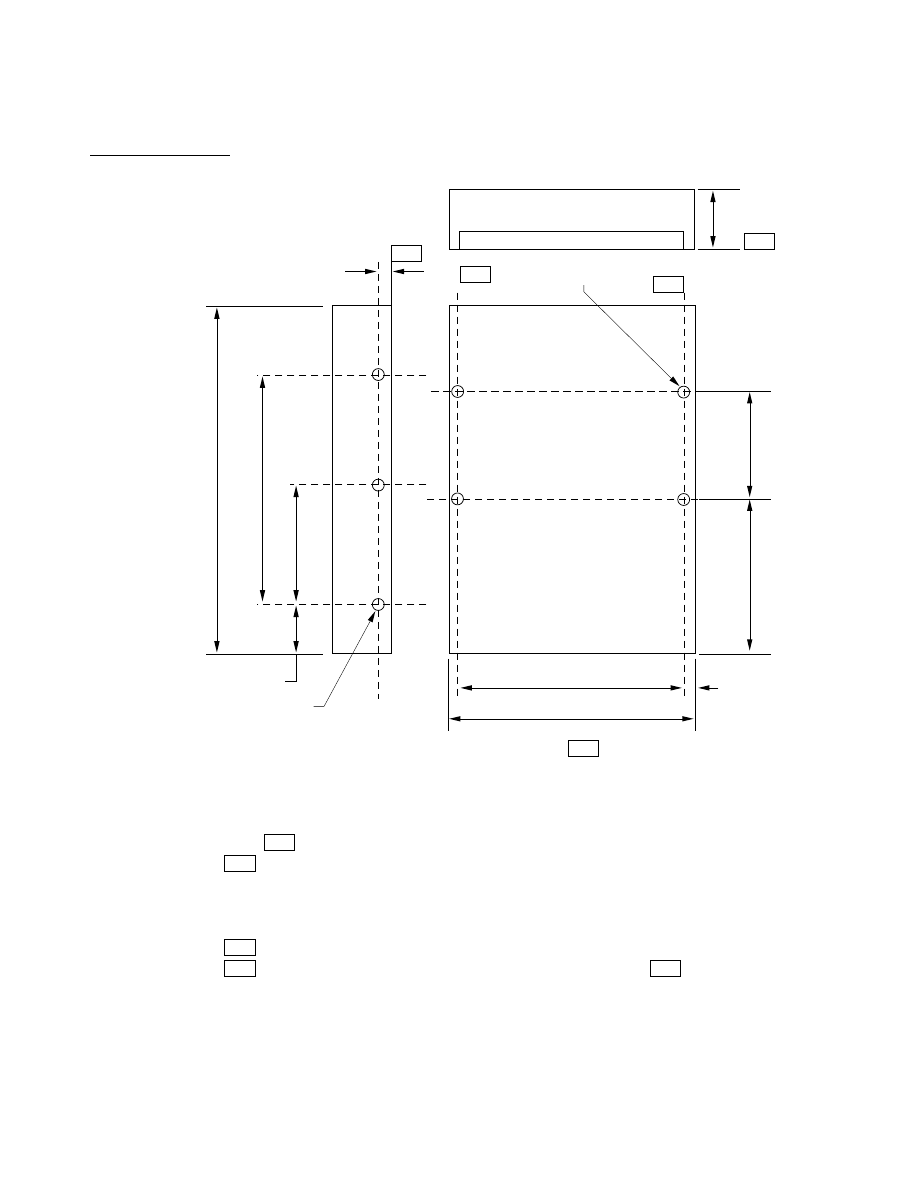
C H A P T E R 3
I/O Features
28
IDE Hard Disk
Figure 3-2
Maximum dimensions of the hard disk
6.40 (.252)2x
3
IDE connector
Power
Mounting hole 6-32, .22"
min. full thread, 4X
A
B
A
7
101.6 (4.00)
95.25 (3.75)
3.20 (.125) 2
60.30 (2.37)
44.40 (1.75)
60.00 (2.36) 2x
101.6 (4.00) 2x
146.0 (5.75)
25.4 (1.00)
16.00 (.63) 2x
Mounting hole
6-32, through 6x
Notes:
1
2
3
4
5
6
7
8
A Defined by plane of bottom mount holes
B Defined by center line of bottom mount holes
40-pin IDE and 4-pin power connector placement must not be reversed
All dimensions in MM (inch)
Drawing not to scale
Tolerances .X = +
0.50, .XX = +
0.25
Dimension to be measured at center line of side-mount holes
Minimum 0.5 MM clearance from any conductive PCB components to A
–
–

C H A P T E R 3
I/O Features
IDE Hard Disk
29
Pin Assignments and Signal Descriptions
3
Table 3-4 shows the pin assignments on the 40-pin IDE hard disk connector. A slash (/)
before a signal name indicates an active-low signal. Table 3-5 on page 30 describes the
functions of the signals.
Note
The IDE data bus is connected to the I/O bus through bidirectional bus
buffers. To match the big-endian format of the MC68030-compatible bus,
the bytes are swapped. The lower byte of the IDE data bus, DD(0–7), is
connected to the high byte of the upper word of the I/O bus, IOD(24–31).
The higher byte of the IDE data bus, DD(8–15), is connected to the low
byte of the upper word of the I/O bus, IOD(16–23).
◆
Table 3-4
Pin assignments on the IDE hard disk connector
Pin
number
Signal name
Pin
number
Signal name
1
/RESET
2
GROUND
3
DD7
4
DD8
5
DD6
6
DD9
7
DD5
8
DD10
9
DD4
10
DD11
11
DD3
12
DD12
13
DD2
14
DD13
15
DD1
16
DD14
17
DD0
18
DD15
19
GROUND
20
KEY
21
Reserved
22
GROUND
23
DIOW
24
GROUND
25
DIOR
26
GROUND
27
/IORDY
28
Reserved
29
Reserved
30
GROUND
31
INTRQ
32
/IOCS16
33
DA1
34
/PDIAG
35
DA0
36
DA2
37
/CS0
38
/CS1
39
/DASP
40
GROUND

C H A P T E R 3
I/O Features
30
IDE Hard Disk
Table 3-5 describes the signals on the IDE hard disk connector. A slash (/) before a signal
name indicates an active-low signal.
Table 3-5
Signals on the IDE hard disk connector
Signal name
Signal description
DA(0–2)
IDE device address; used by the computer to select one of the registers
in the IDE drive. For more information, see the descriptions of the CS0
and CS1 signals.
DD(0–15)
IDE data bus; buffered from IOD(16–31) of the computer’s I/O bus.
DD(0–15) are used to transfer 16-bit data to and from the drive buffer.
DD(8–15) are used to transfer data to and from the internal registers of
the drive, with DD(0–7) driven high when writing.
/CS0
IDE register select signal. It is asserted (driven low) to select the
additional control and status registers on the IDE drive.
/CS1
IDE register select signal. It is asserted (driven low) to select the main
task file registers. The task file registers indicate the command, the sector
address, and the sector count.
/IORDY
IDE I/O ready; when driven low by the drive, signals the CPU to insert
wait states into the I/O read or write cycles.
/IOCS16
IDE I/O channel select; asserted low for an access to the data port. The
computer uses this signal to indicate a 16-bit data transfer.
/DIOR
IDE I/O data read strobe.
/DIOW
IDE I/O data write strobe.
INTRQ
IDE interrupt request. This active high signal is used to inform the
computer that a data transfer is requested or that a command has
terminated.
/RESET
Hardware reset to the drive; an active low signal.
Key
This pin is the key for the connector.

C H A P T E R 3
I/O Features
SCSI Bus
31
SCSI Bus
3
The Power Macintosh 5260 computer has a SCSI bus for an optional internal CD-ROM
device and one or more external SCSI devices. The CD-ROM device receives power
directly from the power supply.
SCSI Connectors
3
The SCSI connector for the internal CD-ROM drive is a 50-pin connector with the
standard SCSI pin assignments. It attaches to a cable that is connected to the main logic
board by the internal chassis connector. The external SCSI connector is a 25-pin D-type
connector with the same pin assignments as other Apple SCSI devices. Table 3-6 shows
the pin assignments on the internal and external SCSI connectors. A slash (/) before a
signal name indicates an active-low signal.
Table 3-6
Pin assignments for the SCSI connectors
Pin number
(internal 50-pin)
Pin number
(external 25-pin)
Signal name
Signal description
2
8
/DB0
Bit 0 of SCSI data bus
4
21
/DB1
Bit 1 of SCSI data bus
6
22
/DB2
Bit 2 of SCSI data bus
8
10
/DB3
Bit 3 of SCSI data bus
10
23
/DB4
Bit 4 of SCSI data bus
12
11
/DB5
Bit 5 of SCSI data bus
14
12
/DB6
Bit 6 of SCSI data bus
16
13
/DB7
Bit 7 of SCSI data bus
18
20
/DBP
Parity bit of SCSI data bus
25
–
n.c. Not
connected
26
25
TPWR
+5 V terminator power
32
17
/ATN
Attention
36
6
/BSY
Bus busy
38
5
/ACK
Handshake acknowledge
40
4
/RST
Bus reset
42
2
/MSG
Message phase
44
19
/SEL
Select

C H A P T E R 3
I/O Features
32
Sound
SCSI Bus Termination
3
The internal end of the SCSI bus is terminated by a 220/330 passive terminator. The
terminator is located on the main logic board near the portion of the internal chassis
connector that contains the signals for the internal CD-ROM drive. The internal
CD-ROM drive does not include a terminator.
Sound
3
The sound system supports 16-bit stereo sound output and monaural sound input. Like
other Macintosh computers, the Power Macintosh 5260 computer can create sounds
digitally and play the sounds through its internal speakers or send the sound signals out
through the sound output jacks. It can also record sound from several sources: the
built-in microphone, a microphone connected to the sound input jack, the video input
module, or a compact disc in the CD-ROM player.
Sound Output
3
The Power Macintosh 5260 computer has two built-in speakers and two sound output
jacks, one on the front and one on the back. Both output jacks are connected to the sound
amplifier. The jack on the front provides easy access for headphones. If you insert a plug
into either jack, the internal speakers are disconnected.
Sound output is controlled by the PrimeTime III IC. A 16-bit data stream from the
PrimeTime III IC is converted to an analog signal and level-shifted before entering the
DFAC II IC for further filtering and mixing. The DFAC II IC provides the stereo sound
output to both the internal speakers and the sound output jacks.
46
15
/C/D
Control or data
48
1
/REQ
Handshake request
50
3
/I/O
Input or output
20, 22, 24, 28,
30, 34, and
all odd pins
except pin 25
7, 9, 14, 16, 18,
and 24
GND
Ground
Table 3-6
Pin assignments for the SCSI connectors (continued)
Pin number
(internal 50-pin)
Pin number
(external 25-pin)
Signal name
Signal description

C H A P T E R 3
I/O Features
Sound
33
Sound Input
3
The Power Macintosh 5260 computer has a sound input jack on the back for connecting
an external microphone or other sound source. The sound input jack accepts a standard
1/8-inch phone plug, either monophonic or stereophonic (two signals plus ground).
The sound input jack accepts either the Apple PlainTalk line-level microphone or a pair
of line-level signals by way of a separate adapter. The internal circuitry mixes the
stereophonic signals into a monophonic signal for digitization.
IMPORTANT
The Apple PlainTalk microphone requires power from the main
computer, which it obtains by way of an extra-long, 4-conductor plug
that makes contact with a 5-volt pin inside the sound input jack.
▲
IMPORTANT
The microphone for the Macintosh LC and LC II does not work with the
Power Macintosh 5260 computer. It requires the line-level signal
provided by the Apple PlainTalk microphone.
▲
Sound Input Specifications
3
The sound input jack has the following electrical characteristics:
■
Input impedance: 100k ohms
■
Average line level: 100 mV RMS
■
Average microphone level: 70 mV RMS
■
Maximum input level: 1.8 V RMS
Routing of the Sound Signals
3
Sound input signals can be routed in two ways: they can be recorded (digitized) or
they can be sent directly to the sound outputs and speakers, bypassing the sound IC.
Table 3-7 lists the sound sources and shows how each one can be routed.
Table 3-7
Sound sources and routing
Sound source
Record
Bypass
Sound input jack
√
–
Modem
√
–
CD-ROM player
√
√
Video sound (video input module)
√
√

C H A P T E R 3
I/O Features
34
Keyboard
Digitizing Sound
3
The Power Macintosh 5260 computer digitizes and records sound as 16-bit samples. It
can use either of two sampling rates: 11k samples per second or 22k samples per second.
The sound circuits include input and output filters with switchable cutoff (–3 dB)
frequencies that correspond to the two sampling rates: 3.5 kHz cutoff for the 11k
sampling rate or 7 kHz cutoff for the 22k sampling rate.
The sound system always plays samples at the 22k sampling rate; when playing samples
recorded at the 11k sampling rate, the software writes each sample to the sound buffer
twice.
Sound Modes
3
The sound mode is selected by a call to the Sound Manager. The sound circuitry
normally operates in one of three modes.
■
Sound playback: computer-generated sound is sent to the speaker and the sound
output jacks.
■
Sound playback with playthrough: computer sound and sound input are mixed and
sent to the speaker and the sound output jacks.
■
Sound record with playthrough: input sound is recorded and also fed through to the
speaker and the sound output jacks.
When recording from a microphone, applications should reduce the playthrough volume
to prevent possible feedback from the speaker to the microphone.
The PrimeTime III IC provides separate sound buffers for input and for stereo output, so
the computer can record and send digitized sound to the sound outputs simultaneously.
Keyboard
3
The keyboard has a Power key, identified by the symbol
p
. When the you choose
Shut Down from the Special menu, the computer either shuts down or a dialog appears
asking if you really want to shut down. You can also turn off the power by pressing the
Power key .
There are no programmer’s switches, so you invoke the reset and NMI (nonmaskable
interrupt) functions by pressing Command key combinations while holding down the
Power key, as shown in Table 3-8. The Command key is identified by the symbols
ð
and
x
.
Note
You must hold down a key combination for at least 1 second to allow the
ADB microcontroller enough time to respond to the NMI or hard-reset
signal.
◆

C H A P T E R 3
I/O Features
Video
35
Note
The NMI function can always be activated from the keyboard. This is a
change from the Macintosh LC computer, where keyboard activation of
the NMI function can be disabled by the software.
◆
Video
3
The Power Macintosh 5260 computer has a built-in 14-inch multiscan monitor. It
supports a pixel display size of 640 by 480, which is set when power is applied.
Optional Video Display Mirror Output Feature
3
The Power Macintosh 5260 computer uses a feature, called video display mirror output,
to make the video information on its built-in monitor available to an external monitor.
This means that the information displayed on an external monitor is a mirror image of
that displayed on the built-in monitor. This feature is implemented by plugging an
optional video buffer board into the 22-pin Video Mirror connector on the main logic
board. The Video Mirror connector’s pin assignments are shown in Table 3-9.
The optional video buffer board includes a ribbon cable with a DB-15 connector. This
connector attaches to a large opening in the upper part of the computer’s back panel,
identified in Figure 1-2 on page 6, as the Monitor Out port. The cable from an external
video monitor plugs into this DB-15 connector to allow the external monitor to display a
mirror image of the video on the built-in monitor.
Table 3-8
Reset and NMI key combinations
Key combination
Function
Command-Power (
x
-
p
)
NMI (always active)
Control-Command-Power (Control-
x
-
p
)
Reset
Table 3-9
Video mirror connector pin assignments
Pin
Signal name
Signal description
1
VID GND
Video ground
2
RED
Red signal
3
GREEN
Green signal
4
VID GND
Video ground
5
VID GND
Video ground
6
BLUE
Blue signal
7
CSYNC
C sync

C H A P T E R 3
I/O Features
36
Video
External Video Monitors
3
The computer can work with several sizes of external video monitors, however, you can
connect an external monitor to the Power Macintosh 5260 only if the optional video
display mirror out feature is used on that computer, and then it can only display the
same video as the internal monitor. Table 3-10 shows the monitor types supported and
the maximum pixel depths available. The pixel depth determines the maximum number
of colors that can be displayed.
8
VSYNC
Vertical sync
9
MLB.SYNC.EN.L
Not used (reserved)
10
HSYNC
Horizontal sync
11
DAC.ISET.1
Not used (reserved)
12
DAC.ISET.2
Not used (reserved)
13
SND GND
Not used (reserved)
14
SND RIGHT
Not used (reserved)
15
SND LEFT
Not used (reserved)
16
+5V
+ 5 volts
17
GND
Ground
18
SDAT
Not used (reserved)
19
SCLK
Not used (reserved)
20
+12V
+12 volts
21
–12V
–12 volts
22
Dot Clock
Scaled dot clock (scaled to 10%)
Table 3-10
Maximum pixel depths for video monitors
Monitor type
Screen size,
in pixels
Maximum pixel
depth, in bits
per pixel
Maximum number
of colors displayed
13-inch color
640 by 480
16
32,768
VGA and
MultiSync
640 by 480
16
32,768
Table 3-9
Video mirror connector pin assignments (continued)
Pin
Signal name
Signal description
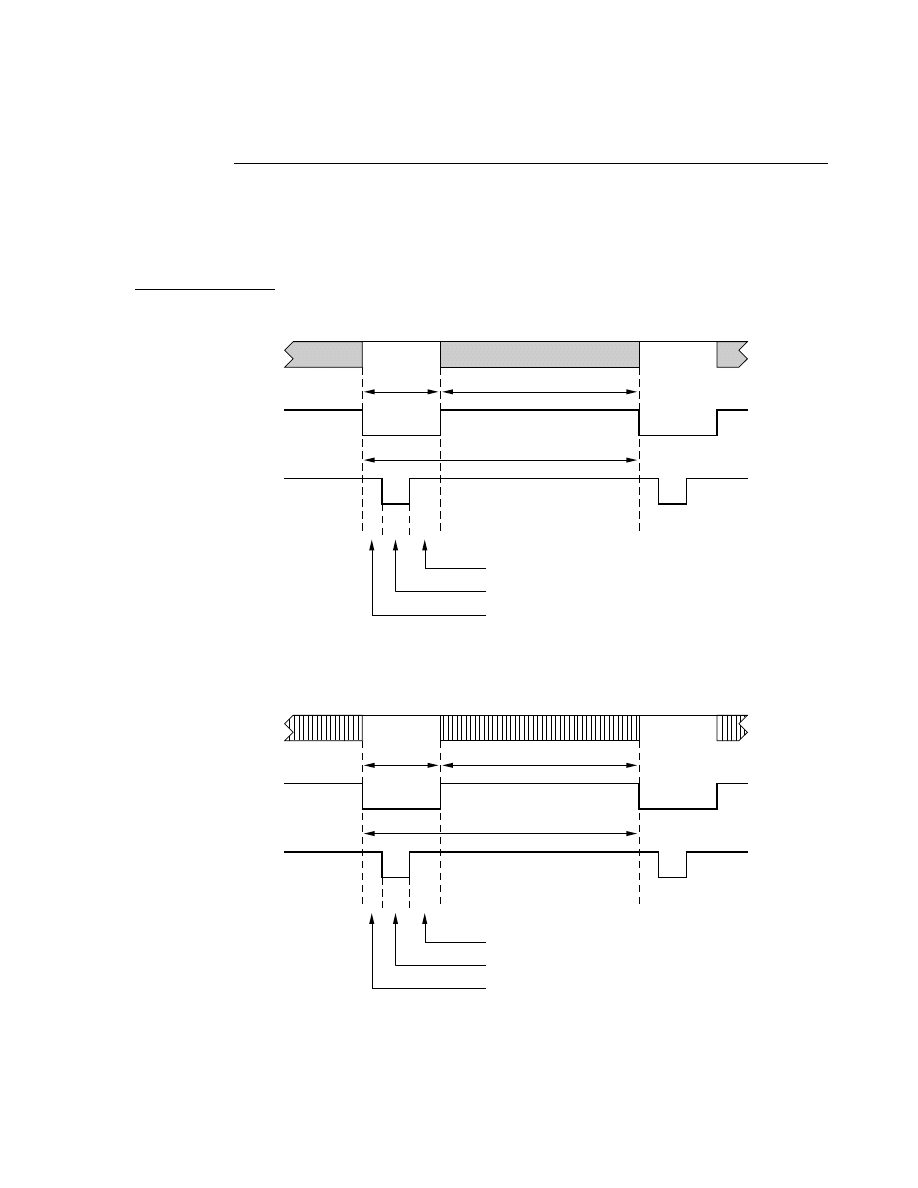
C H A P T E R 3
I/O Features
Video
37
Video Timing Parameters
3
Figure 3-3 shows simplified timing diagrams and identifies the horizontal and vertical
timing parameters in a video signal. Table 3-11 lists the values of those parameters for
the different types of monitors supported by the Power Macintosh 5260 computer.
Figure 3-3
Video timing diagram
Video
H sync space
H image space
H line length
H back porch
H sync pulse
H front porch
HBLANK
/HSYNC
Black
Horizontal timing
Video
V sync space
V image space
V line length
V back porch
V sync pulse
V front porch
VBLANK
/VSYNC
Vertical timing
White
Black
White

C H A P T E R 3
I/O Features
38
Video
Table 3-11 lists the timing parameters for the 13-inch color monitor.
Table 3-11
Video timing parameters for 13-inch (640 by 480) monitor
Parameter
Specification
Dot clock
30.24 MHz
Dot time
33.07 ns
Line rate
35.00 kHz
Line time
28.57
µ
s
(864 dots)
Horizontal active video
640 dots
Horizontal blanking
224 dots
Horizontal front porch
64 dots
Horizontal sync pulse
64 dots
Horizontal back porch
96 dots
Frame rate
66.72 Hz
Frame time
15.01 ms
(525 lines)
Vertical active video
480 lines
Vertical blanking
45 lines
Vertical front porch
3 lines
Vertical sync pulse
3 lines
Vertical back porch
39 lines

C H A P T E R 4
Expansion Features
4
Figure 4-0
Listing 4-0
Table 4-0

C H A P T E R 4
Expansion Features
40
DRAM Expansion
This chapter describes the expansion features of the Power Macintosh 5260 computer:
the DRAM expansion slot, the I/O expansion slot, the DVA connector on the video input
module, and the communications slot.
Note
Apple does not support development of third-party
cards for the video input slot or the communications slot.
◆
DRAM Expansion
4
The computers come with 8 MB of system DRAM in the form of a SIMM (single inline
memory module) installed in one of two 72-pin SIMM slots on the main logic board. You
can expand the DRAM up to a maximum of 64 MB by plugging in a second SIMM or by
plugging in SIMMs of higher capacity in one or both SIMM slots.
Note
The video display buffer uses separate on-board DRAM. The display
DRAM cannot be expanded.
◆
DRAM Configurations
4
Table 4-1 shows the different possible DRAM configurations. For more information, see
the section “RAM Addresses” on page 21.
Table 4-1
DRAM configurations
SIMM 1
SIMM 2
Maximum
DRAM
8 MB
0 MB
8 MB
8 MB
4 MB
12 MB
8 MB
8 MB
16 MB
16 MB
4 MB
20 MB
16 MB
8 MB
24 MB
16 MB
16 MB
32 MB
32 MB
4 MB
36 MB
32 MB
8 MB
40 MB
32 MB
16 MB
48 MB
32 MB
32 MB
64 MB

C H A P T E R 4
Expansion Features
DRAM Expansion
41
SIMM Slot Signal Assignments
4
Table 4-2 gives the signal assignments for the pins of the SIMM slot.
IMPORTANT
SIMMs used in Macintosh computers must meet the timing and
electrical standards of these machines. SIMMs designed for other
computers may not work.
▲
Table 4-2
SIMM slot signal assignments
Pin
Signal name
Signal description
1
GND
Ground
2
DQ0
Data input/output bus, bit 0
3
DQ16
Data input/output bus, bit 16
4
DQ1
Data input/output bus, bit 1
5
DQ17
Data input/output bus, bit 17
6
DQ2
Data input/output bus, bit 2
7
DQ18
Data input/output bus, bit 18
8
DQ3
Data input/output bus, bit 3
9
DQ19
Data input/output bus, bit 19
10
+5 V
+5 volts
11
n.c.
Not connected
12
A0
Address bus, bit 0
13
A1
Address bus, bit 1
14
A2
Address bus, bit 2
15
A3
Address bus, bit 3
16
A4
Address bus, bit 4
17
A5
Address bus, bit 5
18
A6
Address bus, bit 6
19
A10
Address bus, bit 10
20
DQ4
Data input/output bus, bit 4
21
DQ20
Data input/output bus, bit 20
22
DQ5
Data input/output bus, bit 5
23
DQ21
Data input/output bus, bit 21
24
DQ6
Data input/output bus, bit 6
continued

C H A P T E R 4
Expansion Features
42
DRAM Expansion
25
DQ22
Data input/output bus, bit 22
26
DQ7
Data input/output bus, bit 7
27
DQ23
Data input/output bus, bit 23
28
A7
Address bus, bit 7
29
A11
Address bus, bit 11
30
+5 V
+5 volts
31
A8
Address bus, bit 8
32
A9
Address bus, bit 9
33
/RAS3
Row address strobe 3
34
/RAS2
Row address strobe 2
35
—
Reserved
36
—
Reserved
37
—
Reserved
38
—
Reserved
39
GND
Ground
40
/CAS0
Column address strobe 0
41
/CAS2
Column address strobe 2
42
/CAS3
Column address strobe 3
43
/CAS1
Column address strobe 1
44
/RAS0
Row address strobe 0
45
/RAS1
Row address strobe 1
46
n.c.
Not connected
47
/W
Write enable
48
n.c.
Not connected
49
DQ8
Data input/output bus, bit 8
50
DQ24
Data input/output bus, bit 24
51
DQ9
Data input/output bus, bit 9
52
DQ25
Data input/output bus, bit 25
53
DQ10
Data input/output bus, bit 10
54
DQ26
Data input/output bus, bit 26
55
DQ11
Data input/output bus, bit 11
continued
Table 4-2
SIMM slot signal assignments (continued)
Pin
Signal name
Signal description

C H A P T E R 4
Expansion Features
DRAM Expansion
43
DRAM Devices
4
The DRAM controller in the F108 IC supports 1 Mbit, 4 Mbit, and 16 Mbit devices; it
does not support 64 Mbit devices. The DRAM controller supports four banks of DRAM.
Each SIMM can be configured in one or two banks. A single-bank SIMM using 1 Mbit,
4 Mbit, or 16 Mbit devices provides a DRAM capacity of 1 MB, 4 MB, or 16 MB,
respectively. A two-bank SIMM using the same devices provides 2 MB, 8 MB, or 32 MB
of DRAM.
IMPORTANT
You should not use 1-bit-wide devices in a SIMM slot because the
number of devices you would need to provide the required capacity
adds excessive capacitive loading to the address and control buses.
▲
The access time of the DRAM devices must be 80 ns or less. The DRAM controller in the
F108 IC performs the refresh function, using CAS before RAS refresh and refreshing the
DRAM devices within 15.6
µ
s. DRAM devices that require refreshing within 7.8
µ
s are
not supported.
56
DQ27
Data input/output bus, bit 27
57
DQ12
Data input/output bus, bit 12
58
DQ28
Data input/output bus, bit 28
59
+5 V
+5 volts
60
DQ29
Data input/output bus, bit 29
61
DQ13
Data input/output bus, bit 13
62
DQ30
Data input/output bus, bit 30
63
DQ14
Data input/output bus, bit 14
64
DQ31
Data input/output bus, bit 31
65
DQ15
Data input/output bus, bit 15
66
n.c.
Not connected
67
—
Reserved
68
—
Reserved
69
—
Reserved
70
—
Reserved
71
n.c.
Not connected
72
GND
Ground
Table 4-2
SIMM slot signal assignments (continued)
Pin
Signal name
Signal description

C H A P T E R 4
Expansion Features
44
DRAM Expansion
The DRAM controller in the F108 IC supports line burst transfers but does not support
interleaved accesses.
Addressing DRAM
4
Signals A[11:0] make up a 12-bit multiplexed address bus that can support several
different types of DRAM devices.
Depending on their internal design and size, different types of DRAM devices require
different row and column address multiplexing. The F108 custom IC provides for two
addressing modes, selected individually for each bank of DRAM. The system software
initializes the address mode bits as part of the process of determining the amount of
DRAM installed in the computer.
Table 4-3 shows how the signals are multiplexed during the row and column address
phases for each of the addressing modes.
Table 4-4 shows the address modes used with several types of DRAM devices. The
devices are characterized by their bit dimensions: for example, a 256K by 4-bit device
has 256 addresses and stores 4 bits at a time.
Table 4-3
Address multiplexing for DRAM devices
Address mode
Individual signals on DRAM_ADDR bus
A[11]
A[10]
A[9]
A[8]
A[7]
A[6]
A[5]
A[4]
A[3]
A[2]
A[1]
A[0]
Address mode = 1
Row address bits
A23
A22
A20
A19
A18
A17
A16
A15
A14
A13
A12
A11
Column address bits
A24
A23
A21
A10
A9
A8
A7
A6
A5
A4
A3
A2
Address mode = 0
Row address bits
A21
A20
A10
A19
A18
A17
A16
A15
A14
A13
A12
A11
Column address bits
A24
A23
A25
A22
A9
A8
A7
A6
A5
A4
A3
A2

C H A P T E R 4
Expansion Features
DRAM Expansion
45
Mechanical Specifications for the SIMM
4
The SIMMs in the Power Macintosh 5260 computer are mechanically the same as the
72-pin SIMMs used in the Macintosh LC 630, Macintosh Quadra 630, Macintosh LC III,
Macintosh LC 475, and Macintosh Quadra 605 and 610 computers. The mechanical
design of the 72-pin SIMM is based on the industry standard design defined in the
JEDEC Standard Number 21-C.
Figure 4-1 on page 46 shows the mechanical specifications of the SIMM. Pin contacts
must be tin, not gold or copper, and the circuit board must dedicate one layer to power
and one to ground.
Table 4-4
Address modes for various DRAM devices
Device size
Device type
Row bits
Colum
bits
Address
mode
1 megabit
256K by 4
9
9
1
4 megabits
1 M by 4
10
10
1
4 megabits
512K by 8
10
9
1
4 megabits
256K by 16
10
8
0
16 megabits
4 M by 4
11
11
1
16 megabits
4 M by 4
12
10
1
16 megabits
2 M by 8
11
10
1
16 megabits
2 M by 8
12
9
0
16 megabits
1 M by 16
12
8
0
NOTE
Refer to Table 4-3 on page 44 for information about
addressing modes.
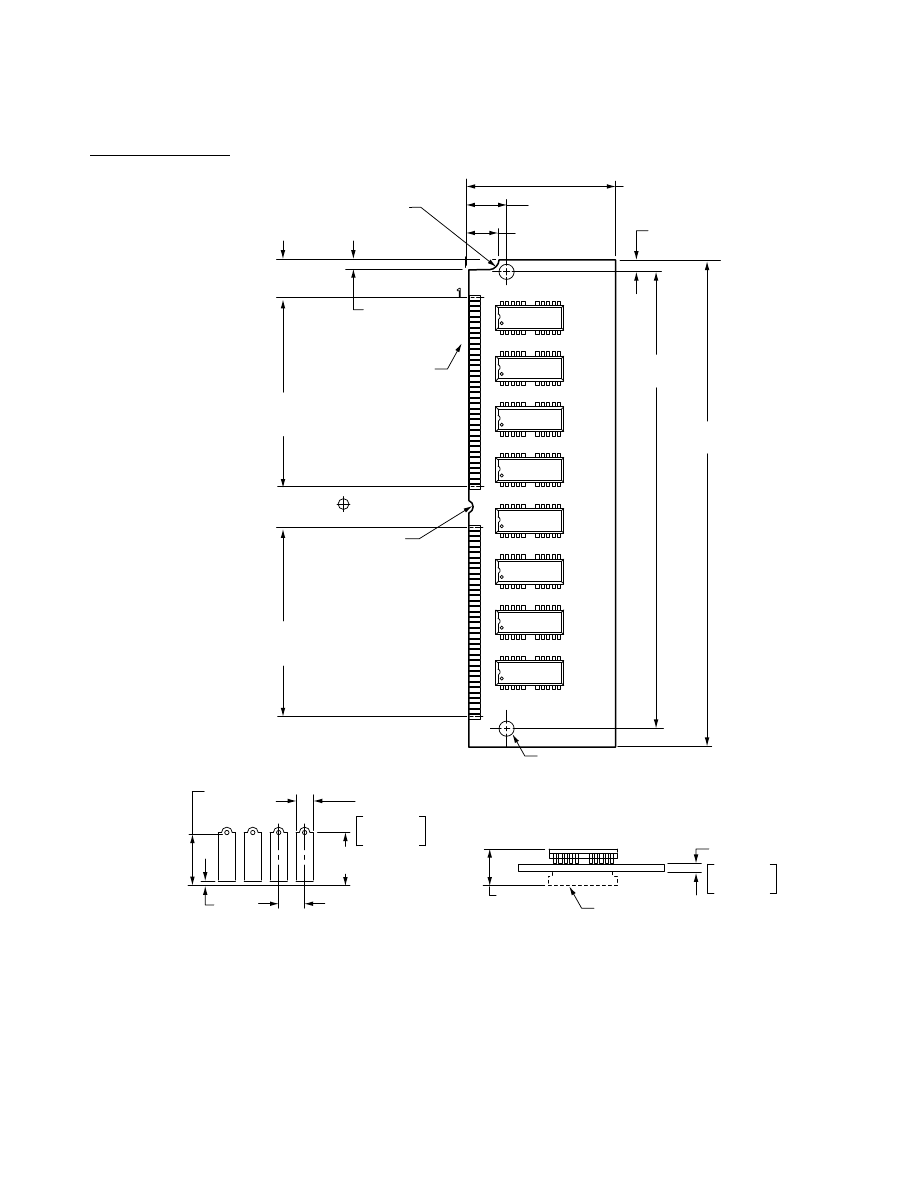
C H A P T E R 4
Expansion Features
46
DRAM Expansion
Figure 4-1
SIMM mechanical specifications
R 1.57
±
0.1
[.062
±
.004]
10.16
±
0.20
[.400
±
.008]
107.95
±
0.20
[4.25
±
.008]
101.19
±
0.20
[3.98
±
.008]
(6.35)
[.250]
6.35
±
0.20
[.250
±
.008]
25.4 [1.0]
Max
1.27 +0.10
- 0.08
+.004
- .003
.050
2X Ø3.18
±
0.1
[.125
±
.004]
9.4 [.37]
Max
2.54 [.100]
Min
1.27
±
0.10
[.050
±
.004]
0.25
[.010]
Max
Detail A
Rotated 90
°
CCW
35 X 1.27 [.050] =
44.45
±
0.20
[1.75
±
.008]
6.35
±
0.05
[.250
±
.002]
0.10 [.004] M A B
35 X 1.27 [.050] =
44.45
±
0.20
[1.75
±
.008]
2.03
±
0.20
[.080
±
.008]
See detail A
3.38
[.133]
2.03
[.080]
Min
R 1.57
±
0.12
[.062
±
.005]
0.90 +0.17
- 0.08
+.003
- .003
.035
Device on this
side optional.
Note: Dimensions are in millimeters with inches in brackets.

C H A P T E R 4
Expansion Features
I/O Expansion Slot
47
I/O Expansion Slot
4
The I/O expansion slot can accept either of two types of expansion cards: a 96-pin card
similar to the PDS card used in the Macintosh LC II or a 114-pin card similar to the PDS
card used in the Macintosh LC III.
IMPORTANT
Although often referred to as a processor-direct slot (PDS), the I/O
expansion slot in the Power Macintosh 5260 computer is not a true PDS
because it is not connected directly to the main processor. PDS cards
designed to interact with the main processor—to provide, for example, a
DRAM cache or an FPU—will not work in the Power Macintosh 5260’s
I/O expansion slot.
▲
I/O Expansion Connector
4
The I/O expansion connector is mechanically the same as the PDS connector in the
Macintosh Quadra 630 and LC 630. It is essentially a 120-pin Euro-DIN connector with
six pins removed to make a notch. The notch divides the connector into two sections: a
96-pin section that accepts the 96-pin connector used on PDS cards for the
Macintosh LC II and a separate 18-pin section for additional signals. For more
information see the section “Card Connectors” on page 53.
Connector Pin Assignments
4
Table 4-5 on page 48 gives the pin assignments for the I/O expansion connector. Pins 1
through 32 in all three rows (A, B, and C) correspond to the 96-pin section of the
connector. Pins 33 and 34 in all three rows are missing—these pins correspond to the
notch in the connector. Pins 35 through 40 in all three rows make up the 18-pin section of
the connector. Table 4-6 on page 49 provides descriptions of the signals.
Except for one signal, 16MASTER on pin B31, the pin assignments on the 96-pin section
of the extended PDS are the same as those on the PDS in the Macintosh LC II. On the
Macintosh LC II, pin B31 is the Apple II video clock input.
▲
W A R N I N G
Under no circumstances should you use the Analog GND pin (Pin 1,
Row B) for a digital ground on your expansion card. Doing so causes
digital noise to be coupled into the audio system, resulting in degraded
sound quality.
▲
All the signals on the expansion connector are capable of driving at least one TTL load
(1.6 mA sink, 400
µ
A source). Most of the signals are connected to other MOS devices on
the main logic board; for these signals, the DC load on the bus signals is small. All the
data lines (D31:0) are connected to the PrimeTime III custom IC so they have CMOS-type
loads.

C H A P T E R 4
Expansion Features
48
I/O Expansion Slot
Table 4-5
Pin assignments for the expansion connector
Pin
number
Row A
Row B
Row C
1
n.c.
Analog GND
/FPU.SEL
2
/SLOTIRQ
/R/W
/DS
3
/PDS.AS
+5 V
/BERR
4
/PDS.DSACK1
+5 V
/PDS.DSACK0
5
/HALT
SIZ1
SIZ0
6
FC2
GND
FC1
7
FC0
CLK16M
/RESET
8
/RMC
GND
/BG.SLOT
9
D31
D30
D29
10
D28
D27
D26
11
D25
D24
D23
12
D22
D21
D20
13
D19
D18
D17
14
D16
D15
D14
15
D13
D12
D11
16
D10
D9
D8
17
/BGACK
/BR_SLOT
A0
18
A1
A31
A27
19
A26
A25
A24
20
A23
A22
A21
21
A20
/IPL2
/IPL1
22
/IPL0
D3
D4
23
D2
D5
D6
24
D1
D0
D7
25
A4
A2
A3
26
A6
A12
A5
27
A11
A13
A7
28
A9
A8
A10
29
A16
A15
A14
30
A18
A17
A19
31
n.c. 16MASTER
FC3

C H A P T E R 4
Expansion Features
I/O Expansion Slot
49
Signal Descriptions
4
The I/O expansion slot is compatible with expansion cards designed for computers that
use the MC68030 microprocessor (the Macintosh LC III and Macintosh LC 520
computers). Because the bus protocols on the 68040 I/O bus are not the same as those of
the MC68030, the signals on the I/O expansion slot are not connected directly to the
main processor. Instead, these signals are connected to the PrimeTime III custom IC,
which emulates the MC68030 control and data buses.
The upper 30 address lines (A31:2) are connected directly to the 68040 address bus. The
I/O bus adapter logic in the PrimeTime III IC provides the buffered data bus (IOD31:0)
and the two lowest address lines (A1:0).
Table 4-6 describes the signals on the I/O expansion connector.
32
+12 V
GND
–5 V
33
Pin not present
Pin not present
Pin not present
34
Pin not present
Pin not present
Pin not present
35
A28
/BG.SLOT
C16M
36
A29
+5 V
A30
37
/CIOUT
/CPU.AS
/STERM
38
/CBACK
n.c.
/CBREQ
39
n.c.
/CPU.DSACK0
n.c.
40
n.c.
GND
/CPU.DSACK1
Table 4-6
Descriptions of the signals on the I/O expansion connector
Signal name
Signal description
A0:A31
Address lines.
/BERR
Bus error; bidirectional signal indicating that an error occurred
during the current bus cycle; when /HALT is also asserted, /BERR
causes the bus cycle to be retried.
/BGACK
Bus grant acknowledge; input signal indicating that a device on the
card has become bus master.
/BG.SLOT
Bus grant to the slot; signal indicating that a device on the card can
become bus master following completion of the current processor
bus cycle (when /PDS.AS, /BGACK, and all the /DSACK signals
are inactive).
continued
Table 4-5
Pin assignments for the expansion connector (continued)
Pin
number
Row A
Row B
Row C

C H A P T E R 4
Expansion Features
50
I/O Expansion Slot
/BR.SLOT
Bus request from the slot; input signal indicating that a device on
the card is requesting to become bus master.
/CBACK
CPU burst acknowledge; used with /STERM during a burst
transfer to indicate that an individual element of a burst transfer
is ready.
/CBREQ
CPU burst request; used to initiate a quadruple longword burst
transfer; tied to a 4.7K pull-up resistor.
/CIOUT
Cache inhibit out signal from main processor indicating that a
second-level cache is allowed to participate in the current bus
transaction; tied to a 300
Ω
pull-down resistor.
C16M
Same signal as CLK16M.
CLK16M
Independent clock running at 15.6672 MHz; provided for
compatibility with Macintosh LC and LC II PDS cards.
/CPU.AS
Address strobe; three-state signal indicating that an active bus
transaction is occurring.
/CPU.DSACK0,
/CPU.DSACK1
Data strobe acknowledge signals; asserted by the addressed bus
slave to end a bus transaction; also used to inform the master of the
size of the slave’s data port. These signals are electrically connected
to the corresponding /PDS.DSACK signals.
D31:01
Data lines.
/DS
Data strobe. During a read operation, /DS is asserted when a
device on the card should place data on the data bus; during a write
operation, /DS is asserted when the main processor has put valid
data on the data bus.
FC2:0
Function code used to identify address space of current bus cycle;
tied to pull-up and pull-down resistors to indicate supervisor data
space accesses.
FC3
Additional function code bit used to indicate that the software is
running in 32-bit address mode. (As in the Macintosh LC II, the
software always runs in 32-bit mode.)
/FPU.SEL
Select signal for an optional MC68881 or MC68882 FPU; tied to a
4.7K pull-up resistor; never asserted by the logic board in a
Macintosh LC 475 or Macintosh Quadra 605 computer.
/HALT
Used in conjunction with the /BERR signal to terminate a bus cycle
with a retry response; not used to stop processor execution.
/IPL 2:0
Interrupt priority-level lines.
continued
Table 4-6
Descriptions of the signals on the I/O expansion connector (continued)
Signal name
Signal description

C H A P T E R 4
Expansion Features
I/O Expansion Slot
51
The /BG.SLOT signal appears on two pins; there is no separate CPU.BG signal. The
following signals on the expansion slot are permanently connected:
■
/PDS.DSACK0 is connected to /CPU.DSACK0
■
/PDS.DSACK1 is connected to /CPU.DSACK1
Unlike these signals, the /PDS.AS signal and the /CPU.AS signal are not connected
together. The /PDS.AS signal is used only for addresses in the slot $E address range; the
/CPU.AS signal is used for addresses in expansion slot and Super Slot spaces $6–$8,
$A–$D, and $F (the slot $9 address spaces are used for built-in video circuitry).
IMPORTANT
The I/O expansion slot does not support PowerPC 603e bus transfers
since it does not support processors operating at any clock frequency
other than 16 MHz.
▲
/PDS.AS
Address strobe; synchronized to 16 MHz regardless of the actual
processor speed; asserted only when a valid slot address is being
generated by the bus master. When the card is the active bus
master, the card may drive either this signal or /CPU.AS, but
not both.
/PDS.DSACK0,
/PDS.DSACK1
Data strobe acknowledge signals; asserted by the addressed bus
slave to end a bus transaction; also used to inform the master of the
size of the slave’s data port. These signals are electrically connected
to the corresponding /CPU.DSACK signals.
/RESET
Notifies the expansion card that the CPU has reset.
/RMC
Three-state output signal that identifies the current bus cycle as part
of an indivisible bus cycle such as a read-modify-write operation.
/R/W
Read/write; three-state output signal that defines the direction of
the bus transfer with respect to the current bus master; logical one
(1) indicates a bus-master read, zero (0) indicates bus-master write.
16MASTER
Indicates the width of the data port when the card is alternate bus
master. A logical one (1) indicates a 16-bit port; logical zero (0)
indicates a 32-bit port. The signal is pulled high on the main
logic board.
SIZ0, SIZ1
Three-state output signals that work in conjunction with the
PrimeTime III IC’s dynamic bus sizing capabilities and indicate
the number of bytes remaining to be transferred during the
current bus cycle.
/SLOTIRQ
Interrupt request line from the card; reported to the system by way
of the SLOT.E request; when low, generates a level-2 interrupt if the
slot interrupt enable bit is set.
/STERM
Indicates termination of a synchronous transfer by a card using the
MC68030 synchronous cycle.
Table 4-6
Descriptions of the signals on the I/O expansion connector (continued)
Signal name
Signal description

C H A P T E R 4
Expansion Features
52
I/O Expansion Slot
Bus Master on a Card
4
The I/O expansion slot support cards with an MC68020 or MC68030 bus master. The
PrimeTime III custom IC controls bus arbitration between the card’s bus master and the
PowerPC 603e microprocessor so that either bus master eventually obtains the bus. The
MC68020 or MC68030 obtain the I/O data bus and the address bus. The
PowerPC 603e obtains the processor data bus and the address bus. The Capella IC
synchronizes the bus arbitration between the PowerPC 603e and the 68040 address bus.
Because there is only one address bus, there can be only one bus master at a time.
Asynchronous transfers are the preferred method for transferring data to and from an
I/O expansion card. When an I/O expansion card contains an active bus master, the
PrimeTime III IC terminates successful data transfers using the DSACK signals. A slave
on the expansion card can also terminate a transfer using DSACK signals.
The PrimeTime III IC can never be a synchronous slave on the I/O bus, so PrimeTime III
cannot terminate data transfers as a slave using /STERM. On the other hand, a bus slave
on an expansion card can terminate a 32-bit wide synchronous transfer using /STERM.
PrimeTime III supports /STERM terminations as a master on the I/O bus, and all
transfers from PrimeTime III to the expansion slot are based on the 16 MHz clock.
Incompatibility With Older Cards
4
While the I/O expansion slot physically accepts PDS cards designed for the
Macintosh LC II and LC III, some of these cards will not work in the Power Macintosh
5260 computer. Cards that are incompatible include the following:
■
Cards such as accelerators, 68882 FPU cards, and cache cards that are designed to
work as coprocessors with an MC68020 or an MC68030 or to replace these
microprocessors. This type of card will not work because the microprocessor is
different and because the slot signals are not connected directly to the microprocessor.
■
Cards with drivers that include incompatible code. Some drivers that do not follow
Apple Computer’s programming guidelines will not work on machines that use the
PowerPC 603e microprocessor. For example, some of these drivers write directly to
the cache control register in an MC68030 and such code will not work on a
PowerPC 603e processor.
■
Cards with drivers that include code to check the
gestaltMachineType
value and
refuse to run on a newer CPU. Such cards have compatibility problems with all new
Macintosh computers. However it provides protection for the user, since it means the
cards will not run on a machine on which they have not been tested.
Designing an I/O Expansion Card
4
The I/O expansion card is approximately 3 inches wide by 5 inches long. It is installed
parallel to the main logic board and you can connect to the card through an opening on
the back panel of the computer. When an I/O expansion card is not installed, the
opening on the back panel is protected by a snap-on cover. The 15-pin D-type connector

C H A P T E R 4
Expansion Features
I/O Expansion Slot
53
on the card can be accessed from the back of the case providing the external I/O
connection.
The Appendix, “I/O Expansion Card Mechanical Drawings” beginning on page 97,
contains drawings that show the recommended mechanical design guidelines for the
expansion card. Drawing 1 shows the maximum dimensions of the expansion card and
the location of the expansion connector. Drawing 2 defines component height
restrictions. Drawing 3 shows how the card is installed on the main logic board.
Note
The I/O expansion card is the same size and shape as the PDS card used
in the Macintosh LC III computer.
◆
Card Connectors
4
The custom 114-pin PDS connector on the computer’s main logic board accepts either a
96-pin or 120-pin standard Euro-DIN connector. You can order connectors meeting
Apple specifications from Amp Incorporated, Harrisburg, PA 17105 or from Augat
Incorporated, Interconnect Products Division, P. O. Box 779, Attleboro, MA 02703. Refer
to Designing Cards and Drivers for the Macintosh Family, third edition, for more information
about these connectors.
Power for the Card
4
The maximum current available at each supply voltage is shown in Table 4-7. The card
must not dissipate more than 4 W total. For example, if the card uses the maximum
current at –5 V and +12 V, it must not use more than 300 mA from the +5 V supply.
▲
W A R N I N G
Cards dissipating more than 4 watts may overheat and damage the
computer’s circuitry or cause it to become inoperable.
▲
Card Address Space
4
The address space for the I/O expansion card appears in physical address spaces
$E000 0000–$EFFF FFFF and $FE00 0000–$FEFF FFFF. To match the conventions used
by the Slot Manager, software should address the card as if it were in slot space $E:
either the 16 MB slot space $FE00 0000–$FEFF FFFF or the Super Slot space
$E000 0000–$EFFF FFFF.
Table 4-7
Power available for the expansion card
Voltage
Current
+5
800 mA
–5
20 mA
+12
200 mA
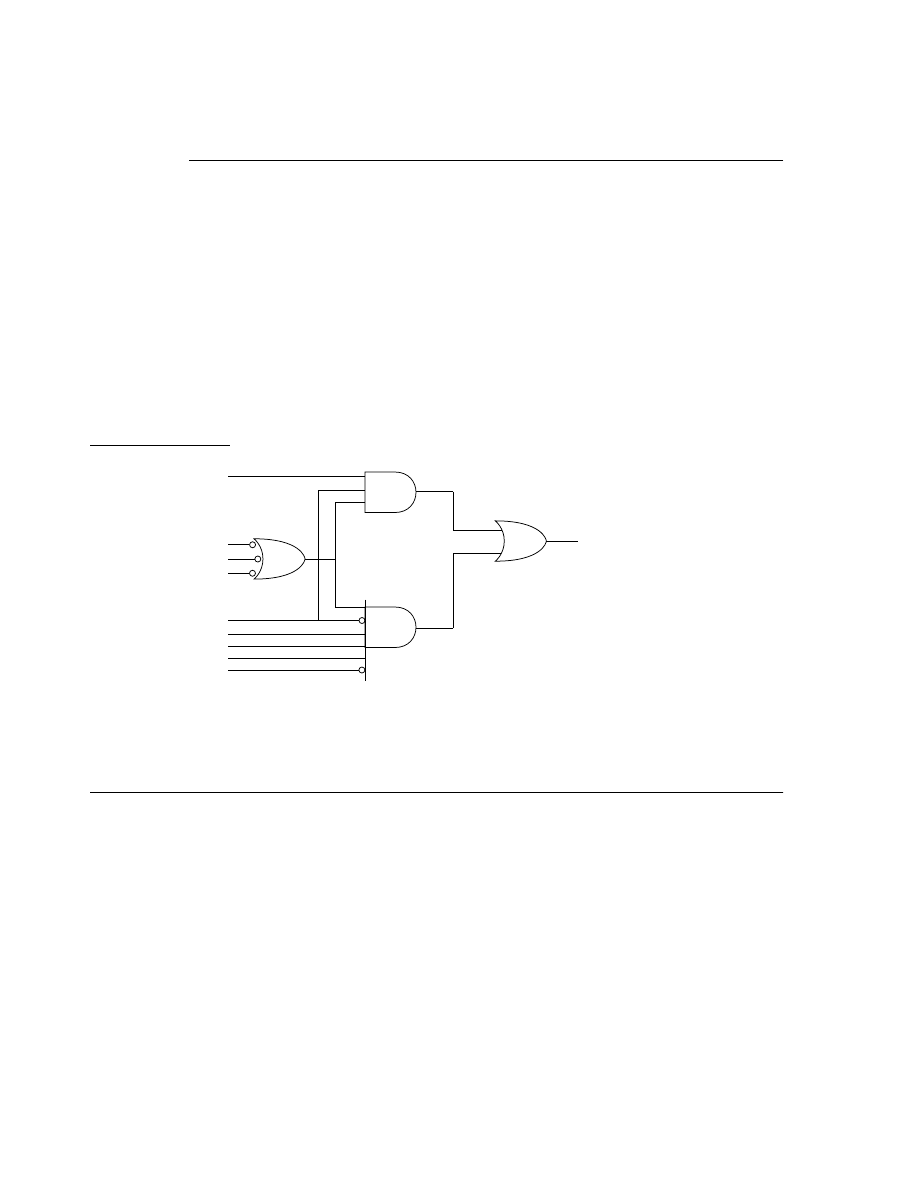
C H A P T E R 4
Expansion Features
54
DVA Connector
Card Select Signal
4
The I/O expansion card must generate its own select signal from the address and
function code signals on the connector. The card select signal must be disabled when
FC0, FC1, and FC2 are all active; that condition corresponds to a function code of 111
(CPU space). Figure 4-2 shows a logic circuit typically used for generating the card select
signal.
IMPORTANT
To ensure compatibility with future hardware and software, you should
minimize the chance of address conflicts by decoding all the address
bits. To ensure that the Slot Manager recognizes your card, the card’s
declaration ROM must reside at the upper address limit of the 16 MB
address space ($FE00 0000–$FEFF FFFF).
▲
Figure 4-2
Generating the card select signal
DVA Connector
4
The optional video input card has a separate connector called the DVA (digital video
application) connector. The DVA connector provides access to the video input card’s
4:2:2 unscaled YUV video input data bus and associated control signals. By means of a
cable to the DVA connector, an I/O expansion card can gain access to the digital video
bus on the video input card and use it to transfer real-time video data to the computer.
Such an I/O expansion card can contain a hardware video compressor or other video
processor.
The DVA connector is a 34-pin flat ribbon connector located at the top edge of the video
input card. Figure 4-3 is a view of the main logic board showing the I/O expansion card
and the location of the DVA connector on the video input card.
A31
FC0
FC1
FC2
FC3
A23
A22
A21
A20
Card
select
32-bit mode
select
24-bit mode
select
Disable selection
on interrupt
acknowledge
cycles
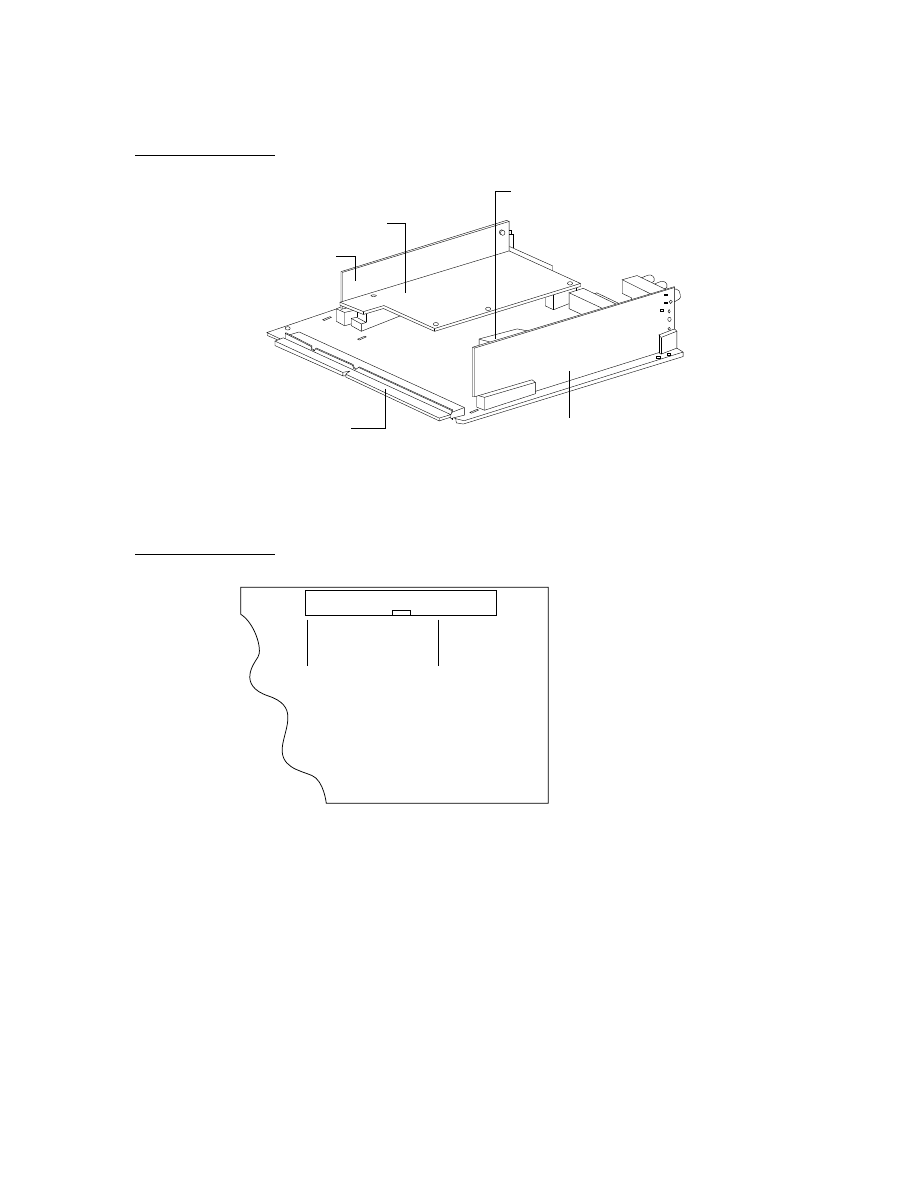
C H A P T E R 4
Expansion Features
DVA Connector
55
Figure 4-3
Location of the DVA connector
Figure 4-4 shows the orientation of the DVA connector on the video input module.
Figure 4-4
Orientation of the DVA connector
The DVA connector accepts YUV video and analog sound from the expansion card but
does not itself generate YUV video output or audio output signals.
IMPORTANT
The DVA connector on the video input card provides some of the
functionality of the DAV (digital audio/video) connectors found on the
Power Macintosh 7100 and 8100 models and the Macintosh Quadra
AV
models, but it is not compatible with either of these connectors. Refer to
Macintosh DAV Interface for NuBus Expansion Cards in Developer Note
Number 8 for more information.
▲
Communications
module
I/O expansion card
Internal chassis
connector
DVA connector on
video input module
Video input module
Pin 1
DVA connector

C H A P T E R 4
Expansion Features
56
DVA Connector
Pin Assignments and Signal Descriptions
4
Table 4-8 shows the pin assignments on the DVA connector and describes the signal
functions. Refer to the glossary for further information about chrominance, luminance,
and the YUV format.
IMPORTANT
The YUV video source also has associated stereo sound for left and right
channels, YUV_SND_ LEFT and YUV_SND_RIGHT, respectively. In
addition, there is the YUV return, YUV_RET, which is the ground
reference for YUV_SND_LEFT and YUV_SND_RIGHT. If you are
designing a video input module that uses the sound channels, you
should incorporate a differential amplifier for each channel to receive
the left and right sound signals and to remove audio noise from the
system. Typically, analog sound signals are AC coupled. For common
mode subtraction to work properly, the AC coupling should have a
break frequency around 2 Hz. This enables the common mode rejection
at 50 Hz to hit the required target of 40 dB (100:1). If the same technique
is used with video signals, the break frequency should be less than 2 Hz
to minimize tilt at 25 Hz.
▲
▲
W A R N I N G
Under no circumstances should you ground the YUV_RET signal. If you
do, your sound will contain a great deal of digital noise, and you will
increase the computer’s EMI emissions. This is particularly true if you
have not used differential amplifiers to receive the YUV_SND_LEFT and
YUV_SND_RIGHT signals.
▲
Table 4-8
DVA connector pin assignments and signal descriptions
Pin
number
Signal name
Signal description
1
UV(7)
Digital chrominance data bus bit 7
2
UV(6)
Digital chrominance data bus bit 6
3
UV(5)
Digital chrominance data bus bit 5
4
UV(4)
Digital chrominance data bus bit 4
5
UV(3)
Digital chrominance data bus bit 3
6
UV(2)
Digital chrominance data bus bit 2
7
UV(1)
Digital chrominance data bus bit 1
8
UV(0)
Digital chrominance data bus bit 0
9
Y(7)
Digital luminance data bus bit 7
10
Y(6)
Digital luminance data bus bit 6
11
Y(5)
Digital luminance data bus bit 5
continued

C H A P T E R 4
Expansion Features
DVA Connector
57
Using the YUV Bus
4
The video input module contains a digital video decoder and scaler (DESC), the Philips
SAA7196 IC. Logic on the video input card uses the CVBS port on the DESC and pulls
the DIR signal low, disabling the YUV bus. For an expansion card to use the YUV bus,
the software associated with the card must set the DIR signal high so that the DESC will
accept data on the YUV bus.
12
Y(4)
Digital luminance data bus bit 4
13
Y(3)
Digital luminance data bus bit 3
14
Y(2)
Digital luminance data bus bit 2
15
Y(1)
Digital luminance data bus bit 1
16
Y(0)
Digital luminance data bus bit 0
17
Ground
Ground
18
LLCB
Line-locked clock signal
19
Ground
Ground
20
CREFB
Clock reference signal
21
Ground
Ground
22
VS
Vertical sync signal
23
Ground
Ground
24
HS
Horizontal sync signal
25
Ground
Ground
26
HREF
Horizontal reference signal
27
Ground
Ground
28
DIR
YUV directional signal
29
Reserved
Reserved
30
Reserved
Reserved
31
Ground
Ground
32
YUV_SND_LEFT
Sound input left channel; read the information at the
beginning of this table for more details
33
YUV_RET
Ground reference for YUV_SND_LEFT and
YUV_SND_RIGHT; read the information at the
beginning of this table for more details
34
YUV_SND_RIGHT
Sound input right channel; read the information at
the beginning of this table for more details
Table 4-8
DVA connector pin assignments and signal descriptions (continued)
Pin
number
Signal name
Signal description
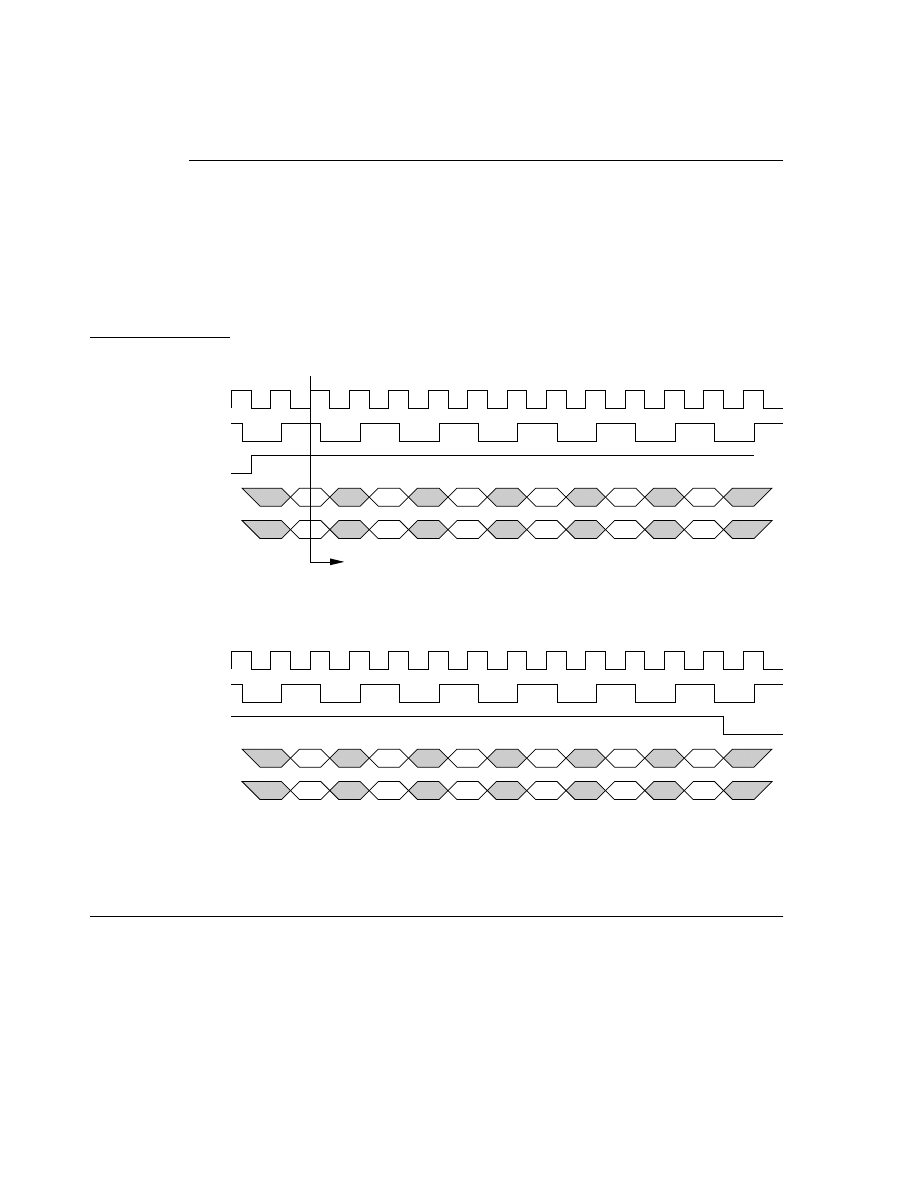
C H A P T E R 4
Expansion Features
58
Communications Slot
Video Data Format
4
Digital video data is transmitted as lines and fields. Each line consists of an even number
of samples on the Y and UV buses as shown in Figure 4-5. HREF is high during a video
line and low during the horizontal blanking interval. The falling edge of the VS signal
indicates the beginning of a video field. For more information about digital video data in
YUV format, see Macintosh DAV Interface for NuBus Expansion Cards in Developer Note
Number 8.
Figure 4-5
Video data timing
Communications Slot
4
The main logic board has a separate slot for an optional communications card,
1.57 inches (40 mm) wide by 6 inches (152 mm) long.
The communications slot supports 68030 protocol transfers with a 68030 bus master/
slave, SCC port A (modem port) for an Apple designed 2400 baud modem, and a special
serial port for an Apple designed 14,400 baud modem. The communications slot is
Y 0
LLCLK
vdcCREFB
HREF
Y 7–0
UV 7–0
Start of a video line
Y1
Y2
Y3
Y4
Y5
U 0
V0
U2
V2
U4
V4
Y and UV data valid on the rising edge of LLCLK
when HREF and CREFB are high
Yn-5
LLCLK
vdcCREFB
HREF
Y 7–0
UV 7–0
End of a video line
Yn-4
Yn-3
Yn-2
Yn-1
Yn
Un-5
Vn-5
Un-3
Vn-3
Un-1
Vn-1

C H A P T E R 4
Expansion Features
Communications Slot
59
capable of supporting a 68030 bus master and contains one set of 68030 bus arbitration
control signals, but it does not support 68040 bus protocol transfers.
The communications slot connector is a 112-pin half-height microchannel connector. A
communications card mounts vertically in the connector and its I/O connector is
accessed through the communications port access hole on the right hand side of the back
panel. If the card is not in use, a cover is placed over the access hole, as shown in Figure
1-2 on page 6.
A maximum of 2.5 watts of power are allocated to the communications slot. The
following shows the maximum possible current ratings for each power line:
Note
Apple Computer does not support development of third-party cards for
the communications slot. This developer note, therefore, does not
provide detailed pin assignments for the communications connector.
◆
Voltage
Current
+5 V
500 mA
+12 V
100 mA
Trickle +5 V
5 mA
–5 V
20 mA


C H A P T E R 5
Software Features
5
Figure 5-0
Listing 5-0
Table 5-0

C H A P T E R 5
Software Features
62
ROM Software
This chapter gives an overview of the software in the Power Macintosh 5260 computer’s
ROM.
For a description of the system software for the internal IDE hard disk, see Chapter 6,
“Software for the IDE Hard Disk.”
ROM Software
5
The ROM in the Power Macintosh 5260 computer is based on the ROM used in the
current Power Macintosh models with the changes necessary to support
machine-specific hardware.
The following is a list of the most significant ROM changes:
■
Hardware Init now includes support for MMU programming and other PowerPC
603e microprocessor functions, addition of new diagnostics, and removal of the 68040
check/support code.
■
The nanokernal has been modified to support the PowerPC microprocessor.
■
The software no longer supports 1- or 2- bit video modes.
■
The software supports both 8-bit and 16-bit sound; the Power Macintosh 5260
computer uses 16-bit sound.
The ROM contains tables and code that identify the computer. Applications can find
out which computer they are running on by using the Gestalt Manager routines; see
Inside Macintosh: Overview. The
gestaltMachineType
value returned by the Power
Macintosh 5260 computer is 41 (hexadecimal $29), which is the same as the value
returned for the Power Macintosh 5200 computer.
System Software
5
The Power Macintosh 5260 computer is shipped with a version of System 7.5 software
preinstalled. System 7.5 Update 1.0 is included in the preinstalled system software. The
disk labeled “Install Me First” includes a system enabler file that contains the resources
the system needs to start up and initialize the computer.
As soon as the system software on disk takes over the startup process, it searches for all
system enablers that can start up the particular machine. Each system enabler contains a
resource that specifies which computers it is able to start up and the time and date of its
creation. If the system software finds more than one enabler for the particular computer,
it passes control to the one with the most recent time and date.
In general, the system enabler included in each reference release of system software
is able to start up all previous computers. The enablers for computers introduced after
a reference release may be independent or may use resources from the previous
reference release.
The system enabler includes modifications to the video digitizer allowing it to run in
native mode to improve video capture performance.

C H A P T E R 6
Software for the
IDE Hard Disk
6
Figure 6-0
Listing 6-0
Table 6-0
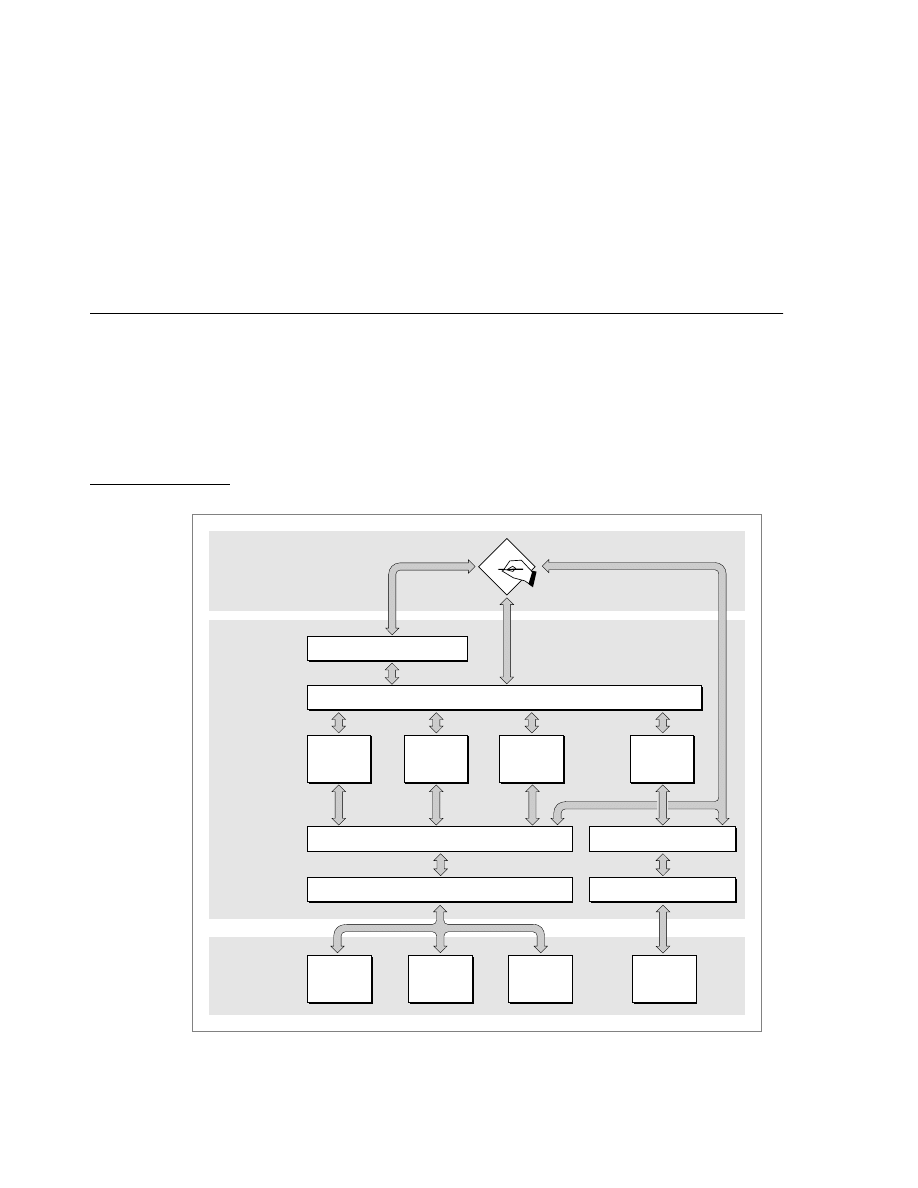
C H A P T E R 6
Software for the IDE Hard Disk
64
Introduction to IDE Software
This chapter describes the system software that controls an IDE hard disk drive installed
in the Power Macintosh 5260 computer. To use the information in this chapter, you
should be familiar with writing programs for the Macintosh computer, with device
drivers that manipulate devices directly, and with the ATA/IDE specification ANSI AT
Attachment Interface with Extensions (ATA-2).
Introduction to IDE Software
6
Support for IDE (integrated drive electronics) hard disk drives is incorporated into the
ROM software. System software for controlling IDE hard drives is included in a new IDE
hard disk drive device driver and the ATA Manager. The relationship of the IDE hard
disk drive device driver and the ATA Manager to the Macintosh system architecture is
shown in Figure 6-1.
Figure 6-1
Relationship of the ATA Manager to the Macintosh system architecture
CD-ROM
driver
SCSI
hard disk
driver
File Manager
Device Manager
ATA/IDE
hard disk
driver
CD-ROM
SCSI
hard disk
Other SCSI
devices
SCSI interface
Peripheral
devices
System
software
Application
SCSI Manager
ATA interface
ATA Manager
ATA/IDE
hard disk
Other SCSI
device
drivers

C H A P T E R 6
Software for the IDE Hard Disk
Introduction to IDE Software
65
At the system level, the IDE device driver and ATA Manager work in the same way as
the SCSI Manager and the associated SCSI device drivers. The IDE hard disk device
driver provides drive partition, data management, and error-handling services for the
Mac OS. It also determines device capacity and controls device-specific features. The
ATA Manager provides the IDE device driver with an interface to the IDE hard disk
drive.
IDE hard disk drives appear on the desktop in the same way as SCSI hard disk drives.
Except for applications that perform low-level services, such as formatting and
partitioning utilities, applications interact with the IDE hard disk drives in a device-
independent manner through the File Manager.
IDE Hard Disk Device Driver
6
The IDE hard disk device driver provides OS-dependent services through a set of driver
routines that interface with the Mac OS. In addition, it provides additional control and
status functions that are specific to this implementation of the IDE hard disk device
driver. The required driver routines, as specified in Inside Macintosh: Devices, are
open
,
close
,
prime
,
control
, and
status
.
In addition to the required functions, the IDE hard disk device driver provides support
for device-specific features. IDE hard disk device driver control and status functions are
defined in “IDE Hard Disk Driver Reference” beginning on page 66.
At system startup time, if a RAM-based driver is not found on the IDE drive media, the
IDE device driver in the ROM is installed as one of the device drivers. This is different
from the driver loading sequence for SCSI hard disk drive devices, since these drivers
are RAM based and are always loaded from the device media.
The IDE hard disk device driver does not provide request queuing. All driver requests
are either completed immediately or are passed to the ATA Manager for further
processing. For further information about the control and status functions for the IDE
hard disk device driver, see “IDE Hard Disk Driver Reference.”
ATA Manager
6
The Macintosh ATA Manager schedules I/O requests from the IDE hard disk device
driver, the operating system, and applications. It is also manages the hardware interface
to the IDE controller electronics.
When making calls to the ATA Manager you have to pass and retrieve parameter
information through a parameter block. The size and content of the parameter block
depends on the function being called. However, all calls to the ATA Manager have a
common parameter block header structure. The structure of the
ataPBHdr
parameter
block is common to all ATA parameter block data types. Several additional ATA
parameter block data types have been defined for the various functions of the ATA
Manager. The additional parameter block data types, which are specific to the function
being called, are described in “ATA Manager Reference” beginning on page 76.

C H A P T E R 6
Software for the IDE Hard Disk
66
IDE Hard Disk Driver Reference
IDE Hard Disk Driver Reference
6
This section describes the Macintosh device driver functions provided by the IDE hard
disk device driver. The information in this section assumes that you already know how
to use device driver services on the Macintosh computer. If you are not familiar with
Macintosh device drivers, refer to the chapter “Device Manager” in Inside Macintosh:
Devices for additional information.
High-Level Device Manager Functions
6
The IDE hard disk driver supports the required set of high-level Device Manager
routines, as defined in the chapter “Device Manager” of Inside Macintosh: Devices. Those
routines are briefly defined here for convenience. Additional control functions supported
in the IDE hard disk driver are defined in “IDE Hard Disk Driver Control Functions”
beginning on page 69.
open
6
The
open
routine opens the IDE hard disk device driver during the startup sequence
after the driver code is retrieved from the ROM. The
open
routine returns a reference
number to the driver. That number is used in subsequent calls to the driver.
The following operations take place at startup time:
■
memory allocation and driver globals and internal variables initialization
■
power-on drive diagnostics
■
device detection and verification
■
device initialization
■
device information uploading
■
drive queue management and event posting
After startup, the driver responds with
noErr
to subsequent calls to the
open
routine
and does not repeat the operations performed at startup time.
RESULT CODES
noErr
0
Successful completion, no error occurred
openErr
–23
Could not open the driver
DRVRCantAllocate
–1793
Global memory allocation error
ATABufFail
–1796
Device buffer test failed

C H A P T E R 6
Software for the IDE Hard Disk
IDE Hard Disk Driver Reference
67
close
6
The
close
routine deallocates the driver memory storage, removes the drive queue
entry point, and closes the IDE hard disk device driver.
RESULT CODES
prime
6
The
prime
routine performs either a
read
or
write
command as specified by the caller.
During this process the following operations take place:
■
byte to block translation
■
address translation
■
update of the
IOParameter
block
■
high-level error recovery and retry algorithm
■
ATA Manager parameter block management
Refer to “ATA Manager” on page 65 for more information about the parameter block
structure for the ATA Manager.
RESULT CODES
noErr
0
Successful completion, no error occurred
noErr
0
Successful completion, no error occurred
ioErr
–36
I/O error
paramErr
–50
Invalid parameter specified
nsDrvErr
–56
No such drive installed

C H A P T E R 6
Software for the IDE Hard Disk
68
IDE Hard Disk Driver Reference
status
6
The
status
routine returns status information about the IDE hard disk device driver.
The type of information returned is specified in the
csCode
field and the information
itself is pointed to by the
csParamPtr
field.
The IDE hard disk device driver implements the same status functions supported by the
SCSI hard disk device driver. The status functions supported by the IDE hard disk driver
are listed below.
RESULT CODES
control
6
The
control
routine sends control information to the IDE hard disk device driver. The
type of control function is specified in
csCode
.
The IDE driver implements the same control functions supported by the SCSI hard disk
driver. The control functions are listed below and described in “IDE Hard Disk Driver
Control Functions” beginning on page 69.
Value of
csCode
Definition
8
Return drive status information
43
Return driver Gestalt information
70
Power mode status information
noErr
0
Successful completion, no error occurred
statusErr
–18
Unimplemented status function; could not complete
requested operation
nsDrvErr
–56
No such drive installed
Value of
csCode
Definition
1
Kill I/O
5
Verify media
6
Format media
7
Eject media
21
Return drive icon
22
Return media icon
23
Return drive characteristics
65
Need-time code
70
Power-mode status management control

C H A P T E R 6
Software for the IDE Hard Disk
IDE Hard Disk Driver Reference
69
RESULT CODES
IDE Hard Disk Driver Control Functions
6
The IDE hard disk driver supports a standard set of control functions for IDE hard disk
drive devices. The functions are used for control, status, and power management.
killIO
6
The
killIO
function is a standard function defined in Inside Macintosh: Devices.
IMPORTANT
This function is not supported by the IDE hard disk driver. A call to
KillIO
returns a
controlErr
result code.
▲
verify
6
The
verify
function requests a read verification of the data on the IDE hard drive
media. This function performs no operation.
An arrow preceding a parameter indicates whether the parameter is an input parameter,
an output parameter, or both.
Parameter block
RESULT CODES
noErr
0
Successful completion, no error occurred
controlErr
–17
Unimplemented control function; could not complete
requested operation
nsDrvErr
–56
No such drive installed
Arrow
Meaning
→
Input
←
Output
↔
Both
→
csCode
A value of 5.
→
ioVRefNum
The logical drive number.
→
csParam[]
None defined.
←
ioResult
See result codes.
noErr
0
Successful completion, no error occurred
nsDrvErr
–56
The specified logical drive number does not exist

C H A P T E R 6
Software for the IDE Hard Disk
70
IDE Hard Disk Driver Reference
format
6
The
format
function initializes the hard drive for use by the operating system. Because
IDE hard drives are low-level formatted at the factory, this function does not perform
any operation. The driver always returns
noErr
if the logical drive number is valid.
Parameter block
RESULT CODES
ejectMedia
6
The
ejectMedia
function prepares and initiates an eject operation from the specified
drive. This function applies only to drives with removable media.
Note
The
ejectMedia
function is not supported by the IDE hard disk driver;
this function returns a
noErr
if the logical drive number is valid.
◆
Parameter block
RESULT CODES
→
csCode
A value of 6.
→
ioVRefNum
The logical drive number.
→
csParam[]
None defined.
←
ioResult
See result codes.
noErr
0
Successful completion, no error occurred
nsDrvErr
–56
The specified logical drive number does not exist
→
csCode
A value of 7.
→
ioVRefNum
The logical drive number.
→
csParam[]
None defined.
←
ioResult
See result codes.
noErr
0
Successful completion, no error occurred
nsDrvErr
–56
The specified logical drive number does not exist

C H A P T E R 6
Software for the IDE Hard Disk
IDE Hard Disk Driver Reference
71
return drive icon
6
The
return drive icon
function returns a pointer to the device icon and the device
name string. The drive icon is the same as the media icon for IDE hard disk drives. The
drive icon for IDE hard disk devices is shown in Figure 6-2.
Figure 6-2
IDE hard disk drive icon
Parameter block
RESULT CODES
return media icon
6
The
return media icon
function returns a pointer to the media icon and the name
string. The media icon is the same as the drive icon for IDE hard disk drives, as shown
in Figure 6-2.
Parameter block
RESULT CODES
→
csCode
A value of 21.
→
ioVRefNum
The logical drive number.
→
csParam[]
None defined.
←
csParam[0–1]
Address of drive icon and name string
(information is in
ICN#
format).
←
ioResult
See result codes.
noErr
0
Successful completion, no error occurred
nsDrvErr
–56
The specified logical drive number does not exist
→
csCode
A value of 22.
→
ioVRefNum
The logical drive number.
→
csParam[]
None defined.
←
csParam[0–1]
Address of drive icon and name string
(information is in
ICN#
format).
←
ioResult
See result codes.
noErr
0
Successful completion, no error occurred
nsDrvErr
–56
The specified logical drive number does not exist

C H A P T E R 6
Software for the IDE Hard Disk
72
IDE Hard Disk Driver Reference
return drive characteristics
6
The
return drive characteristics
function returns information about the
characteristics of the specified drive as defined in Inside Macintosh, Volume V.
Parameter block
RESULT CODES
needTime code
6
The
needTime code
function provides time for the driver to perform periodic
operations such as checking for media insertion or ejection events related to removable
cartridge drives. For additional information about how this function is used, see the
description of the driver flag
dNeedTime
in the chapter “Device Manager” of Inside
Macintosh: Devices. This function performs no operation on the IDE hard disk drive in the
Power Macintosh 5260 computer.
Parameter block
RESULT CODES
power management
6
The
power management
function can be used to reduce the drive’s power
consumption and decrease system noise levels by putting the hard drive into a standby
state.
→
csCode
A value of 23.
→
ioVRefNum
The logical drive number.
→
csParam[]
None defined.
←
csParam[0–1]
Drive information:
$0601 = primary, fixed, SCSI, internal
$0201 = primary, removable, SCSI, internal
←
ioResult
See result codes.
noErr
0
Successful completion, no error occurred
nsDrvErr
–56
The specified logical drive number does not exist
→
csCode
A value of 65.
→
csParam[]
None defined.
←
ioResult
See result codes.
noErr
0
Successful completion, no error occurred
nsDrvErr
–56
The specified logical drive number does not exist

C H A P T E R 6
Software for the IDE Hard Disk
IDE Hard Disk Driver Reference
73
Note
The
power management
control function is most useful on PowerBook
computers, where it can be used to reduce drive power consumption
and thereby extend useful battery life.
◆
The
power management
function provides three modes of operation for IDE hard disk
drives: idle, standby, and sleep.
In the idle state, the nonessential electronics on the IDE hard drive are disabled, for
example, the read and write channels. The spindle motor remains enabled during the
idle state, so the drive still responds immediately to any commands requesting media
access.
In the standby state, the head is parked and the spindle motor is disabled. The drive
interface remains active and is still capable of responding to commands. However, it
may take several seconds to respond to media access commands, because the drive’s
spindle motor must return to full speed before media access can take place.
In the sleep state, the drive interface and spindle motor are disabled. To return the drive
to full operation after the sleep state has been enabled, the user must restart or reset
the computer.
Parameter block
RESULT CODES
drive status info
6
The IDE hard disk device driver provides a function for retrieving status information
from the drive. The
drive status info
function returns the same type of
information that disk drivers are required to return for the
status
function,
as described in the chapter “Device Manager” in Inside Macintosh: Devices.
→
csCode
A value of 70.
→
ioVRefNum
The logical drive number.
→
csParam[0]
The most significant byte contains one of the following codes:
0 = enable the active mode
1 = enable the standby mode
2 = enable the idle mode
3 = enable the sleep mode
←
ioResult
See result codes.
noErr
0
Successful completion, no error occurred
controlErr
–17
The power management information could not be returned
because of a manager error
nsDrvErr
–56
The specified logical drive number does not exist

C H A P T E R 6
Software for the IDE Hard Disk
74
IDE Hard Disk Driver Reference
Parameter block
RESULT CODES
return driver gestalt
6
The
return driver gestalt
function provides the application with information
about the IDE hard disk driver and the attached device. Several calls are supported
under this function. A Gestalt selector is used to specify a particular call.
The
DriverGestaltParam
data type defines the IDE Gestalt parameter block:
typedef struct DriverGestaltParam
{
ataPBHdr
/* ATA Manager parameter block
header structure */
short
ioVRefNum;
/* refNum of device */
short
csCode;
/* Driver gestalt code */
OSType
driverGestaltSelector;
/* Gestalt selector */
driverGestaltInfo
driverGestaltResponse;
/* Returned result */
} DriverGestaltParam;
The fields
driverGestaltSelector
and
driverGestaltResponse
are 32-bit fields.
Parameter block
→
csCode
A value of 8.
→
ioVRefNum
The logical drive number.
→
csParam[]
The
csParam
field contains status information about the internal
IDE disk drive.
←
ioResult
See result codes.
noErr
0
Successful completion, no error occurred
nsDrvErr
–56
The specified logical drive number does not exist
→
ioVRefNum
The logical drive number.
→
csCode
A value of 43.
→
driverGestaltSelector
Gestalt function selector. This is a 32-bit ASCII
field containing one of the following selectors:
sync
Indicates a synchronous or
asynchronous driver.
devt
Specifies the type of device the driver
is controlling.
intf
Specifies the device interface.
boot
Specifies PRAM value to designate
this driver or device.
vers
Specifies the version number of the
driver.

C H A P T E R 6
Software for the IDE Hard Disk
IDE Hard Disk Driver Reference
75
RESULT CODES
power-mode status
6
The
power-mode status
function returns the current power mode state of the internal
hard disk.
Parameter block
←
driverGestaltResponse
Returns result based on the driver gestalt
selector. The possible four-character return
values are:
TRUE
If the
sync
driver selector is
specified, this Boolean value
indicates that the driver is
synchronous; a value of
FALSE
indicates an asynchronous driver.
disk
If the
devt
driver selector is
specified, this value indicates a hard
disk driver.
ide
If the
intf
driver selector is
specified, this value indicates the
interface is IDE.
0
If the
boot
driver selector is
specified, this value indicates that
this is the boot driver or boot device.
nnnn
If the
vers
selector is specified, the
current version number of the driver
is returned.
←
ioResult
See result codes.
noErr
0
Successful completion, no error occurred
statusErr
–18
Unknown selector was specified
nsDrvErr
–56
The specified logical drive number does not exist
→
csCode
A value of 70.
→
ioVRefNum
The logical drive number.
→
csParam[]
None defined.
←
csParam[]
The most significant byte of this field contains one of the
following values:
1 = drive in standby mode
2 = drive in idle mode
3 = drive in sleep mode
←
ioResult
See result codes.

C H A P T E R 6
Software for the IDE Hard Disk
76
ATA Manager Reference
RESULT CODES
ATA Manager Reference
6
This section defines the data structures and functions specific to the ATA Manager. The
section “The ATA Parameter Block” shows the data structure of the ATA parameter
block. The section “Functions” section describes the functions for managing and
performing data transfers through the ATA Manager.
The ATA Parameter Block
6
This section defines the fields common to all ATA Manager functions that use the ATA
parameter block. The fields used for specific functions are defined in the description of
the functions to which they apply. You use the ATA parameter block for all calls to the
ATA Manager. The
ataPBHdr
data type defines the ATA parameter block.
The parameter block includes a field,
MgrFCode
, in which you specify the function
selector for the particular function to be executed; you must specify a value for this field.
Each ATA function may use different fields of the ATA parameter block for parameters
specific to that function.
An arrow preceding the comment indicates whether the parameter is an input parameter,
an output parameter, or both.
The ATA parameter block header structure is defined as follows:
typedef
struct
ataPBHdr
/* ATA Manager parameter block
header structure */
{
Ptr
ataLink;
/* Reserved */
UInt16
ataQType;
/* Type byte */
UInt8
ataPBVers;
/*
→
Parameter block
version number */
Uint8
hdrReserved;
/* Reserved */
Ptr
hdrReserved2;
/* Reserved */
ProcPtr
ataCompletion; /* Completion routine */
OSErr
ataResult;
/*
←
Returned result */
noErr
0
Successful completion, no error occurred
statusErr
–18
The power management information could not be returned
because of a manager error
nsDrvErr
–56
The specified logical drive number does not exist
Arrow
Meaning
→
Input
←
Output
↔
Both

C H A P T E R 6
Software for the IDE Hard Disk
ATA Manager Reference
77
UInt8
MgrFCode;
/*
→
Manager function code */
UInt8
ataIOSpeed;
/*
→
I/O timing class */
UInt16
ataFlags;
/*
→
Control options */
SInt16
hdrReserved3;
/* Reserved */
UInt32
deviceID;
/*
→
Device ID */
UInt32
TimeOut;
/*
→
Transaction timeout
value */
Ptr
ataPtr1;
/* Client storage Ptr 1 */
Ptr
ataPtr2;
/* Client storage Ptr 2 */
UInt16
ataState;
/* Reserved, init to 0 */
UInt16
hdrReserved4;
/* Reserved */
SInt32
hdrReserved5;
/* Reserved */
} ataPBHdr;
Field descriptions
ataLink
This field is reserved for use by the ATA Manager. It is used
internally for queuing I/O requests. It must be initialized to 0
before calling the ATA Manager.
ataQType
This field is the queue type byte. It should be initialized to 0 before
calling the ATA Manager.
ataPBVers
This field contains the parameter block version number. A value of
1 is the only value currently supported. Any other value results in a
paramErr
.
hdrReserved
This field is reserved for future use. To ensure future compatibility,
all reserved fields should be set to 0.
hdrReserved2
This field is reserved for future use. To ensure future compatibility,
all reserved fields should be set to 0.
ataCompletion
This field contains the completion routine pointer that is called
when the request is completed. When this field is set to 0, it
indicates a synchronous I/O request; a nonzero value indicates an
asynchronous I/O request. The routine to which this field points is
called when the request has finished without error, or when the
request has terminated owing to an error. This field is valid for any
manager request. The completion routine is called as follows:
pascal void (*RoutinePtr) (ataIOPB *)
The completion routine is called with the associated manager
parameter block in the stack.
ataResult
Completion status. This field is returned by the ATA Manager after
the request is completed. Refer to the section “Result Code
Summary” on page 94 for a list of the possible error codes returned
in this field.
MgrFCode
This field is the function selector for the ATA Manager. The
functions are summarized in Table 6-2 on page 81. An invalid code
in this field results in an
ATAFuncNotSupported
error.
ataIOSpeed
This field specifies the I/O cycle timing requirement of the specified
IDE drive. The field should contain word 51 of the identify drive

C H A P T E R 6
Software for the IDE Hard Disk
78
ATA Manager Reference
data. Currently values 0 through 3 are supported, as defined in
the ATA IDE specification. If a timing value higher than one
supported is specified, the manager operates in the fastest timing
mode supported by the manager. Until the timing value is
determined by examining the identify drive data returned by the
ATA_Identify
function, the client should request operations using
the slowest mode (mode 0).
ataFlags
This 16-bit field contains control settings that indicate special
handling of the requested function. The control bits are defined in
Table 6-1 on page 79.
hdrReserved3
This field is reserved for future use. To ensure future compatibility,
all reserved fields should be set to 0.
deviceID
A short word that uniquely identifies an IDE device. This field
consists of the following structure:
typedef struct
/* Device ID structure */
{
ushort Reserved;
/* The upper word is reserved */
ushort deviceNum;
/* Consists of device ID and
bus ID */
} deviceIdentification;
Bit 15 of the
deviceNum
field indicates master (=0) /slave (=1)
selection. Bits 14 through 0 contain the bus ID (for example, 0x0 =
master unit of bus 0, 0x80 = slave unit of bus 0). The present
implementation allows only one device in the master configuration.
This value is always 0.
TimeOut
This field specifies the transaction timeout value in milliseconds. A
value of zero disables the transaction timeout detection.
ataPtr1
This pointer field is available for application use. It is not modified
by the ATA Manager.
ataPtr2
This pointer field is available for application use. It is not modified
by the ATA Manager.
ataState
This field is used by the ATA Manager to keep track of the current
bus state. This field must contain zero when calling the manager.
Bus states are defined in Table 6-1 on page 79.
hdrReserved4
This field is reserved for future use. To ensure future compatibility,
all reserved fields should be set to 0.
hdrReserved5
This field is reserved for future use. To ensure future compatibility,
all reserved fields should be set to 0.

C H A P T E R 6
Software for the IDE Hard Disk
ATA Manager Reference
79
Table 6-1 describes the functions of the control bits in the
ataFlags
field.
Table 6-1
Control bits in the
ataFlags
field
Name
Bit
Definition
—
0–2
Reserved.
RegUpdate
3
When set to 1 this bit indicates that a set of device
registers should be reported back upon completion of
the request. This bit is valid for the
ATA_ExecI/O
function only. The following device registers are
reported back:
Sector count register
Sector number register
Cylinder register(s)
SDH register
Refer to the function
ATA_ExecIO
additional information.
—
4–7
Reserved.
SGType
8, 9
This 2-bit field specifies the type of scatter gather list
passed in. The field is only valid for read/write
operations.
The following types are defined:
00 = Scatter gather disabled
01 = Scatter gather type I enabled
10 = Reserved
11 = Reserved
When set to 0, this field indicates that the
ioBuffer
field contains the host buffer address for this transfer,
and the
ioReqCount
field contains the byte transfer
count.
When set to 1, this field indicates that the
ioBuffer
and the
ioReqCount
fields of the parameter block for
this request point to a host scatter gather list and the
number of scatter gather entries in the list, respectively.
The format of the scatter gather list is a series of the
following structure definitions:
typedef struct
/* SG entry structure */
{
UInt8* ioBuffer;
/*
→
Data buffer pointer */
UInt32 ioReqCount; /*
→
Byte count */
} IOBlock;
continued

C H A P T E R 6
Software for the IDE Hard Disk
80
ATA Manager Reference
QLockOnError
10
When set to 0, this bit indicates that an error during the
transaction should not freeze the I/O queue for the
device. When an error occurs on an I/O request with
this bit set to 0, the next queued request is processed
following this request. When an error occurs on an
I/O request with this bit set to 1, the user must issue an
ATA_QRelease
command to continue. A status code
of hexadecimal 717 is returned for subsequent
asynchronous I/O requests until the
I/O Queue Release
command is issued.
Immediate
11
When this bit is set to 1, it indicates that the request
must be executed as soon as possible and the status of
the request must be returned. It forces the request to the
head of the I/O queue for immediate execution. When
this bit is set to 0, the request is queued in the order
received and is executed in that order.
ATAioDirection
12, 13
This bit field specifies the direction of data transfer. Bit
values are binary and are defined as follows:
00 = No data transfer
10 = Data direction in (read)
01 = Data direction out (write)
11 = Reserved
ByteSwap
14
When set to 1, this bit indicates that every byte of data
prior to transmission in write operations and upon
reception in read operations is to be swapped. When
this bit is set to 0, it forces bytes to go out in the
LSB-MSB (least significant-most significant) format
compatible with IBM clones. Typically, this bit should
be set to 0. Setting this bit has performance implications
because the byte swap is performed by the software.
Use this bit with caution.
—
15
Reserved. Should be set to 0.
Table 6-1
Control bits in the
ataFlags
field (continued)
Name
Bit
Definition

C H A P T E R 6
Software for the IDE Hard Disk
ATA Manager Reference
81
Functions
6
This section describes the ATA Manager functions that manage and perform data
transfers. Each function is requested through a parameter block specific to that service. A
request for an IDE function is specified by a function code within the parameter block.
The entry point for all the functions is the same.
ATA Manager function names and codes are shown in Table 6-2.
ATA_ExecIO
6
You can use the
ATA_ExecIO
function to perform all data I/O transfers to or from an
IDE device. Your application must provide all the parameters needed to complete the
transaction prior to calling the ATA Manager. Upon return, the parameter block contains
the result of the request.
The manager function code for the
ATA_ExecIO
function is $01.
The parameter block associated with the
ATA_ExecIO
function is defined below:
typedef
struct
/* ATA_ExecIO structure */
{
ataPBHdr
/* ATA Manager parameter block
header structure */
Table 6-2
ATA Manager functions
Function name
Code
Description
ATA_ExecIO
$01
Execute ATA I/O
ATA_MgrInquiry
$90
ATA Manager inquiry
ATA_BusInquiry
$03
Bus inquiry
ATA_QRelease
$04
I/O queue release
ATA_NOP
$00
No operation
ATA_Abort
$10
Terminate command
ATA_RegAccess
$12
ATA device register access
ATA_Identify
$13
Get the drive identification data
ATA_ResetBus
$11
Reset IDE bus
ATA_DrvrRegister
$85
Register the driver reference number
ATA_DrvrDeregister
$87
Deregister the driver reference number
ATA_FindRefNum
$86
Look up the driver reference number

C H A P T E R 6
Software for the IDE Hard Disk
82
ATA Manager Reference
SInt8
ataStatusReg;
/*
←
Last device status register
image */
SInt8
ataErrorReg;
/*
←
Last device error register
image (valid if bit 0 of Status
field is set) */
SInt16
ataReserved;
/* Reserved */
UInt32
BlindTxSize;
/*
→
Data transfer size */
UInt8*
IOBuffer;
/*
→
Data Buffer pointer */
UInt32
IORegCount
/*
→
transfer length*/
UInt32
ataActualTxCnt;
/*
←
Actual number of bytes
transferred */
UInt32
ataReserved2;
/* Reserved */
devicePB RegBlock;
/*
→
Device register images */
ATAPICmdPacket*
packetCDBPtr;
/* ATAPI packet command block
pointer */
SInt16
ataReserved3[6];
/* Reserved */
} ATA_ExecIO;
Field descriptions
ataStatusReg
This field contains the last device status register image. See the ATA
IDE specification for status register bit definitions.
ataErrorReg
This field contains the last device error register image. The field is
valid only if the error bit (bit 0) of the
Status
register is set. See the
ATA IDE specification for error register bit definitions.
ataReserved
Reserved. All reserved fields are set to 0 for future compatibility.
BlindTxSize
This field specifies the maximum number of bytes that can be
transferred for each interrupt or detection of a data request. Bytes
are transferred in blind mode (no byte level handshake). Once an
interrupt or a data request condition is detected, the ATA Manager
transfers bytes from or to the selected device up to the number
specified in the field. The typical number is 512 bytes.
ioBuffer
This field contains the host buffer address for the number of bytes
specified in the
ioReqCount
field. Upon returning, the
ioBuffer
field is updated to reflect data transfers. When the
SGType
bits of
the
ataFlags
field are set, the
ioBuffer
field points to a scatter
gather list. The scatter gather list consists of a series of
IOBlk
entries, as defined below:
struct IOBlk
{
UInt8
*ioBuffer;

C H A P T E R 6
Software for the IDE Hard Disk
ATA Manager Reference
83
UInt32 ioReqCount;
};
typedef struct IOBlk IOBlk;
ioReqCount
This field contains the number of bytes to be transferred either from
or to the buffer specified in
ioBuffer
. Upon returning, the
ioReqCount
field is updated to reflect data transfers (0 if
successful; otherwise, the number of bytes that remained to be
transferred prior to the error condition). When the
SGType
bits of
the
ataFlags
field are set, the
ioReqCount
field contains the
number of scatter gather entries in the list pointed to by the
ioBuffer
field.
ataActualTxCnt
This field contains the total number of bytes transferred for this
request. The field is not currently supported.
ataReserved2
This field is reserved. To ensure future compatibility, all reserved
fields should be set to 0.
RegBlock
This field contains the IDE device register image structure. Values
contained in this structure are written out to the device during the
command delivery state. The caller must provide the image prior to
calling the ATA Manager. The IDE device register image structure is
defined as follows:
typedef
struct
/* Device register images */
{
UInt8
Features;
/*
→
Features register
image */
UInt8
Count;
/*
↔
Sector count */
UInt8
Sector;
/*
↔
Sector start/finish */
UInt8
Reserved;
/* Reserved */
UInt16
Cylinder;
/*
↔
Cylinder 68000 format */
UInt8
SDH;
/*
↔
SDH register image */
UInt8
Command;
/*
→
Command register image */
} Device_PB;
packetCDBPtr
This field contains the packet pointer for ATAPI. The current
version of the ATA Manager does not support the ATAPI protocol.
For ATA commands, the
packetCDBPtr
field should contain 0 in
order to ensure compatibility in the future.
ataReserved3[6]
These fields are reserved. To ensure future compatibility, all
reserved fields should be set to 0.
RESULT CODES
noErr
0
Successful completion, no error occurred
nsDrvErr
–56
Specified logical drive number does not exist
AT_AbortErr
–1780
Command aborted bit set in error register
AT_RecalErr
–1781
Track 0 not found bit set in error register

C H A P T E R 6
Software for the IDE Hard Disk
84
ATA Manager Reference
ATA_MgrInquiry
6
The
ATA_MgrInquiry
function gets information, such as the version number, about the
ATA Manager.
The manager function code for the
ATA_MgrInquiry
function is $90.
The parameter block associated with this function is defined below:
typedef
struct
/* IDE inquiry structure */
{
ataPBHdr
typedefstructataPBHdr/* ATA
Manager parameter block
header structure */
NumVersion
MgrVersion
UInt8
MGRPBVers;
/*
←
Manager PB version number
supported */
UInt8
Reserved1;
/* Reserved */
UInt16
ataBusCnt;
/*
←
Number of ATA buses in
system */
UInt16
ataDevCnt;
/*
←
Number of ATA devices
detected */
UInt8
ataMaxMode;
/*
←
Maximum I/O speed mode */
UInt8
Reserved2;
/* Reserved */
AT_WrFltErr
–1782
Write fault bit set in status register
AT_ASeekErr
–1783
Seek complete bit not set upon completion
AT_UncDataErr
–1784
Uncorrected data bit set in error register
AT_CorDataErr
–1785
Data corrected bit set in status register
AT_BadBlkErr
–1786
Bad block bit set in error register
AT_DMarkErr
–1787
Data mark not found bit set in error register
AT_IDNFErr
–1788
ID not found bit set in error register
ATAMgrNotInitialized
–1802
ATA Manager not initialized
ATAPBInvalid
–1803
Invalid device base address detected (= 0)
ATATransTimeOut
–1806
Timeout: transaction timeout detected
ATAReqInProg
–1807
I/O channel in use—cannot proceed
ATAUnknownState
–1808
Device in unknown state
ATAQLocked
–1809
I/O queue locked—cannot proceed
ATAAbortDueToRst
-1812
Request aborted by Manager due to a device
reset command

C H A P T E R 6
Software for the IDE Hard Disk
ATA Manager Reference
85
UInt16
IOClkResolution; /*
←
I/O clock in nsec */
UInt16
Reserved[17];
/* Reserved */
} ATA_MgrInquiry;
Field descriptions
ataPBHdr
Header structure for the ATA Manager parameter block.
MgrVersion
Upon return, this field contains the version number of the
ATA Manager.
MGRPBVers
This field contains the number corresponding to the latest version
of the parameter block supported. A client may use any parameter
block definition up to this version.
Reserved
Reserved. All reserved fields are set to 0 for future compatibility.
ataBusCnt
Upon return, this field contains the total number of ATA buses in
the system. The field contains a zero if the ATA Manager has not
been initialized.
ataDevCnt
Upon return, this field contains the total number of ATA devices
detected on all ATA buses. The current architecture allows only one
device per bus. This field will contain a zero if the ATA Manager has
not been initialized.
ataMaxMode
This field specifies the maximum I/O speed mode that the ATA
Manager supports. Refer to the ATA IDE specification for
information on mode timing.
IOClkResolution
This field contains the I/O clock resolution in nanoseconds. The
current implementation does not support this field and returns 0.
Reserved[17]
This field is reserved. To ensure future compatibility, all reserved
fields should be set to 0.
RESULT CODES
ATA_BusInquiry
6
The
ATA_BusInquiry
function gets information about a specific ATA bus. This function
is provided for possible future expansion of the Macintosh ATA architecture.
The manager function code for the
ATABusInquiry
function is $03.
The parameter block associated with this function is defined below:
typedef struct
/* IDE bus inquiry structure */
{
ataPBHdr
/* ATA Manager parameter block
header structure */
noErr
0
Successful completion, no error occurred

C H A P T E R 6
Software for the IDE Hard Disk
86
ATA Manager Reference
UInt16
ataEngineCount;
/*
←
TBD; zero for now */
UInt16
ataReserved;
/* Reserved */
UInt32
ataDataTypes;
/*
←
TBD; zero for now */
UInt16
ataIOpbSize;
/*
←
Size of ATA I/O PB */
UInt16
ataMaxIOpbSize;
/*
←
TBD; zero for now */
UInt32
ataFeatureFlags;
/*
←
TBD */
UInt8
ataVersionNum;
/*
←
HBA Version number */
UInt8
ataHBAInquiry;
/*
←
TBD; zero for now */
UInt16
ataReserved2;
/* Reserved */
UInt32
ataHBAPrivPtr;
/*
←
Ptr to HBA private data */
UInt32
ataHBAPrivSize;
/*
←
Size of HBA private data */
UInt32
ataAsyncFlags;
/*
←
Capability for callback */
UInt32
ataReserved3[4];
/* Reserved */
UInt32
ataReserved4;
/* Reserved */
SInt8
ataReserved5[16];
/* TBD */
SInt8
ataHBAVendor[16];
/*
←
HBA Vendor ID */
SInt8
ataContrlFamily[16];/*
←
Family of ATA controller */
SInt8
ataContrlType[16];
/*
←
Controller model number */
SInt8
ataXPTversion[4];
/*
←
Version number of XPT */
SInt8
ataReserved6[4];
/* Reserved */
SInt8
ataHBAversion[4];
/*
←
Version number of HBA */
UInt8
ataHBAslotType;
/*
←
Type of slot */
UInt8
ataHBAslotNum;
/*
←
Slot number of the HBA */
UInt16
ataReserved7;
/* Reserved */
UInt32
ataReserved8;
/* Reserved */
} ATA_BusInquiry;
Field descriptions
ataPBHdr
Header structure for the ATA Manager parameter block.
ataEngineCount
This field is currently set to 0.
ataReserved
Reserved. All reserved fields are set to 0.
ataDataTypes
Not supported by current ATA architecture. Returns a bit map of
data types supported by this HBA. The data types are numbered
from 0 to 30; 0 through 15 are reserved for Apple definition and 16
through 30 are available for vendor use. Returns 0.
ataIOpbSize
This field contains the size of the I/O parameter block supported.
ataMaxIOpbSize
This field specifies the maximum I/O size for the HBA. This field is
not currently supported and returns 0.
ataFeatureFlags
This field specifies supported features. It is not supported and
returns a value of 0.
ataVersionNum
The version number of the HBA is returned. The current version
returns a value of 1.
ataHBAInquiry
Reserved.

C H A P T E R 6
Software for the IDE Hard Disk
ATA Manager Reference
87
ataHBAPrivPtr
This field contains a pointer to the HBA’s private data area. It is not
supported and returns a value of 0.
ataHBAPrivSize
This field contains the byte size of the HBA’s private data area. It is
not supported and returns a value of 0.
ataAsyncFlags
These flags indicate which types of asynchronous events the HBA is
capable of generating. It is not supported and returns a value of 0.
ataHBAVendor
This field contains the vendor ID of the HBA. This is an ASCII text
field. It is not supported.
ataContrlFamily
Reserved.
ataContrlType
This field identifies the specific type of ATA controller. It is not
supported and returns a value of 0.
ataXPTversion
Reserved.
ataHBAversion
This field specifies the version of the HBA. This field is not
supported and returns a value of 0.
ataHBAslotType
This field specifies the type of slot. It is not supported and returns a
value of 0.
ataHBAslotNum
This field specifies the slot number of the HBA. It is not supported
and returns a value of 0.
RESULT CODES
ATA_QRelease
6
The
ATA_QRelease
function releases the frozen I/O queue of the selected device.
When the ATA Manager detects an I/O error and the
QLockOnError
bit of the
parameter block is set for the request, the ATA Manager freezes the queue for the
selected device. No pending or new requests are processed or receive status until the
queue is released through the
ATA_QRelease
function. Only those requests with
the
Immediate
bit set in the
ATAFlags
field of the
ataPBHdr
parameter block are
processed. Consequently, for the ATA I/O queue release command to be processed, it
must be issued with the
Immediate
bit set in the parameter block. An ATA I/O queue
release command issued while the queue is not frozen returns the
noErr
status.
The manager function code for the
ATA_QRelease
function is $04.
There are no additional function-specific variations on
ataPBHdr
for this function.
RESULT CODES
noErr
0
Successful completion, no error occurred
ATAMgrNotInitialized
–1802
ATA Manager not initialized
noErr
0
Successful completion, no error occurred
nsDrvErr
–56
Specified drive does not exist
ATAMgrNotInitialized
–1802
ATA Manager not initialized

C H A P T E R 6
Software for the IDE Hard Disk
88
ATA Manager Reference
ATA_NOP
6
The
ATA_NOP
function performs no operation across the interface and does not
change the state of either the manager or the device. It returns
noErr
if the drive
number is valid.
The manager function code for the
ATA_NOP
function is $00.
There are no additional function-specific variations on
ataPBHdr
for this function.
RESULT CODES
ATA_Abort
6
The
ATA_Abort
function terminates a specified queued I/O request. This function
applies to asynchronous I/O requests only. The
ATA_Abort
function searches through
the I/O queue associated with the selected device and aborts the matching I/O request.
The current implementation does not abort if the found request is in progress. If the
specified I/O request is not found or has started processing, an
ATAUnableToAbort
status is returned. If aborted, the
ATAReqAborted
status is returned.
It is up to the application that called the
ATA_Abort
function to clean up the aborted
request. Clean up includes deallocating the parameter block and reporting to the
operating system.
The manager function code for the
ATA_Abort
function is $10.
The parameter block associated with this function is defined as follows:
typedef
struct
/* IDE abort structure */
{
ataPBHdr
/* ATA Manager parameter block
header structure */
ATA_PB*
AbortPB
/* Address of the parameter block of
the function to be aborted */
UInt16
Reserved
/* Reserved */
} ATA_Abort;
Field descriptions
ataPBHdr
Header structure for the ATA Manager parameter block.
AbortPB
This field contains the address of the I/O parameter block to be
aborted.
noErr
0
Successful completion, no error occurred
nsDrvErr
–56
Specified drive does not exist

C H A P T E R 6
Software for the IDE Hard Disk
ATA Manager Reference
89
Reserved
This field is reserved. To ensure future compatibility, all reserved
fields should be set to 0.
RESULT CODES
ATA_RegAccess
6
The
ATA_RegAccess
function enables access to a particular device register of a selected
device. This function is used for diagnostic and error recovery processes.
The manager function code for the
ATA_RegAccess
function is $12.
The parameter block associated with this function is defined below:
typedef
struct
/* Register access structure */
{
ataPBHdr
/* ATA Manager parameter block
header structure */
UInt16
RegSelect;;
/*
→
Device register selector */
UInt8
RegValue;
/*
↔
Register value
to read or to be written */
UInt8
Reserved;
/*
↔
Used for data register
(LSB) only */
UInt8
Reserved[22]
/* Reserved */
} ATA_RegAccess;
Field descriptions
ataPBHdr
Header structure for the ATA Manager parameter block.
RegSelect
This field specifies which of the device registers to access. The
selectors for the registers supported by the
ATA_RegAccess
function are listed in Table 6-3.
RegValue
This field represents the value to be written (
IDEioDirection =
01b
) or the value read from the selected register
(
ATAioDirection
=
10
binary). For
DataReg
, it is assumed this
field is a 16-bit field; for other registers, an 8-bit field.
noErr
0
Successful completion, no error occurred
nsDrvErr
–56
Specified drive does not exist
ATAMgrNotInitialized
–1802
ATA Manager not initialized
ATAReqAborted
–1810
The request was aborted
ATAUnableToAbort
–1811
Request to abort could not be honored

C H A P T E R 6
Software for the IDE Hard Disk
90
ATA Manager Reference
Reserved[22]
This field is reserved. To ensure future compatibility, all reserved
fields should be set to 0.
RESULT CODES
ATA_Identify
6
The
ATA_Identify
function returns the device identification data from the selected
device. The identification data contains information necessary to perform I/O accesses to
the device. Refer to the ATA IDE specification for the format and the information
description provided by the data.
The manager function code for the
ATA_Identify
function is $13.
The parameter block associated with this function is defined below:
typedef
struct
{
ataPBHdr
UInt16
Reserved1[4];
/* Reserved */
UInt8
*DataBuf;
/*
↔
Buffer for the data */
UInt16
Reserved2[18];
/* Reserved */
} ATA_Identify;
Table 6-3
IDE register selectors
Selector name
Selector
Register description
DataReg
0
Data register (16-bit access only)
ErrorReg
1
Error register (R) or features register (W)
SecCntReg
2
Sector count register
SecNumReg
3
Sector number register
CylLoReg
4
Cylinder low register
CylHiReg
5
Cylinder high register
SDHReg
6
SDH register
StatusReg
CmdReg
7
Status register (R) or command register (W)
AltStatus
DevCntr
14
Alternate status (R) or device control (W)
noErr
0
Successful completion, no error occurred
nsDrvErr
–56
Specified drive does not exist
ATATransTimeOut
-1806
Timeout condition detected

C H A P T E R 6
Software for the IDE Hard Disk
ATA Manager Reference
91
Field descriptions
ataPBHdr
Header structure for the ATA Manager parameter block.
Reserved1[4],
Reserved field. To ensure compatibility, all reserved fields should
be set to 0.
DataBuf
A pointer to the data buffer for the device identify data. The length
of the buffer must be at least 512 bytes.
Reserved2[18]
Reserved field. To ensure compatibility, all reserved fields should
be set to 0.
RESULT CODES
ATA_ResetBus
6
The
ATA_ResetBus
function performs a soft reset operation to the selected IDE bus.
The IDE interface does not provide a way to reset individual units on the bus.
Consequently, all devices on the bus will be reset.
IMPORTANT
This function should be used with caution since it may terminate any
active requests to devices on the bus.
▲
The manager function code for the
ATA_ResetBus
function is $11.
The parameter block associated with this function is defined below:
typedef
struct
/* IDE reset structure */
{
ataPBHdr
/* ATA Manager parameter block
header structure */
UInt8
Status;
/*
←
Last ATA status register image */
UInt8
Reserved;
/* Reserved */
UInt16
Reserved[23];
/* Reserved */
} ATA_ResetBus;
Field descriptions
ataPBHdr
Header structure for the ATA Manager parameter block.
Status
This field contains the last device status register image following
the bus reset. See the ATA IDE specification for definitions of the
status register bits.
Reserved[23]
This field is reserved. To ensure future compatibility, all reserved
fields should be set to 0.
noErr
0
Successful completion, no error occurred
nsDrvErr
–56
Specified drive does not exist
ATATransTimeout
-1806
Timeout condition detected

C H A P T E R 6
Software for the IDE Hard Disk
92
ATA Manager Reference
RESULT CODES
ATA_DrvrRegister
6
The
ATA_DrvrRegister
function registers the driver reference number passed in for
the selected drive. The function does not check for the existence of another driver.
The manager function code for the
ATA_DrvrRegister
function is $85.
The parameter block associated with this function is defined below:
typedef
struct
/* Driver register structure */
{
ataPBHdr
/* ATA Manager parameter block
header structure */
SInt16
drvrRefNum;
/*
→
Driver reference number */
UInt16
FlagReserved;
/* Reserved. Should be set to 0 */
UInt16
deviceNextID;
/* Not used */
SInt16
Reserved[21];
/* Reserved */
} ATA_DrvrRegister;
Field descriptions
ataPBHdr
Header structure for the ATA Manager parameter block.
drvrRefNum
This field specifies the driver reference number to be registered.
This value must be less than 0 to be valid.
FlagReserved
Reserved.
deviceNextID
Not used by this function.
Reserved[21]
This field is reserved. To ensure future compatibility, all reserved
fields should be set to 0.
RESULT CODES
ATA_DrvrDeregister
6
The
ATA_DrvrDeRegister
function deregisters the driver reference number passed in
for the selected drive. After successful completion of this function, the driver reference
noErr
0
Successful completion, no error occurred
nsDrvErr
–56
Specified drive does not exist
ATATransTimeout
-1806
Timeout condition detected
noErr
0
Successful completion, no error occurred
nsDrvErr
–56
Specified drive does not exist

C H A P T E R 6
Software for the IDE Hard Disk
ATA Manager Reference
93
number for the drive is set to 0, which indicates that there is no driver in control of
this device.
The manager function code for the
ATA_DrvrDeRegister
function is $87.
There are no additional function-specific variations on
ataPBHdr
for this function.
RESULT CODES
ATA_FindRefNum
6
The
ATA_FindRefNum
function allows an application to determine whether a driver has
been installed for a given device. You pass in a device ID and the function returns the
current driver reference number registered for the given device. A value of 0 indicates
that no driver has been registered. The
deviceNextID
field contains a device ID of the
next device in the list. The end of the list is indicated with a value of
0xFF
.
To create a list of all drivers for the attached devices, pass in
0xFFFF
for
deviceID
. This
causes
deviceNextID
to be filled with the first device in the list. Each successive driver
can be found by moving the value returned in
deviceNextID
into
deviceID
until the
function returns
0xFF
in
deviceNextID
, which indicates the end of the list.
The manager function code for the
ATA_FindRefNum
function is $86.
The parameter block associated with this function is defined as follows:
typedef
struct
{
ataPBHdr
SInt16
drvrRefNum;
/*
←
Contains the driver refNum */
UInt16
FlagReserved;
/* Reserved. Should be set to 0 */
UInt16
deviceNextID;
/*
←
Contains the next drive ID */
SInt16
Reserved[21];
/* Reserved */
} ATA_FindRefNum;
Field descriptions
ataPBHdr
Header structure for the ATA Manager parameter block.
drvrRefNum
Upon return, this field contains the reference number for the device
specified in the
deviceID
field of the
ataPBHdr
data.
FlagReserved
This field is reserved. To ensure future compatibility, all reserved
fields should be set to 0.
deviceNextID
Upon return, this field contains the
deviceID
of the next device on
the list. A value of 0xFF indicates the end of the driver list.
noErr
0
Successful completion, no error occurred
nsDrvErr
–56
Specified drive does not exist

C H A P T E R 6
Software for the IDE Hard Disk
94
Result Code Summary
Reserved[21]
This field is reserved. To ensure future compatibility, all reserved
fields should be set to 0.
RESULT CODES
Result Code Summary
6
This section provides a summary of the IDE hard disk result codes.
noErr
0
Successful completion, no error occurred
nsDrvErr
–56
Specified drive does not exist
noErr
0
No error detected on the request operation.
controlErr
–17
Unimplemented control function. Requested
control operation could not complete.
statusErr
–18
Unimplemented status function. Requested status
operation could not complete.
openErr
–23
Unimplemented open function. Open operation
could not complete.
ioErr
–36
An I/O error detected while processing the request.
paramErr
–50
Error in parameter block.
nsDrvErr
–56
No such drive. No device attached to the specified
port.
AT_AbortErr
–1780
Command aborted by drive. Unsupported
command.
AT_RecalErr
–1781
Recalibrate failure detected by device.
AT_WrFltErr
–1782
Write fault detected by device.
AT_SeekErr
–1783
Seek error detected by device.
AT_UncDataErr
–1784
Unable to correct data (possibly bad data).
AT_CorDataErr
–1785
Data was corrected (good data)—notification.
AT_BadBlkErr
–1786
Bad block detected by device.
AT_DMarkErr
–1787
Data mark not found reported by device.
AT_IDNFErr
–1788
Sector ID not found; error reported by device.
AT_NRdyErr
–1791
Drive ready condition not detected.
DRVRCantAllocate
–1793
Driver memory allocation error during driver open.
ATAInitFail
–1795
ATA Manager initialization failed.
ATABufFail
–1796
Power-on device test failed. Device failure detected.
Interface communication error.
ATAMgrNotInitialized
–1802
ATA Manager has not been initialized. The request
function cannot be performed until initialized.

C H A P T E R 6
Software for the IDE Hard Disk
Result Code Summary
95
ATAPBInvalid
–1803
Invalid IDE port address detected (ATA Manager
initialization problem).
ATATransTimeOut
–1806
Timeout condition detected. The operation has not
completed within the user specified time limit.
ATAReqInProg
–1807
Device busy; the device on the port is busy
processing another command.
ATAUnknownState
–1808
The device status register reflects an unknown state.
ATAQLocked
–1809
The I/O queue for the port is locked owing to a
previous I/O error (and must be unlocked prior to
continuing).
ATAReqAborted
–1810
The I/O queue entry was aborted owing to an abort
command.
ATAUnableToAbort
–1811
The I/O queue entry could not be aborted. Too late
to abort or the entry not found.
ATAAbortDueToRst
-1812
Request aborted by Manager due to a device reset
command.


A P P E N D I X
97
I/O Expansion Card Mechanical
Drawings
A
This appendix contains mechanical drawings for the I/O expansion card used in the
Power Macintosh 5260 computer. Drawing 1 is a design guide showing the dimensions
of the expansion card, part number 062-0487-B. Drawing 2 shows the maximum
component height permitted on the card. Drawing 3 is an assembly guide for the I/O
expansion card and shows how the I/O expansion card is installed on the main logic
board.
Figure A-0
Listing A-0
Table A-0
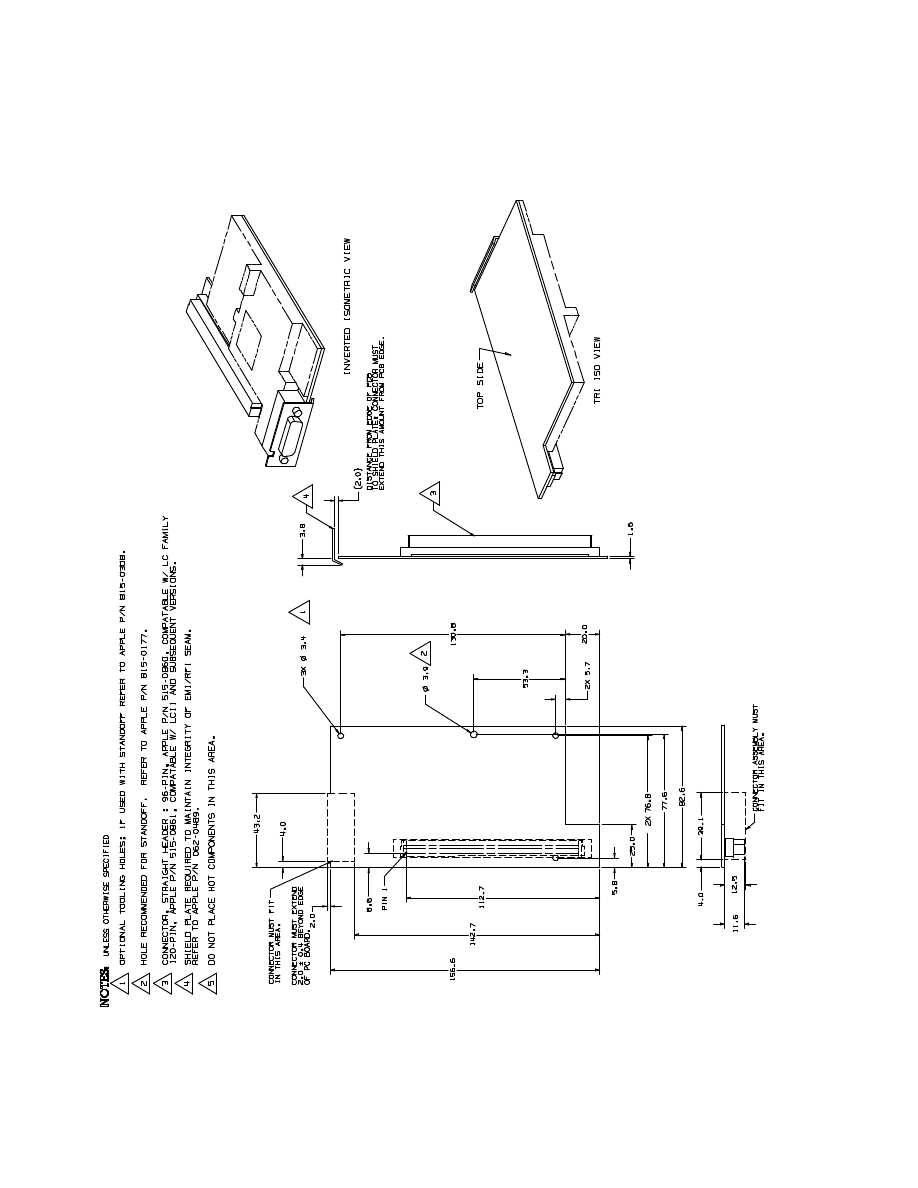
A P P E N D I X
I/O Expansion Card Mechanical Drawings
98
Drawing 1—Expansion card design guide
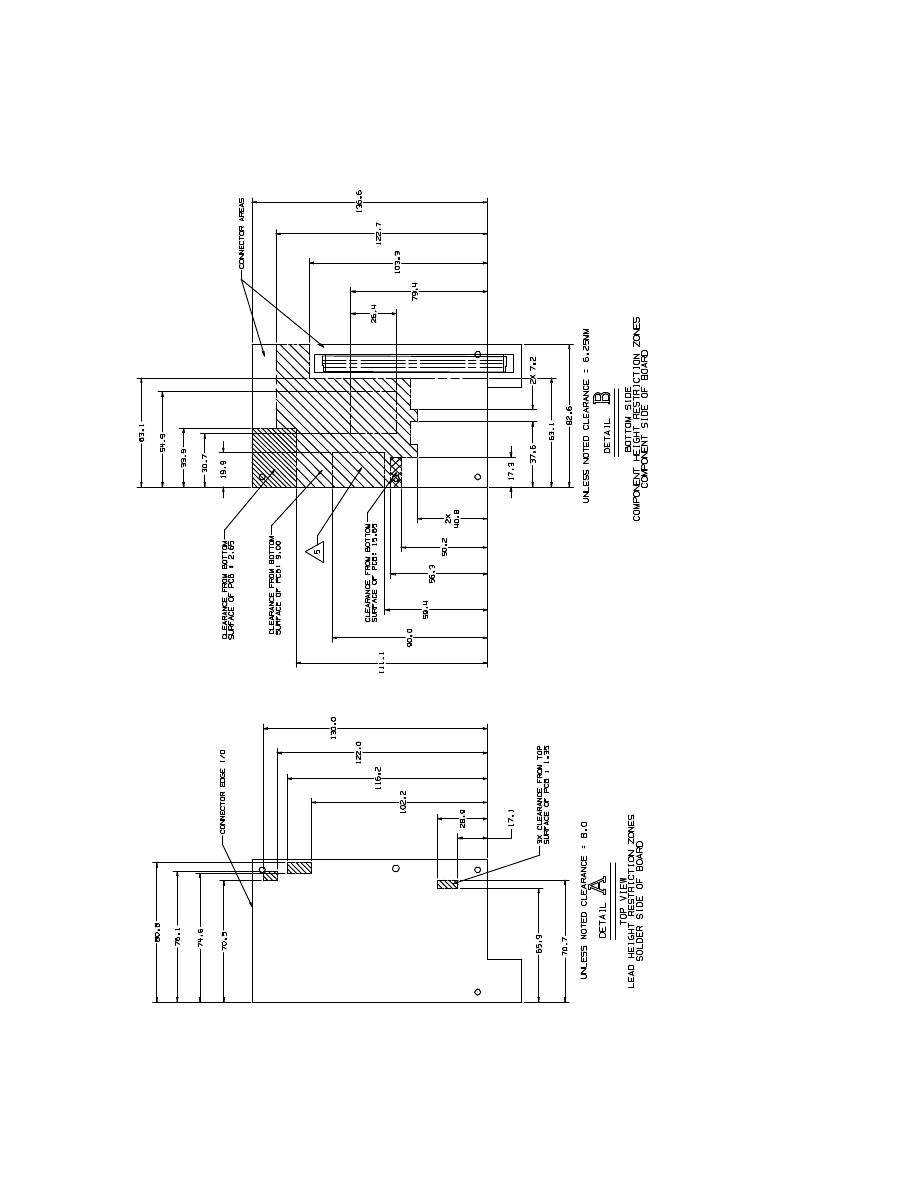
A P P E N D I X
I/O Expansion Card Mechanical Drawings
99
Drawing 2—Expansion card component height restrictions
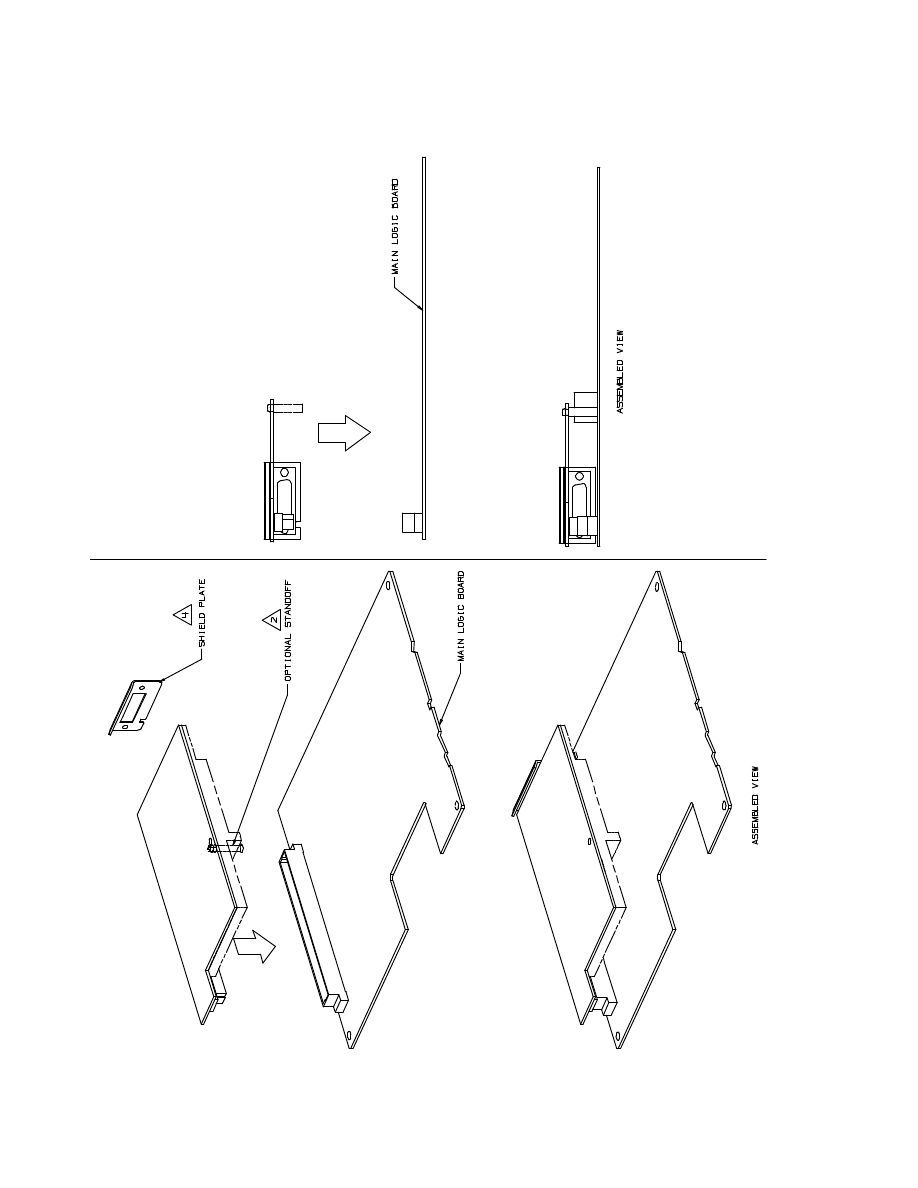
A P P E N D I X
I/O Expansion Card Mechanical Drawings
100
Drawing 3—Expansion card assembly guide

101
Glossary
alignment pragma
This is an instruction to a
C compiler to use a special layout for its data
structures. Typically, Power PC C compilers and
68K compilers use different formats. If you want
to write PPC code that can call 68K code (for
example for an application calling the operating
system) you need to get the compiler to use
68K-style data structures. You do this with an
alignment pragma.
byte lane
An eight-bit channel of a data bridge
that passes individual bytes of data.
chrominance
This is a component of the picture
information you see on your computer monitor.
It contains only the color and no other
information. The other component is luminance.
digital YUV format
YUV is a data format for
each pixel on the color monitor in which color is
encoded by values calculated from the pixel’s
native read, green, and blue components. The
digital YUV format used in the Power Macintosh
5260 computer provides a clearer TV picture than
the RGB format used in the Macintosh Quadra
630 and LC 630 computer. The YUV format
accomplishes this in the way bits are allocated.
The RGB format generally used is a 16-bit format
with 5 bits each for red, green, and blue. The
remaining bit is unused. The YUV format used in
the Power Macintosh 5260 computer is also a
16-bit format, with 8 bits for the Y (luminance)
channel. The U (chrominance) and V channels
share the other 8 bits by multiplexing. The YUV
format looks clearer because it carries more levels
of luminance information.
gamma correction
This is a technique that
adjusts the gamma curve to compensate for the
loss of detail in dark objects displayed on the
computer monitor.
gamma curve
This is the relationship between
color intensity (chrominance) and light
(luminance) displayed on the computer monitor.
With a low gamma curve, colors are washed out.
With a high gamma curve, colors have more
contrast.
luminance
This is a component of the picture
information you see on your computer monitor.
It is responsible for detail, shapes, and shading.
The other component is chrominance.


103
Index
A
abbreviations xii–xiv
AC coupling of sound signals 56
ADB (Apple Desktop Bus)
connector 25
controller 18
ports 4, 25
power requirements 25
address map 20–22
alignment pragmas 11, 101
analog sound signals 56
Apple IIe card incompatibility 20
Apple SuperDrive 26
ATA_Abort
function 88
ATA_BusInquiry
function 85
ATA_DrvrDeregister
function 93
ATA_DrvrRegister
function 92
ATA_ExecIO
function 81
ATA_FindRefNum
function 93
ATA_Identify
function 90
ATA_MgrInquiry
function 84
ATA_NOP
function 88
ATA_QRelease
function 87
ATA_RegAccess
function 89
ATA_ResetBus
function 91
ATA/IDE specification 64
ATA interface 27
ATA Manager 64, 76–95
making calls to 76
parameter block 65
purpose of 65
ATA Manager functions
ATA_Abort
ATA_BusInquiry
ATA_DrvrDeregister
ATA_DrvrRegister
ATA_ExecIO
ATA_FindRefNum
ATA_Identify
ATA_MgrInquiry
ATA_NOP
ATA_QRelease
ATA_RegAccess
ATA_ResetBus
ATA parameter block header 76
ataPBHdr
structure 76–80
audio noise 56
B
back view of computer 6
block diagram 15
branch manager 14
brightness control 3
burst ROM 2
bus arbitration 19
bus masters 19
bus translation logic 14
byte lane 101
byte steering 17
C
cache coherency 11
caches 3, 11, 14, 16
Capella custom IC 14
Capella IC 16
CD ROM drive 2
chrominance 101
clock speed 14
close
routine 67
color lookup table (CLUT) 19
common mode rejection 56
communications cards supported 9
communication slot 4
communications modules 9
communications slot 3, 9, 58
compatibility 10
cache coherency 11
caches 11
data alignment 11
IDE hard disk drive 12
instruction pipelining 10
I/O expansion slot 11
microprocessors 10
PDS cards 11, 52
POWER clean code 10
serialized instructions 10
split caches 11

I N D E X
104
connectors
ADB 25
DVA 54–57
floppy disk 26
hard disk 29
I/O, on I/O expansion card 53
I/O expansion card 53
I/O expansion slot 47
SCSI 31
serial I/O 24
sound input jack 18, 33
sound output jacks 18, 32
video input 8
control buttons 5
controlling screen intensity 5
controlling sound level 5
control
routine 68
Capella IC 16
Cuda 18
DFAC II 18
F108 17
PrimeTime III 17, 49
Valkyrie 19
D
data alignment 11
data cache 14
DAV connector in other computers 55
Device Manager functions 66
DFAC II custom IC 18
differential amplifiers in sound systems 56
digital video scaler IC 57
digital YUV format 7, 101
display memory 19
display RAM 20
DRAM 3, 16
DRAM expansion 3
DRAM SIMMs 2
driverGestalt
parameter block 74
drive status info
function 73
dual caches 14
DVA connector 54–58
comparison with DAV connector 55
on video input module 54
pin assignments 56
video data format 58
dynamic bus sizing 17
E
ejectMedia
function 70
EMI emissions 56
Ethernet card
expansion slot. See I/O expansion slot
external features 4
external SCSI interface 2
external video monitor 36
F
F108 custom IC 14, 17
features summary 2
floppy disk 2
floppy disk connector 26
floppy disk drive 26
format
function 70
frame buffer 2
front view of computer 5
G
gamma correction 101
gamma curve 101
gestaltMachineType
value 62
Gestalt Manager 62
GPi (general purpose input) signal 25
H
hard disk
connector 29
pin assignments 29
signal descriptions 30
dimensions 27
I, J
IDE hard disk device driver 65, 66–76
close
routine 67
control functions 69–76
control
routine 68
Device Manager routines 66–69
driverGestalt
parameter block 74

I N D E X
105
IDE hard disk device driver (continued)
drive status info
function 73
ejectMedia
function 70
format
function 70
killIO
function 69
needTime code
function 72
open
routine 66
power management
function 73
power-mode status
function 75
prime
routine 67
return drive characteristics
function 72
return drive icon
function 71
return driver gestalt
function 74
return media icon
function 71
status
routine 68
verify
function 69
IDE hard disk drive 2, 12, 27
connector 27
pin assignments 29
signal descriptions 30
dimensions 27
interface 27
versus SCSI drive 65
IDE register selectors 90
IDE software
ATA Manager 64, 65
device driver 64
hard disk device driver 65
IDE specification 64
infrared remote control 2, 3
instruction cache 14
instruction pipelining 10
internal bus structure 14
I/O bus 14
I/O expansion card 52–54, 97
address space 21, 53
bus master on 52
card-select signal 54
connector for 53
design guidelines 53
I/O connector on 53
power 53
I/O expansion slot 3, 4, 11, 47–54
compatibility with PDS cards 47, 52
connector 47
MC68030 compatibility 49
pin assignments 47
signal descriptions 49
signal loading 47
support for bus master 52
use of Analog GND pin 47
I/O ports 3
K
keyboard
power key 7
reset and NMI functions 34
killIO
function 69
L
L1 cache 2, 14
L2 cache 2, 16
logic board, access to 6
luminance 101
M
machine identification 62
MakeDataExecutable
function 11
MC68HC05 microcontroller 18
MC68LC040 microprocessor
mechanical drawings, I/O expansion card 97
memory control IC. See F108 custom IC
memory management unit (MMU) 14
microphone 33
microprocessor 2, 3, 14
mirror output 9, 35
modem card 9
modem port 24, 25
monitor 2
N
needTime code
function 72
O
open
routine 66
optional features 7
optional modules
communications 9
TV tuner 7
video display mirror out 9
video input 8

I N D E X
106
P, Q
parallel processing units 14
parameter RAM 18
PDS cards 11
PDS cards, compatibility with 11, 52
PDS slot. See I/O expansion slot
PDS support 3
picture clarity 7
POWER clean code 10
Power key
on keyboard 7
on remote control 7
Power Macintosh 5200 and 6200 3
power management
function 72, 73
power-mode status
function 75
PowerPC 603e microprocessor 2, 3, 14
pragmas, alignment 11, 101
prime
routine 67
PrimeTime III custom IC 14, 17, 49
processor direct slot (PDS) 3
processor speed 3
R
RAM 16
address space 21
configurations 40
expansion 40–46
RAM SIMM 40–46
access time 43
address lines 44
address multiplexing 44
devices 40–44
JEDEC specification for 45
mechanical specifications 45
signal assignments 41–43
sizes 43
remote control 2, 3, 8
return drive characteristics
function 72
return drive icon
function 71
return driver gestalt
function 74
return media icon
function 71
RISC architecture 14
ROM 2
ROM software 62
S
safe shut down 7
SCC circuitry 17
screen buffers 19
SCSI
bus termination 32
connector 31
controller 17
interface 2
SCSI interface 2
second-level cache 16
serial I/O ports 24
serial I/O ports, power requirements 25
serialized instructions 10
SIMMs 16
sound
buffers 18, 34
capabilities 3
circuits in the DFAC II IC 18
control 3
filters 34
input 2, 56
input jack 18, 33
input routing 33
modes of operation 34
output 2
output jacks 18, 32
playthrough feature 34
routing of inputs 33
sample rates 34
sample size 34
stereo 56
split caches 11
standard abbreviations xii–xiv
status
routine 68
stereo sound 56
summary of features 2
system bus 14
system RAM 16
T, U
termination for SCSI bus 32
32-bit addressing 20
TV picture sizes 7
TV receiver 2
TV tuner expansion board 2
TV tuner module 7

I N D E X
107
V, W, X
Valkyrie custom IC 14, 19
verify
function 69
video
buffer board 2
configuration 2
data format 58
input 2, 3
input module 8
DVA connector 54
input connectors 8
input from TV tuner module 8
window size 9
mirror feature 2, 9, 35
mode 2
monitors
external 36
timing parameters 37–38
volume control 3
Y, Z

T H E A P P L E P U B L I S H I N G S Y S T E M
This Apple manual was written, edited,
and composed on a desktop publishing
system using Apple Macintosh computers
and FrameMaker software. Proof pages
and final pages were created on an Apple
LaserWriter Select 360. Line art
was created using Adobe
™
Illustrator.
PostScript
™
, the page-description
language for the LaserWriter, was
developed by Adobe Systems
Incorporated.
Text type is Palatino
®
and display type
is Helvetica
®
. Bullets are ITC Zapf
Dingbats
®
. Some elements, such as
program listings, are set in Apple Courier.
WRITER
Joyce D. Mann
COPY EDITOR
Wendy Krafft
ILLUSTRATOR
Sandee Karr
PRODUCTION EDITOR
Alex Solinski
Acknowledgements to
Prabir Sarkar, Dennis Pak, Rich Schnell,
Kenneth Lee, Ng Buay Hock, and
Jonathan Quinn
Special thanks to Rolly Reed
Document Outline
- Power Macintosh 5260 Computer
- Contents
- Figures, Tables, and Listings
- About This Note
- Introduction to the Power Macintosh 5260 Computer
- Architecture
- I/O Features
- Expansion Features
- Software Features
- Software for the IDE Hard Disk
- I/O Expansion Card Mechanical Drawings
- Glossary
- Index
Wyszukiwarka
Podobne podstrony:
Pro Staff 3 PPC 3H id 392593 Nieznany
5260
Zespół Szkół Rolniczych w Kijanac1 ppc
PPC ziemia 2b
5260
nowe plany ICP IPCH PPC PL mgr Nieznany
5260
zag ppc, Notatki Bezpieczeństwo wewnętrzne, Kardas WSEI
PPC test
5260
5260
5260
04 Zawieranie kontraktuid 5260 ppt
PPC
CZYNNOŚCI PRAWNE PPC
Uruchamiamy PPC na WinUAE
test used to, PS, PC, PP, PPC
więcej podobnych podstron
